

Everest Base Camp Trek Weather and Temperature
- Last Updated on Dec 31, 2023
The Everest Base Camp trek is a very adventurous multiple-day hike in the eastern Himalayas of Nepal. From the starting point of the trail to the highest point, the landscape, terrain, and weather drastically changes. In this blog, you will understand the Everest Base Camp trek weather and temperature. This information will help you decide when to trek here and what to expect in each month.
Learning about the weather and climate along the trail will help you a lot in making the most of your trekking expedition. You will have ample information, which will set the right expectation benchmark for you. You will not be surprised even if the weather suddenly changes, and ultimately, it will not ruin your mood because you know it's inevitable.
The Everest Base Camp trek starts from Kathmandu at 1,400 meters (4,593 ft). From here, you will take a 30 to 35-minute flight to Lukla and ascend to Everest Base Camp at 5,364 meters (17,598 ft) and Kala Patthar at 5,545 meters (18,192 ft). This elevation change also brings changes in climate, vegetation, and weather. As the blog unfolds, you will learn the month-by-month breakdown of the weather and temperature in the Everest region.
Check out our Everest Base Camp trek cost blog for in-depth information on the money needed for this trek.

Everest Base Camp Trek

Everest Base Camp Trek Return By Helicopter

Everest High Pass Trek
Table of contents, everest base camp trek weather and temperature by month.
Month-by-month breakdown of the weather and temperature in the Everest region
Everest Base Camp weather and temperature in January
- Temperature : The daytime temperature usually reaches a maximum of 4°C, while during the night, the temperature drops to around -17°C.
- Estimated hours of daylight : In January, the daylight hours range from 5 to 7, so you have to start trekking early in the morning.
- Wind : The average daily wind speed is roughly 12-19 km/hr (about 8-12 mph).
January is the middle of the winter and one of the coldest times in the Everest region. The daylight hours are short, ranging from 5 to 7 hours in the upper part of the region. During the daytime, the temperature ranges around 6°C and can drop below -20°C by midnight/early morning. Snowfall is common, and some lodges in the upper part of the trail get closed.

Trekking to Everest base camp in January!
Likewise, the mornings are frequently shrouded by fog, but by the afternoon the sunrises, making the region brighter and the mountain views excellent. Somedays can be gloomy with no clear sky. The air is cold and crisp. If the day is clear, you will get to witness the best mountain panoramas as the mountains are covered by snow.
In January, there is no crowd. Moreover, the Everest Base Camp trail is almost empty, so trekking can become quite therapeutic with adventurous walks and tranquility. The lodges offer discounted accommodations and meals.
But with all these perks also comes the challenge of cold weather in January. You have to be well-packed and prepared for the trek. Good-quality down jackets, thermal innerwear, warm gloves/socks, hats, and high-quality sleeping bags are essentials. Even with all the challenges, January can be quite a lovely time to do Everest Base Camp trekking for experienced trekkers.
Everest Base Camp weather and temperature in February
- Temperature: The temperature ranges around 4°C during the daytime and drops below -14°C in the night.
- Estimated hours of daylight: In February, the daylight hours range from 6 to 7, so you have to start trekking early in the morning.
- Wind: The average daily wind speed in February is around 12-19 km/hr (around 8-12 mph).
February is the last month of the winter season. Like January, the weather remains extremely cold, with frequent snowfall and short daylight hours. However, as the days pass by, the climate gradually begins to warm up, and by the end of February, the daylight hours also increase. During the daytime, the temperature ranges around 8°C in the lower altitudes, whereas the nighttime is still extremely cold, with the temperature dropping to -15°C.
February also sees empty trails. If you love solitude and want to experience the serenity of the Everest region, February is another great time for trekking. The mountains are all covered with blankets of white snow, and on clear days, the views are just out of this world. Not many trekkers have seen the Everest region's winter beauty. It is incredible and will take your breath away.

Trekkers trekking to Everest base camp in february!
As the winter is also at its peak in February, you have to pack well for the trek. High-quality insulating clothes, thermal wear, and sleeping bags are essential. Likewise, you will also need a trekking boot that has a good grip on snow. As February comes to an end, the landscape gradually begins to change. You can see life back in the lower parts of the trail.
If you are planning to do the Everest Base Camp trek in the winter season, you have to be strong physically and mentally. Winter demands a lot more than any other trekking season. It will test your endurance, patience, and determination. So, be well prepared.
Everest Base Camp weather and temperature in March
- Temperature: The temperature ranges around 7°C during the daytime and drops below -12°C in the night.
- Estimated hours of daylight: In March, the average daylight hour is 7.
- Wind: The average daily wind speed in March is around 15 km/hr (around 9 mph).
March is the beginning of the spring season, the transitional time in the Himalayas, and also the start of one of the peak trekking seasons. The climate slowly begins to warm up and the weather also gets stable. The average daily temperature is -2°C to 7°C during the daytime and -12°C at night. The daylight hours begin to rise, and the mountain views are much more clear with the bright sky.
The trekkers return to the region. All the lodges are ready to serve them. Gradually, the trail to Everest Base Camp begins to bustle with laughter and joy. Hundreds and thousands of flowers decorate the lower parts of the trail, especially rhododendrons. The leaves are back on the trees, and the streams and waterfalls start to unfreeze.
As the month progresses, the valleys and passes begin to melt as well, making the trails accessible once again. The cold is still there but not as intense as in February. There could be occasional snowfall in March, which indicates that the season is changing. If you wish to do the EBC trek in peak season but avoid the crowd, thendo the Everest Base Camp trek at the start of March . The trails are still serene, with only a handful of trekkers.
Everest Base Camp weather and temperature in April
- Temperature: The temperature ranges around 10°C during the daytime and drops below -5°C in the night. The daytime gets warm, so dress in layers and remove them as needed.
- Estimated hours of daylight: In April, the average daylight hour is 7 to 8.
- Wind: The average daily wind speed in April is around 15 km/hr (around 9 mph).
April is the peak of the spring season. It is one of the best times to do the Everest Base Camp trekking because of the stable weather and moderate climate. The trekking route all around the Everest region and other parts of the Himalayas sees a bustle of travelers from all around the world. The daylight hours range from 7 to 8, and the sky remains mostly bright and clear.

Reaching the Everest base camp in April!
In April, the temperature ranges from 10°C to -5°C. The nights and mornings are on the cold side, whereas the daytime has a moderate climate- neither too hot nor too cold. The lower parts of the trails are full bloomed with rhododendron and magnolia. You can see rivers, streams, and waterfalls, almost back to life. The landscapes are clear and stunning.
With the beginning of April, the Lukla flights are also mostly on time. There are fewer delays and a rare chance of flight cancellation. With better weather conditions, you can trek in the Everest region without having a contingency day in your itinerary. Likewise, if you love birds, then April is a great time as various bird species migrate to the region.
By April, the EBC trail will be packed with travelers. While packing for the trek, make sure to bring some warm pieces, too. Focus on layering!
Everest Base Camp weather and temperature in May
- Temperature: The temperature ranges around 20°C during the daytime and drops to around -10°C at night. The daytime gets warm, so dress in layers and remove them as needed.
- Estimated hours of daylight: In May, the average daylight hour is 7 to 8.
- Wind: The average daily wind speed in May is around 15 km/hr (around 9 mph).
May is the last month of spring. It is also the best time to climb mountains in the Himalayas. The excellent weather conditions in the month make trekking to the Everest Base Camp spectacular. The temperatures are relatively mild, with daytime averages at the base camp ranging between -2°C to -5°C. The nights can get colder, reaching around -10°C. Likewise, the temperature can reach up to 20°C in the lower part of the trail during the daytime.

Outfitter Himalaya trekking group reached everest base camp in May!
As May is the last month of the spring, the crowd is relatively low. Most trekkers have already left the EBC trail or are on the return journey to Lukla. However, you will see many mountaineers at the base camp. The landscape in May is surreal and adorned with the beauty of blooming rhododendron flowers at lower altitudes. Likewise, the upper part of the trail boasts barren, rocky sceneries.
The trail is in the best condition. As the next season is monsoon, there could be occasional rainfall in lower elevations, signaling the change in season. With the right preparation, including proper acclimatization, suitable gear, and pre-arranged accommodations, trekking to Everest Base Camp in May promises an unforgettable experience.
Everest Base Camp weather and temperature in June
- Temperature: The temperature ranges around 25°C during the daytime and drops to around 0°C at night. The weather is quite unstable, so you need to pack all kinds of clothing, including warm, waterproof, and light, breathable.
- Estimated hours of daylight: In June, the average daylight hour is 11 per day. This month has longer daytime and shorter nighttimes.
- Wind: The average daily wind speed in June is around 16 km/hr (around 9 mph). The morning and evening times are usually chilly in the higher regions.
June marks the beginning of the summer/monsoon season. It brings unpredictable weather and gloomy days. The Lukla flights may not be on time most of the time, so contingency days are important in the itinerary. Even though it is the start of monsoon season, the full impact may not hit the region. So, if you plan well, you can do the EBC trek in June.
The daytime temperature ranges from 25°C to 15°C in different elevations. During the night, the temperature ranges between 0°C to 8°C. While there's a potential for some rain, cloudy sky, and reduced visibility, these factors do not significantly hinder the trek. Trails may become slightly muddy, but they remain navigable, adding a touch of adventure to the journey.

The Himalaya view in Everest in June!
As June is the start of another off-trekking season in Nepal, the number of trekkers decreases significantly, making the trails around the Himalayas almost empty. This creates a more intimate and tranquil experience with nature, allowing you to appreciate the beauty of the Everest region without the crowds.
The monsoon rains bring a refreshing touch to the flora, transforming the landscape into lush, green surroundings. Despite the wet conditions, the overall trekking experience is enhanced by the vibrant colors and rejuvenated environment. You have to pack waterproof clothing for trekking in June.
Everest Base Camp weather and temperature in July
- Temperature: The temperature ranges around 32°C during the daytime in lower elevations and drops to around 0°C at night around EBC. The weather is unstable, and you need to pack all kinds of clothing, including warm, waterproof, and breathable.
- Estimated hours of daylight: In July, the average daylight hour is 7 to 8 per day.
- Wind: The average daily wind speed in July is around 16 km/hr (around 9 mph). The humidity is high as well.
July is the peak of the monsoon season in Nepal. The lower part of the trail is in its poorest condition during this month because of heavy rainfall. The trails are muddy and slippery, and some sections have leeches as well. Most hilly areas are on high alert for landslides, including the trekking routes. Likewise, the rivers, streams, and waterfalls are raging with rainwater.

EBC weather in July!
Expect frequent rainfall, which can vary from drizzles to heavy downpours. Despite being summer, temperatures are still relatively cool at higher altitudes. Around Everest Base Camp, temperatures range from 10°C during the day to -5°C at night. Likewise, the lower elevation has higher temperature. The humidity is at its peak this month, and the clouds block the views often.
July is not an ideal time for Everest Base Camp trekking because of elevated weather challenges. However, the trails are empty, and the prices of accommodation and meals are low along the way. Some tea houses may close during the monsoon season. Likewise, flight delays and cancellations to and from Lukla are more common.
Everest Base Camp weather and temperature in August
- Temperature: The temperature ranges around 30°C during the daytime in lower elevations and drops to around -1°C at night around EBC. The weather is unstable, and you need to pack all kinds of clothing, including warm, waterproof, and breathable.
- Estimated hours of daylight: In August, the average daylight hour is 6 to 7 per day.
- Wind: The average daily wind speed in August is around 16 km/hr (around 9 mph). The humidity is high as well.
August is the last month of the summer/monsoon season. The weather is similar to in July with heavy regular rainfalls and cloudy days. The trails are muddy and slippery due to rainfall. Trekking can be more challenging during this time, and proper footwear with good traction is essential. Likewise, the risk of landslides remains, particularly in areas with steep terrain.
The humidity is also quite high, and the temperature ranges from 15°C to -1°C. On days with no rainfall, the temperature rises above 30°C in the lower part of the trails. As the weather is unpredictable in August, you will come across fog, gloomy days, heavy downpours, drizzles, and occasional bright, clear days.

Everest Base camp weather in August!
While there may be breaks in the weather, the overall visibility of the Himalayan peaks might still be limited, and clear views are not guaranteed. August is the last month of the off-season, and there are fewer trekkers on the trail. If you appreciate a quieter experience and are prepared for challenging conditions, you may consider trekking to EBC in August.
Everest Base Camp weather and temperature in September
- Temperature: The temperature ranges around 20°C during the daytime and drops to around -5°C at night around EBC. The weather gradually gets stable.
- Estimated hours of daylight: In September, the average daylight hour is 7 to 8 per day.
- Wind: The average daily wind speed in September is around 8-11 km/hr (around 5-7 mph).
September starts the final peak trekking season of the year in Nepal. September is a transitional month, so you will see a mixed weather pattern. The weather begins to transition into clearer skies and more stable conditions. There could be occasional rainfall till the second of this month. Gradually, the climate begins to get cold with crisp air. The trekkers return to the trails.

Trekkers at Everest base camp in September!
The first two weeks of September see empty trails, so it is the best time to do the Everest Base Camp trek if you wish to escape the crowd of peak season. Trails start to dry up as the monsoon subsides, reducing the mud and slipperiness. However, some sections might still be wet, so good trekking shoes are essential. With the decrease in rainfall and clearing skies, September provides better opportunities for clear views of the Himalayan mountains.
Daytime temperatures range from 10°C to 20°C, offering a comfortable trekking environment. Nighttime temperatures may still drop between -1°C to -5°C, especially at higher altitudes. There is a good balance between the end of the monsoon season and the onset of colder winter weather. By the end of September, the weather gets stable, making it easier to trek and enjoy the scenic landscapes.
Everest Base Camp weather and temperature in October
- Temperature: The temperature ranges around 10°C to 20°C.
- Estimated hours of daylight: In October, the average daylight hour is 8 to 9 per day.
- Wind: The average daily wind speed in October is around 8-11 km/hr (around 5-7 mph). The humidity is high as well.
October is the best time to do the Everest Base Camp trek. The trail is crowded with trekkers from all around the world. The environment is joyful and lovely. Likewise, the mountain views are breathtaking and clear. The monsoon rain clears the sky, making the air quite refreshing, and there is a very soothing hint of coldness in the climate. The weather remains dry and stable, perfect for trekking.

Clear weather in Everest Base camp in October!
The trails are almost dried up, reducing the chances of mud and slippery conditions. The daytime temperatures in October range from 10°C to 20°C at lower altitudes. Likewise, nighttime temperatures may still be chilly, especially at higher elevations. The autumn season brings vibrant colors to the landscapes.
As October is a popular month for trekking, accommodations along the trail can fill up quickly, so you have to make early bookings. The EBC trek in October may coincide with Dashain, the biggest festival in Nepal. This adds a cultural dimension to the overall trekking experience. While daytime temperatures are moderate, it's essential to pack layers for varying temperatures.
Everest Base Camp weather and temperature in November
- Temperature: The temperature ranges around 18°C during the daytime in lower elevations and drops to around -10°C at night around EBC.
- Estimated hours of daylight: In November, the average daylight hour is 7 to 8 per day.
- Wind: The average daily wind speed in November is around 8-13 km/hr (around 5-8 mph). The humidity is high as well.
November is the last month in the autumn season and also brings the hint of winter by the middle of the month. This month is also a peak time for trekking in the Everest region due to favorable weather conditions. The sky remains clear with dry weather and moderate humidity. The daylight hours are also good, ranging from 7 to 8.

View of Everest Base camp in November!
EBC Trek in November offers some of the best mountain views of the entire year. The skies are clear, and visibility is excellent. In November, you'll witness the autumn foliage, with colorful leaves on trees like rhododendrons. The landscapes are vibrant, adding to the scenic beauty of the trek.
The daytime temperatures at lower altitudes range from 6°C to 18°C, and nighttime temperatures can drop around -10°C in the upper part of the trail. The crowd gradually begins to lower, offering a tranquil environment once again. Although November is less crowded than October, it's still a popular month for trekking, so booking teahouse accommodations in advance is recommended.
Everest Base Camp weather and temperature in December
- Temperature: Throughout December, daytime temperatures will generally be around 4°C to 12°C. At night, the average minimum temperatures drop down to around -14°C.
- Estimated hours of daylight: In November, the average daylight hour is 5 to 7 per day.
- Wind: The average daily wind speed in November is around 12-19 km/hr (around 8-12 mph). The humidity is high as well.
December starts the long, dark winter in the Himalayas. The weather begins to get quite unpredictable, and the cold rises. You can still do the EBC trek in December; however the Lukla flight may begin to see a lot more delays than in November. The possibility of snowfall is high at upper elevations.

Everest Base camp weather in December!
Trails can be covered with snow and ice, especially as you ascend to higher altitudes. This can make trekking more challenging, and proper gear, such as trekking poles and crampons, may be necessary. December offers clear skies, providing good visibility of the snow-covered landscapes, but the unstable weather may disrupt the views on some days.
Most of the vegetation has shed its leaves, and the landscapes may appear more barren compared to other seasons. The daytime temperatures at lower altitudes can range from 4°C to 12°C, but temperatures drop significantly at upper altitudes (-14°C). With fewer trekkers on the trail, you can enjoy a more peaceful and serene trekking experience.

Arjun Rijal
Hello, Hi & Namaste from the Himalayas !!!
I am Arjun Rijal, Founder Director of the Outfitter Himalaya Holidays P. Ltd & working as a travel planner/consultant for Nepal, Bhutan, and Tibet Travel. I love hiking, trekking, and traveling.
I have been in most of the trekking regions in Nepal, that include Everest Base Camp , Annapurna Base camp , Annapurna Circuit , Manaslu , and Langtang . I also have travelled to Bhutan , India & planning further travel to many other countries in the world.
Find my writing on traveling, trekking, tours, travel news, and updates about the tourism activities of Nepal, Tibet & Bhutan.
You can also follow me on social media to receive regular news and updates.
- Trip Advisor
Drop us a message
Recent posts.
- Annapurna Circuit Trek Weather and Temperature
- Deluxe Hotels in Chitwan
- Standard Hotels in Chitwan
- Deluxe Hotels in Pokhara
- Standard Hotels in Pokhara
- Deluxe Hotels in Kathmandu
Related Posts
- Annapurna Travel Guide
- Bhutan Travel Guide
- Everest Travel Guide
- Kathmandu Travel Guide
- Langtang Travel Guide
- Manaslu Travel Guide
- Nepal Travel Guide
- News and Updates
- Places to Stay in Nepal
- Pokhara Travel Guide
- Tibet Travel Guide
We use cookies to ensure that we give you the best experience on our website.
No recent searches!
Luxury Trekking in Nepal
- Luxury Everest Base Camp Heli Trek - 9 Days
Luxury Everest View Trek
Luxury Everest Base Camp Trek
- Luxury Nepal Tour with Dhampus Sarangkot Trek
- Annapurna in Luxury – 11 Days
- Upper Mustang Heli Trek with Luxury Accommodations in Kathmandu and Pokhara
VVIP Everest Base Camp Luxury Trek
- Ghorepani Poon Hill Luxury Trekking with optional Chitwan safari
Everest Base Camp and Gokyo Lakes Luxury Helicopter Trek
Luxury Everest Base Camp Trek - 14 Days
- Luxury Trekking in Nepal with Pokhara and Dhulikhel
Everest Region Trekking
Everest Base Camp Trek
- Everest Base Camp Heli Trek with Kala Pathher Fly Over
- Everest Base Camp Trek with Helicopter flight from Kalapathar to Lukla
Gokyo Lakes and Everest Base Camp Trek
Gokyo Lakes and Gokyo Ri Trek
Annapurna Region Trekking
- Annapurna Base Camp Trek
- Annapurna Base Camp Trek - 10 Days
- Ghorepani Poon Hill Trek
- Mardi Himal Trek
- Kathmandu and Pokhara Luxury Tour with Dhampus Sarangkot Trek
- Ghorepani Poon Hill Sunrise Trek with Chitwan Jungle Safari
- Annapurna Circuit Trek
- Luxury Nepal Tour with Trek, Safari and Rafting
Luxury Trekking in the Everest Region
- Everest View Luxury Heli Trek
- Everest Base Camp Short Heli Trek 5 Days
- Everest Base Camp Helicopter Trek - All flight by Heli
- Premium Everest Base Camp Heli Trek
Everest Base Camp Trek with Helicopter Return
Manaslu region trekking.
- Manaslu Circuit Trek
- Tsum Valley Manaslu Circuit Trek
- Manaslu Circuit Helicopter Return Trek
Langtang Region Trekking
- Langtang Valley Trek
- Langtang Valley Heli Trek
Luxury Tours in Nepal
- Luxury Nepal Tour with Everest Scenic Flight
- Luxury Tour in Nepal: A 9-Day Journey through Kathmandu, Lumbini, Pokhara, and Chitwan
- Everest Base Camp Helicopter with Kathmandu and Pokhara Luxury Tour
- Everest Helicopter with Luxury Nepal Tour
- Everest Heli with Luxury Kathmandu, Pokhara and birthplace of Buddha
- Kathmandu and Chitwan Luxury Tour with Dhulikhel
- Family Tour in Nepal
- Honeymoon in Nepal
- Destination Wedding in Nepal - All Inclusive
- Luxury Nepal Tour with Everest Scenic flight - 6 Days
Best Selling Nepal Tours
- Luxury Nepal Tour with optional Chitwan, Pokhara and Lumbini
- Golden Triangle Nepal Tour (Kathmandu, Chitwan and Pokhara)
- Luxury Nepal Tour with Everest Landing Helicopter tour
- A adventure sports tour in Nepal
- A adventure sports tour in Nepal with Rafting, Jungle Safari and Mountain Flight
- 2 Days Nepal Tour with Nagarkot
- 3 Days Nepal Tour with Nagarkot
- 4 days Nepal tour with Pokhara
- 5 days Nepal tour with Pokhara and Chitwan Safari
Nepal's Most Popular Tours
- Discover the Splendor of Nepal: An Unforgettable 7-Day Luxury Journey
- The Ultimate 5 Nights 6 Days Luxury Nepal - Discover the Splendor of the Himalayas
- Discover the Heart of Nepal: 4 Nights 5 Days Nepal Luxury Tour Package
- Nepal Luxury Escape
- 9 Days Nepal tour with Pokhara, Lumbini and Safari
- 8 Days Nepal tour with Pokhara, Rafting and Safari
- 7 days Nepal Tour with rafting and safari
- 6 days Nepal tour with Pokhara and Safari
Cultural and Historical Tours
- Kathmandu Luxury Tour with the sunrise view from Nagarkot - 5 Days
- Nepal and Tibet cultural sightseeing Tour
- Nepal Family Tour
6000 M Peaks
- Mt Ama Dablam Expedition (6,812 m)
- Island Peak Expedition (6,160 m)
- Mera Peak Climbing (6,476 m)
- Chulu West Peak Climbing (6,419 m)
- Pisang Peak Climbing (6,091 m)
- Singu Chuli Peak Climbing (6,501 m)
- Island Peak Climbing with Everest Base Camp Trek
- Lobuche Peak Climbing with Everest Base Camp
8000 M Peaks
- Makalu Expedition (8,463m)
- Mt Everest Expedition (8848.86 m)
- Manaslu Expedition (8,163 m)
- Dhaulagiri Expedition (8,167 m)
- Kanchenjunga Expedition (8,586 m)
- Lhotse Expedition (8,516 m)
7000 M Peaks
- Gangapurna Expedition (7,455 m)
- Pumori Expedition (7,145 m)
- Tilicho Peak Expedition (7,134 m)
- Annapurna South Expedition (7,219 m)
- Annapurna Base camp Helicopter landing tour
- Kathmandu Sightseeing tour by Helicopter
- Langtang Helicopter tour
- Upper Mustang Helicopter Tour
- Mardi Himal Helicopter Tour from Pokhara
- Gosaikunda Helicopter Tour
- Everest Base Camp and Gokyo Landing Helicopter Tour
- Everest View Helicopter Tour from Hotel Everest View
- Everest Helicopter Landing Tour with Breakfast - All Inclusive
- Everest Scenic Flight by Plane with Hotel Pickup
- Everest Base Camp Helicopter tour with landing from Kathmandu
- Seven World Heritage Day Tour of Kathmandu Valley
- Private Tour Nagarkot Sunrise View and Day Hiking from Kathmandu
- Private Kathmandu Sightseeing Tour - UNESCO 4 World Heritage Sites
- Private Full-Day Tour With Nagarkot Sunrise and Bhaktapur From Kathmandu
- Chandragiri Cable Car Tour in Kathmandu - Private Half Day Tour
- Best Bhutan Tour 4 Days
- A Seven Day Majestic Bhutan Tour
- Majestic Bhutan: A Seven Day Luxury Bhutan Tour
- Bhutan Magical Tour - 5 Days
- Golden Triangle Bhutan Tour - 6 Days
- Dagala Thousand Lakes Trek - 6 Days
- 2 Nights 3 Days Bhutan Tour: A Glimpse into the Last Shangri-La
- Golden Triangle India Tour with Holy city Varanasi
- Golden Triangle India Tour of Delhi, Jaipur and Agra
- Luxury Dubai Tour with Burj Al Arab
- Best of Dubai Tour - 7 Days
- Tibet Cultural Tour - 8 Days
- Nepal - Bhutan
- Nepal - Tibet
- Nepal - India
- Nepal - Bhutan - Tibet
- Nepal - Bhutan - India
- Everest Base Camp Helicopter Tour & Kathmandu Cultural Tour - 4 Days
- Luxury Nepal Tour with Bardiya National Park Safari
- Make a Payment
- LHN & Responsible Tourism
- Core Values
- Fleets of LHN
- Refund & Cancellation policy
- Terms & Conditions
- Why Luxury Holidays?
- Best low price guaranteed
- Legal Documents
- How to Book a Trip
- Work with us

Everest Base Camp Trek Month Wise: Weather and Temperature

- Aug 3rd 2023
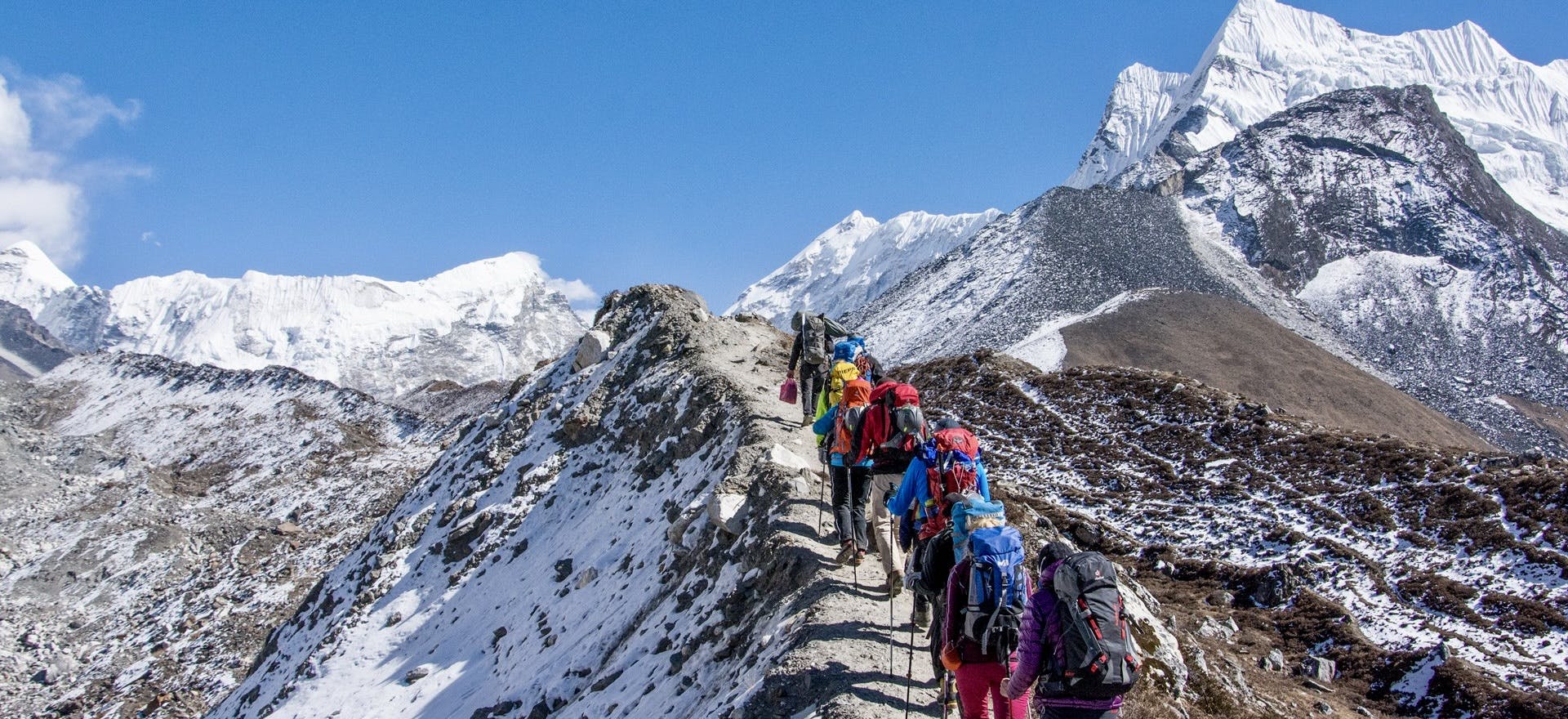
The Everest Base Camp Trek is a thrilling journey that attracts adventure enthusiasts from around the globe. Spanning across some of the highest altitudes in the world, this trek offers breathtaking views, cultural insights, and a sense of accomplishment. But to make the most of your trekking experience, it's crucial to plan your trip around the weather conditions and temperatures in the region.
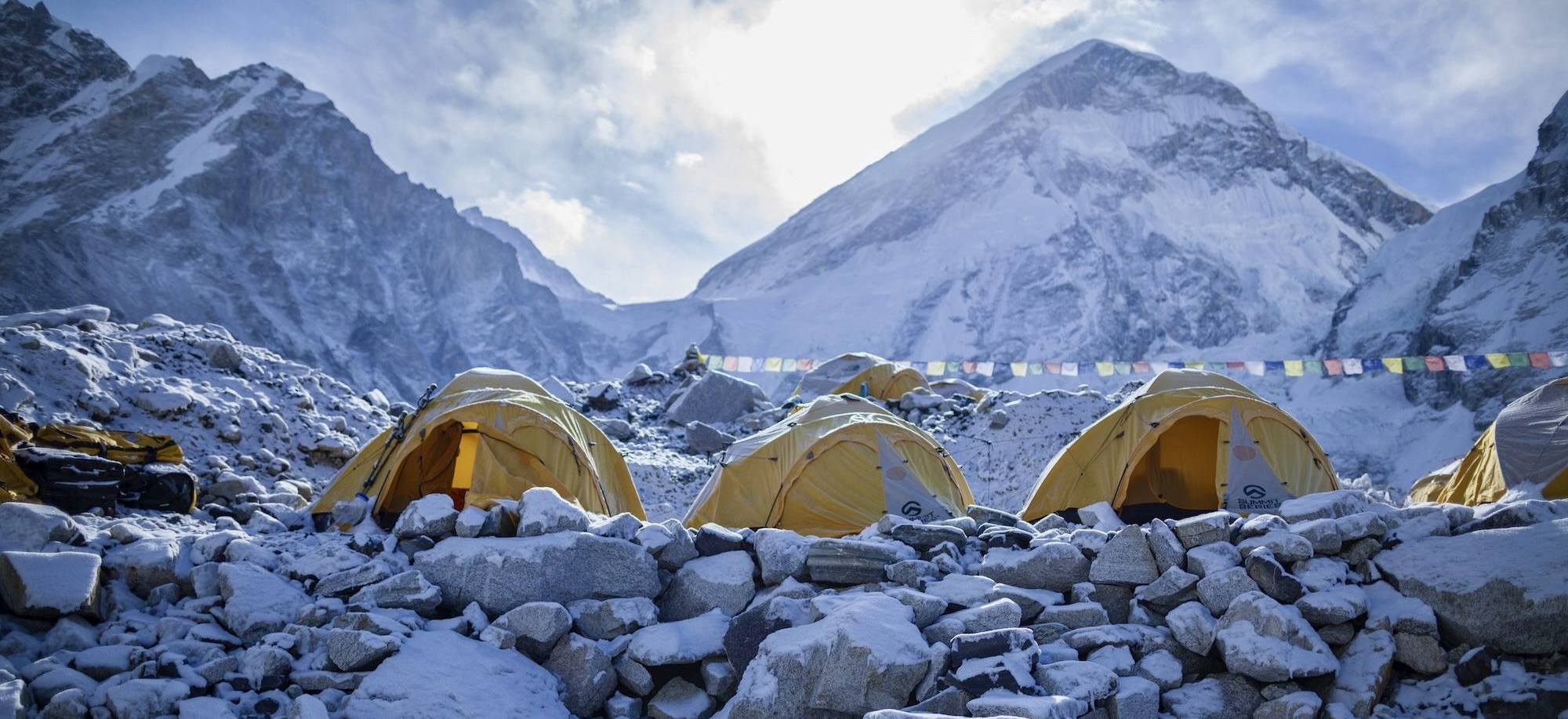
As the Everest Base Camp lies at an elevation of about 5,364 meters (17,598 feet), the weather can vary drastically depending on the time of the year. Therefore, understanding the monthly weather patterns and temperature fluctuations at Everest Base Camp can greatly enhance your trekking experience.
This guide provides a month-by-month breakdown of the weather and temperature during the Everest Base Camp Trek, helping you to choose the best time for your trek and what to expect during each season. From the crisp and clear days of autumn, the snow-filled paths of winter, the blossoming beauty of spring, to the lush green landscapes of monsoon, each month brings a unique flavor to this journey. Let's delve into the details and help you plan your trek efficiently.
January: The Coldest Month
January is considered the middle of winter in the Everest region, and it is indeed one of the coldest months. Day temperatures at lower elevations hover around 6°C (42.8°F), but they drop significantly as you gain altitude, and nights can be much colder. At the base camp itself, night-time temperatures can drop as low as -20°C (-4°F) or even lower.
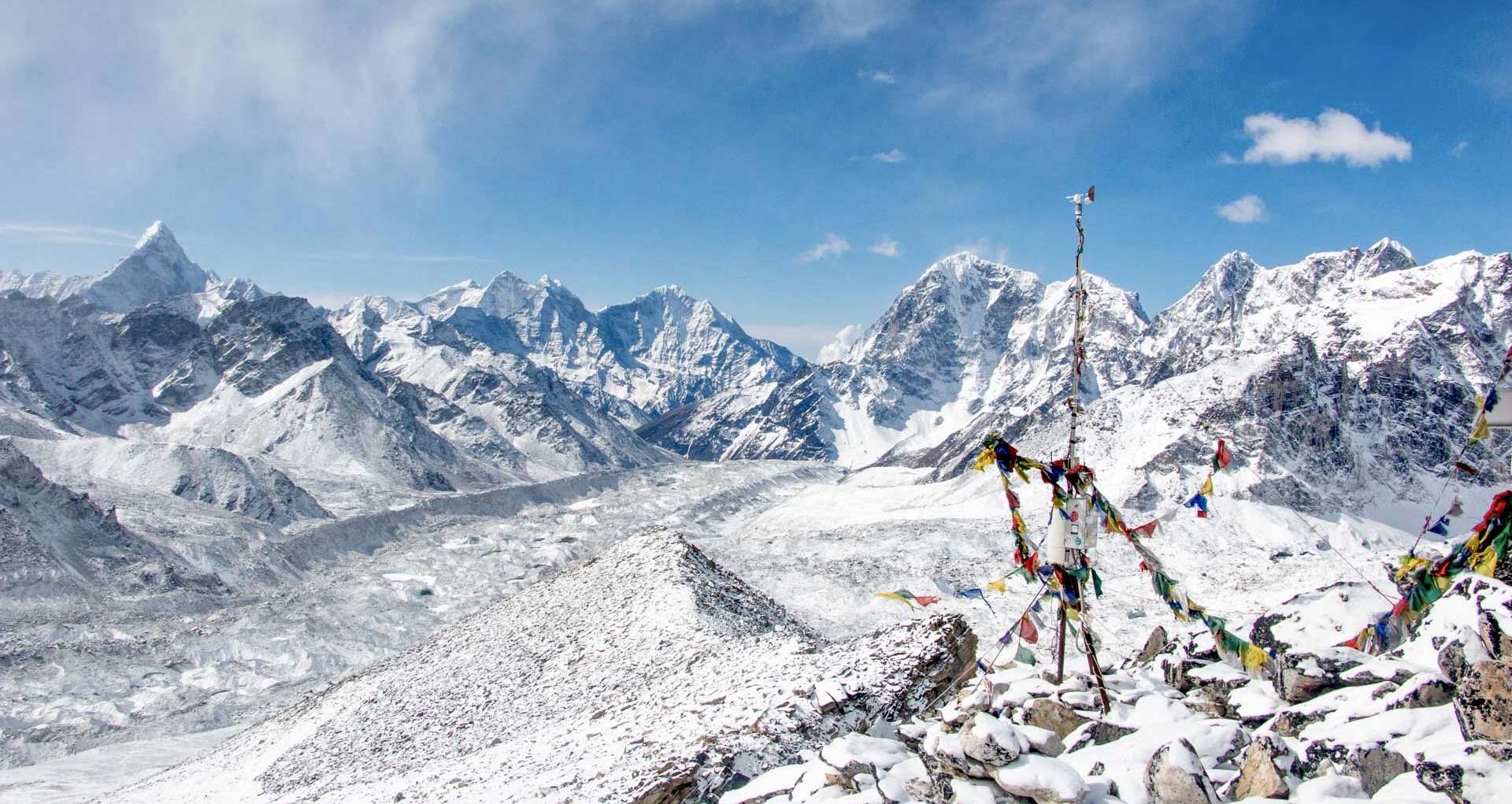
Snowfall is common, especially at higher elevations, which can lead to trail closures or diversions. However, on days when the skies are clear, which is often the case, the mountain views are nothing short of spectacular. The air is crisp and the visibility is excellent, providing some of the best mountain vistas you'll see all year.
Another advantage of trekking in January is the lack of crowds. Unlike the peak trekking seasons in the spring (March-May) and autumn (September-November), the trails are much less crowded in January. This means you'll often find yourself in solitude, surrounded by the quiet beauty of the Himalayas.
Moreover, tea houses and lodges along the trail are less likely to be fully booked, so finding accommodation is rarely an issue. Many tea houses offer rooms for free, expecting you to dine with them.
However, trekking in January does require a high level of preparation. It is essential to bring warm clothing and gear to protect against the severe cold, especially at night. Items like a good quality down jacket, thermal innerwear, warm gloves, and a hat are must-haves.
In conclusion, while January presents more challenging conditions, it can be a great time for experienced trekkers who are well-prepared and looking for a quieter, more solitary trekking experience.
February: The End of Winter
February marks the tail end of winter in the Everest region. Similar to January, the weather is cold, and snowfall is common, especially at higher altitudes. However, as the month progresses, the intensity of the cold starts to lessen gradually.
During the day, temperatures at lower altitudes can reach up to 8°C (46.4°F). At higher altitudes and at Everest Base Camp itself, the daytime temperatures can still be below freezing, and night-time temperatures can drop down to -15°C (5°F) or lower.
Like January, February is a quiet month on the trails. The winter solitude continues to offer trekkers the opportunity to enjoy the beauty of the Everest region without the crowds. The snow-capped landscape provides stunning views, and on clear days, you'll experience some breathtaking vistas of the Himalayas.
However, because February is still a winter month, it is essential to pack suitable clothing and equipment. Good quality warm clothing, thermal underwear, and good sleeping bags are necessary. Hiking boots with good grip are crucial as the trails can be slippery due to the snow.
Towards the end of February, the signs of spring start to appear, the snow begins to melt, and the rhododendrons start to bloom, adding a touch of color to the otherwise white landscape.
Despite the cold, February can be a great month for the Everest Base Camp trek if you're well-prepared and prefer a quieter trekking experience. Do note that winter trekking requires a higher level of experience and preparation compared to other times of the year.
March: The Start of Spring
March marks the onset of spring in the Everest region. The weather begins to warm up slightly compared to the freezing temperatures of winter. The average daytime temperature at the base camp during March can range from -2 to -8 degrees Celsius (28.4 to 17.6 degrees Fahrenheit). At night, temperatures can dip down to -12 degrees Celsius (10.4 degrees Fahrenheit).
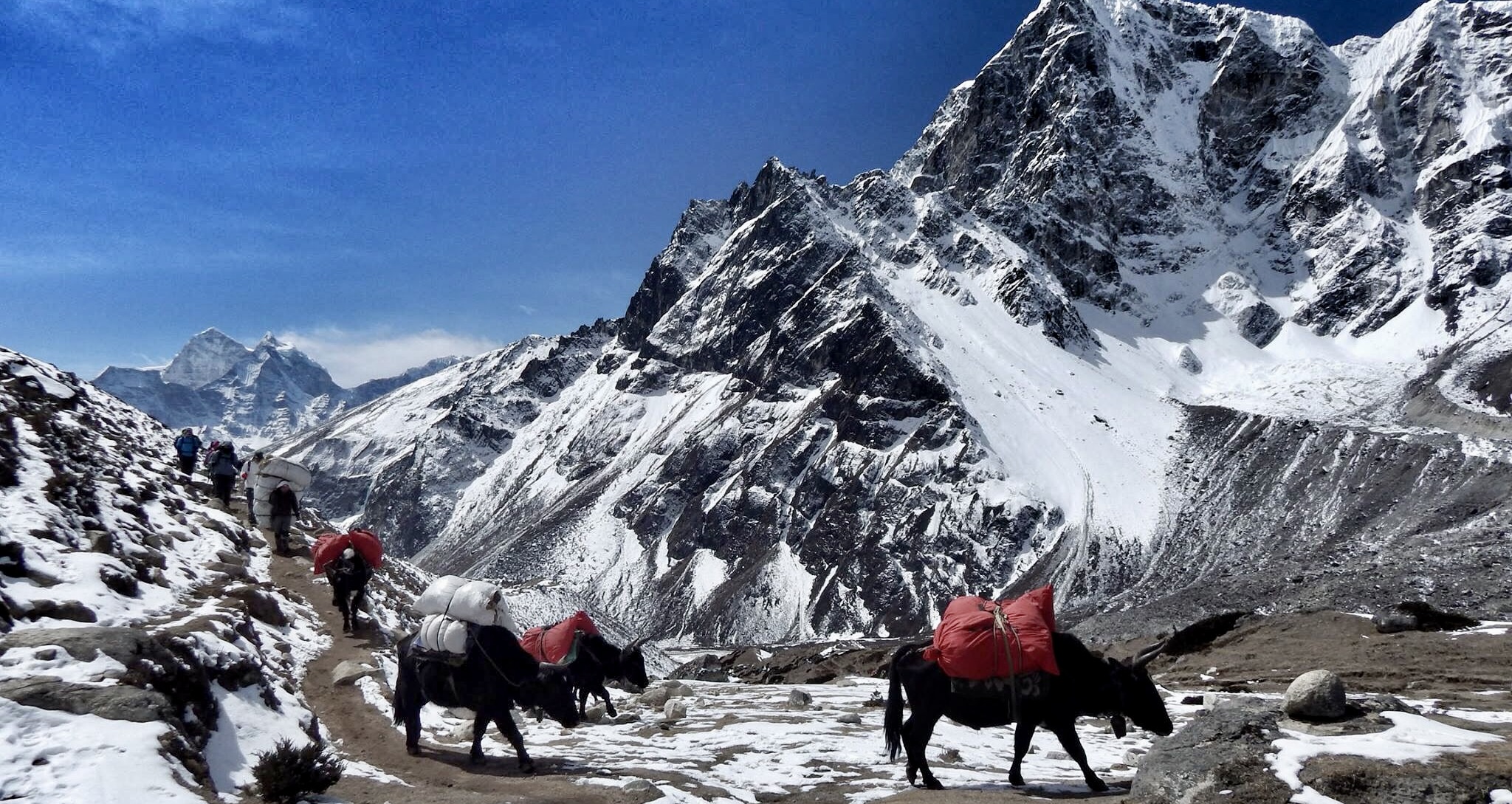
During this time, the skies are generally clear, giving trekkers the opportunity to enjoy stunning views of the mountain peaks, including Mount Everest. This period is also characterized by fewer trekkers on the trail, offering a more serene and less crowded trekking experience.
Furthermore, March is a great time to witness the region's unique flora and fauna as the snow melts and flowers begin to bloom. However, be prepared for occasional snowfall, especially at higher altitudes. Ensure to pack layered clothing to stay warm and protect yourself from unpredictable weather.
In summary, if you prefer a tranquil trek with clear views and are prepared to face some chilly weather, March could be a good month for your Everest Base Camp Trek.
April: The Peak of Spring
April is one of the most popular and ideal months to trek to Everest Base Camp. The temperatures are relatively moderate and the weather is generally stable. The average daytime temperature at the base camp during April ranges from -2 to -10 degrees Celsius (28.4 to 14 degrees Fahrenheit). At night, temperatures can drop to around -12 degrees Celsius (10.4 degrees Fahrenheit).
Clear and bright skies are a trademark of this month, which provides stunning and uninterrupted views of the snow-capped Himalayas. The trails are livelier as the trekking season is at its peak, with many mountaineering expeditions heading toward the base camp.
The vibrant rhododendron and other alpine flowers are in full bloom, adding a splash of color to the landscape. April is also a great time for wildlife enthusiasts as various bird species migrate to the region.
While the weather is generally favorable, keep in mind that it can change quickly in the mountains. Be prepared for occasional snowfall and pack accordingly. Overall, with its ideal weather conditions and blooming natural beauty, April offers an excellent trekking experience for Everest Base Camp trekkers.
May: The Last Spring Month
May continues the run of favorable weather for Everest Base Camp treks, being the last spring month before the monsoon season sets in. The temperatures are a bit warmer than in April, with daytime averages at the base camp ranging between -2 to -5 degrees Celsius (28.4 to 23 degrees Fahrenheit). Nighttime temperatures can drop to around -10 degrees Celsius (14 degrees Fahrenheit).
The trails may be less crowded as many mountaineering expeditions will have already left for their summit attempts in April. You may still encounter a fair number of trekkers and climbers.
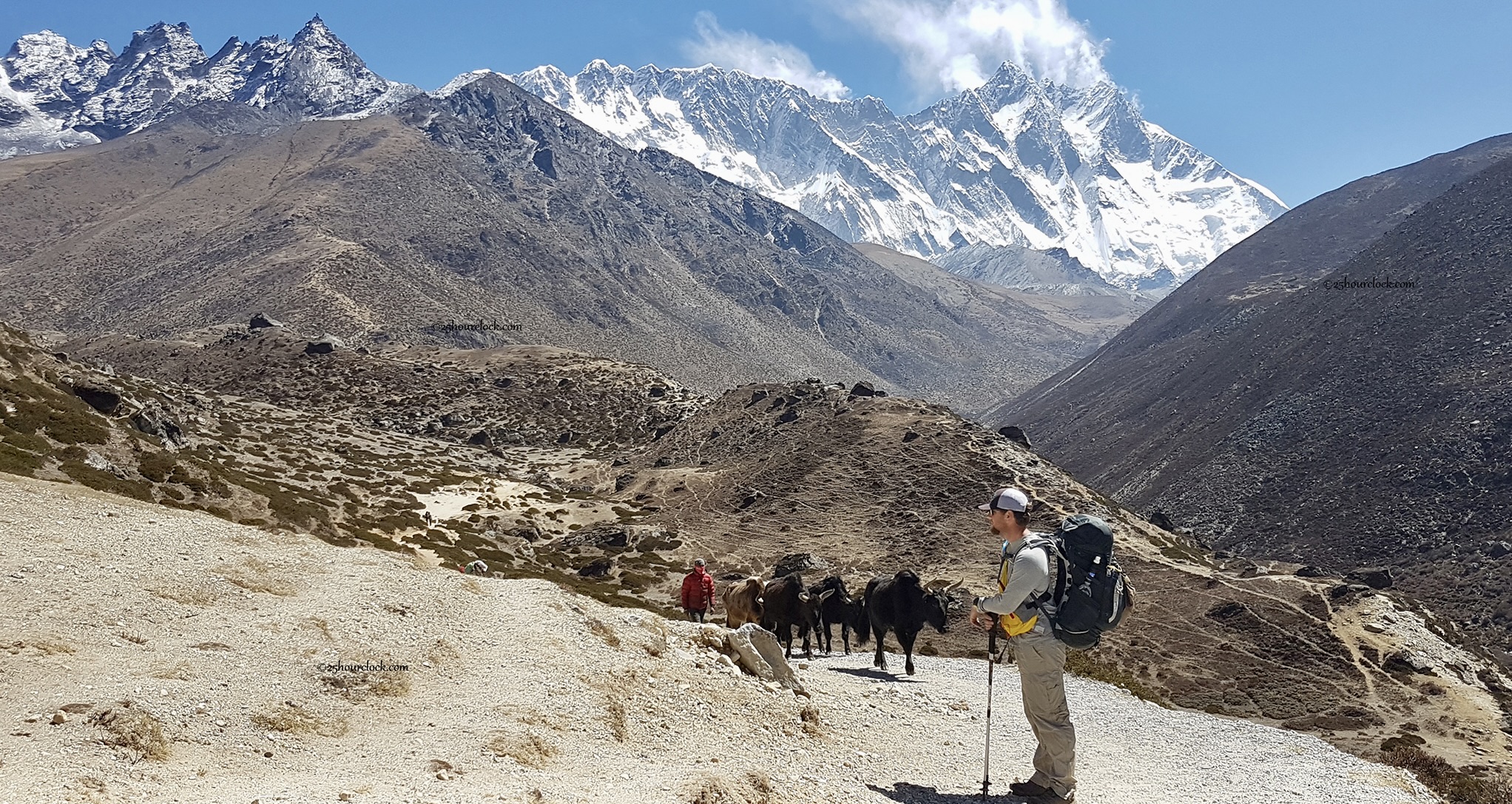
Clear skies are common in the mornings with more cloud cover in the afternoons. The breathtaking panoramic views of the Everest range are still very much on display in May. Wildflowers continue to dot the landscape, and the vibrant Sherpa culture is as enchanting as ever.
Be prepared for sporadic weather changes; despite being generally clear, the chance for snow and rain increases towards the end of May due to the approaching monsoon season. As with any time of year in the Himalayas, it's crucial to pack for a range of conditions and temperatures.
May is a great time to trek to Everest Base Camp with pleasant weather, relatively warm temperatures, and the continued offering of magnificent Himalayan scenery.
June: The Start of the Monsoon Season
June marks the beginning of the monsoon season in Nepal, which can bring unpredictable weather to the Everest region. Daytime temperatures at the base camp average around 2 to -2 degrees Celsius (35.6 to 28.4 degrees Fahrenheit), but they can drop to about -8 degrees Celsius (17.6 degrees Fahrenheit) at night.
Early June can still be a suitable time for trekking, as the full brunt of the monsoon may not have hit the region yet. However, as the month progresses, the likelihood of heavy rain, cloud cover, and poor visibility increases. Trails can become muddy and slippery, making the trek more challenging.
Despite these challenges, there are a few upsides to trekking in June. The trails and teahouses are less crowded, giving you a more solitary experience with nature. Also, the monsoon rain brings freshness to the flora of the region, with lush, verdant landscapes that can be a treat to the eyes.
Given the wet conditions and potential for low clouds and fog, it's crucial to pack waterproof clothing and be prepared for possible delays or itinerary changes due to the weather.
To summarize, while June isn't the peak season for trekking to Everest Base Camp, it can still provide a unique and rewarding experience for the well-prepared trekker who doesn't mind a bit of rain and muddy trails.
July: Peak of Monsoon Season
July is the peak of the monsoon season in Nepal and is often considered the least favorable month for trekking to Everest Base Camp. With average daytime temperatures at the base camp hovering between 2 to -2 degrees Celsius (35.6 to 28.4 degrees Fahrenheit) and nighttime temperatures dropping to -8 degrees Celsius (17.6 degrees Fahrenheit), the climate remains cool.
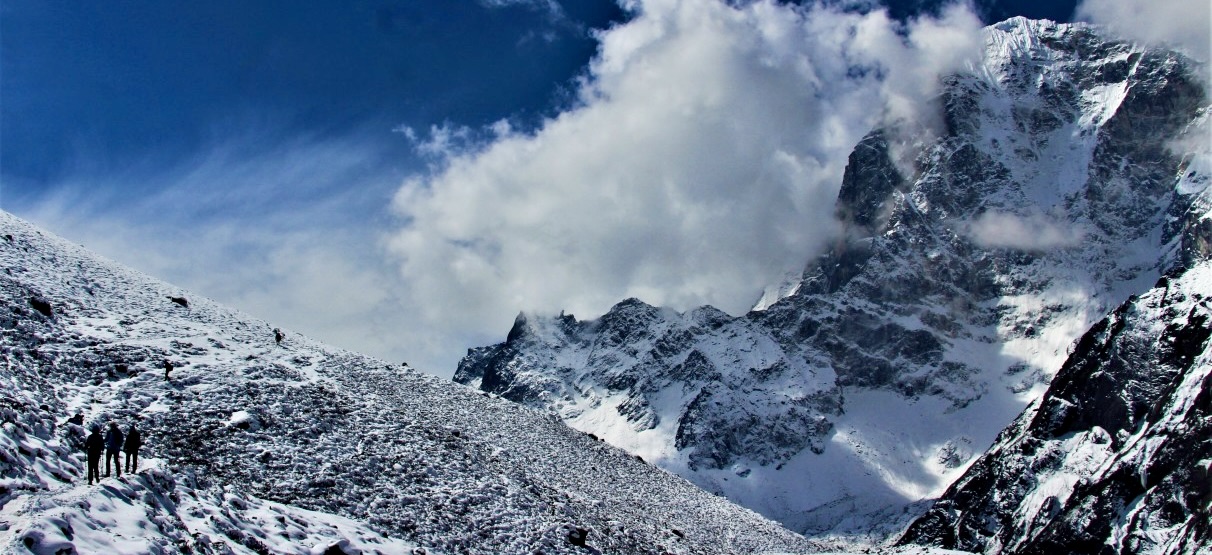
The main challenge in July comes from heavy rainfall, which can lead to slippery trails, landslides, and leeches. Furthermore, visibility is usually poor because of the rain clouds and fog, obscuring the stunning views that trekkers come to see.
Yet, like June, there are a few advantages to trekking in July. The trails are typically empty, providing a quieter, more introspective experience. The rain washes the landscapes, bringing out vibrant colors in the verdant vegetation, flowers, and waterfalls that adorn the trails. The monsoon also brings a sense of tranquility and calm to the mountains, which some trekkers find appealing.
Nonetheless, anyone planning to trek to Everest Base Camp in July must come prepared. Waterproof clothing, good trekking boots, and leech protection are essential. Furthermore, flexibility is key, as weather conditions may require changes in the trekking schedule.
While July is generally considered off-peak for Everest Base Camp trekking due to the monsoon season, it can still offer a unique trekking experience for those who are well-prepared and willing to face the challenges posed by the weather.
August: Transition from Monsoon Season
August is considered a transitional month for trekking in the Everest region as it marks the tail end of the monsoon season. As such, the weather remains unpredictable, with a mix of heavy rains, fog, and occasional clear days.
The average temperature at the base camp during August ranges from 1 to -1 degrees Celsius (33.8 to 30.2 degrees Fahrenheit) during the day, while at night, it can drop to around -7 degrees Celsius (19.4 degrees Fahrenheit). These temperatures are similar to those in July, but with decreased rainfall as the month progresses, the conditions become more favorable for trekking.
Despite the remaining challenges posed by the monsoon season, such as possible landslides and slippery trails, August begins to see more trekkers returning to the Everest trails. The landscapes are still lush and vibrant, washed clean by the monsoon rains, and the mountain views can be spectacular on clear days.
Trekking in August still requires a higher level of preparedness compared to the peak seasons. Waterproof gear, sturdy trekking boots, and warm clothing for cool temperatures are essential. Trekkers must also be flexible and ready for potential changes in their itinerary due to weather conditions.
By the end of August, the monsoon starts to retreat, and the post-monsoon or autumn season begins, which is considered one of the best times for trekking in the Everest region. Thus, those who choose to trek in August may experience the best of both worlds - the lush landscapes of the monsoon season and the clear skies of the autumn season.
September: Beginning of the Peak Season
September marks the beginning of the autumn season, which is one of the most popular times to embark on the Everest Base Camp trek. The monsoon season typically ends in early September, and the weather becomes more stable as the month progresses.
During September, the temperatures at the base camp range from 10 to 15 degrees Celsius (50 to 59 degrees Fahrenheit) during the day, and can drop to between -1 to -5 degrees Celsius (30.2 to 23 degrees Fahrenheit) at night. The first half of the month might still witness some leftover rain from the monsoon season, but these gradually decrease, and by the end of the month, the skies are usually clear.
One of the main advantages of trekking in September is the spectacular visibility. The monsoon rains wash away the dust and pollution, resulting in crystal-clear skies and excellent mountain views. The valleys are also lush and green, filled with blooming flowers.
However, September also marks the start of the peak trekking season, which means the trails can get quite busy. It is advisable to book your accommodations and flights well in advance. Also, remember to pack layers of clothing to adjust to the fluctuating temperatures and a sturdy pair of trekking boots for the trail. Despite the crowds, the incredible weather and stunning views make September a fantastic time for the Everest Base Camp trek.
October: Peak of the Peak Season
October is perhaps the most popular month for the Everest Base Camp trek and is often considered the best time to make the journey. The weather is stable, with little to no rain, clear skies, and moderate temperatures, making it perfect for trekking.
During October, daytime temperatures at the base camp can vary between 12 to 16 degrees Celsius (53.6 to 60.8 degrees Fahrenheit), and the night temperatures can drop to -6 to -10 degrees Celsius (21.2 to 14 degrees Fahrenheit). The lower regions of the trek will be much warmer, so it is essential to pack layers that can be adjusted accordingly.

The primary reason for October's popularity is the excellent weather and almost guaranteed spectacular views of Mount Everest and the surrounding peaks. The sky remains clear, offering breathtaking views almost every day. However, due to the stable weather conditions and high visibility, the trails can get quite crowded during this month.
Despite the crowds, October's comfortable temperatures, reduced chance of flight cancellations due to weather, and excellent mountain visibility make it one of the best months for the Everest Base Camp trek. As always, it's wise to book your accommodation and flights early due to the high demand in this peak season.
November: Early Winter
November sees the start of winter in the Everest region, but it's still a good time to trek to Everest Base Camp, especially in the early part of the month. The weather is still fairly stable, the skies are clear, and the trails are less crowded as the peak season of October ends.
Daytime temperatures in the early part of November range between 6 to 10 degrees Celsius (42.8 to 50 degrees Fahrenheit) at the base camp. At night, it can drop to -10 to -14 degrees Celsius (14 to 6.8 degrees Fahrenheit). Lower elevations will be warmer, but as you ascend, the temperatures will drop, and you will experience a chill in the air, especially during the mornings and evenings.
The clear skies of November offer stunning views of the mountains, with the snowy peaks appearing even more striking against the blue skies. As the month progresses, it may start to snow, particularly at higher altitudes, adding a beautiful white blanket to the landscape.
Since the crowds from the peak season have dispersed, you'll have more tranquility on the trails. It's also easier to secure bookings for teahouses and flights. However, as the month ends, the temperatures continue to drop, making trekking more challenging, so it's crucial to pack warm clothing and be prepared for colder conditions. Always check the weather forecast and consult with your guide or trekking company before setting off.
December: Deep Winter
December marks the arrival of deep winter in the Everest region. Despite the challenging weather conditions, it is still possible for seasoned trekkers to make the journey to Everest Base Camp.
In December, daytime temperatures at Everest Base Camp typically hover around -5 to 5 degrees Celsius (23 to 41 degrees Fahrenheit). However, nighttime temperatures can plunge to -15 to -20 degrees Celsius (-5 to -4 degrees Fahrenheit). The further you climb, the colder it gets, so it's crucial to pack accordingly.
Snowfall is also common during December, which can add a layer of complexity to your trek. Trails can be snow-covered, and in some cases, passes may be closed due to heavy snowfall. However, the snow also brings a serene beauty to the landscape, covering the mountains and valleys in a stunning blanket of white.
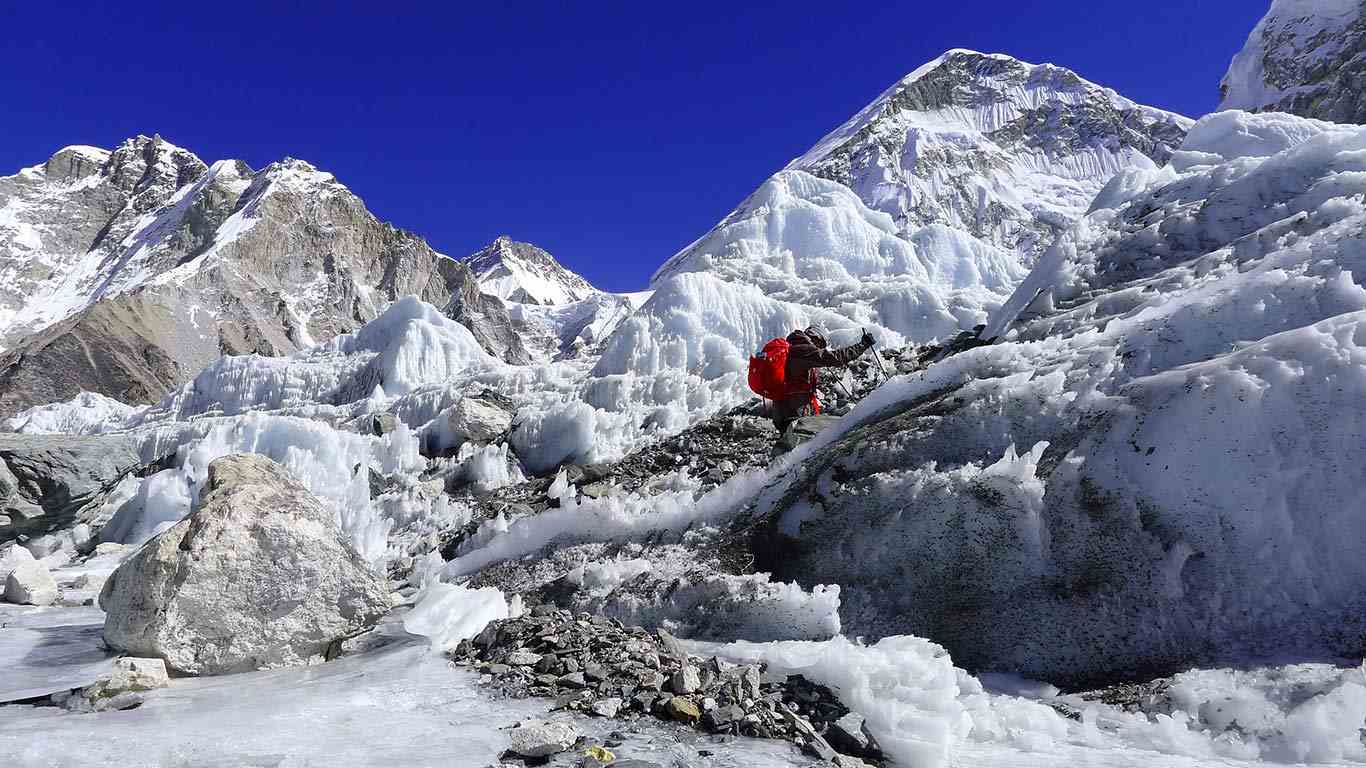
Despite the harsh conditions, the clear skies provide some of the best mountain views you'll see all year. The crowds are also significantly thinner, providing a more solitary and tranquil trekking experience. Teahouses remain open, but services might be limited, so it's advisable to check with your trekking company or guide about accommodation availability.
Trekking to Everest Base Camp in December is challenging, but with the right preparation and mindset, it can be a rewarding experience. You'll need to be physically fit and adequately prepared for extreme cold. It's also essential to have a seasoned guide and to keep an eye on the weather forecasts for any sudden changes. Remember, safety should always be your top priority.
Everest Base Camp Trek - Temperature - month-wise
January: During the day, temperatures usually range between -20°C to -10°C ( -4°F to 14°F). At night, temperatures can drop to around -25°C (-13°F) or even lower.
February: Daytime temperatures generally range between -15°C to -5°C (5°F to 23°F). At night, temperatures can drop to around -20°C (-4°F).
March: Daytime temperatures usually range between -10°C to 0°C (14°F to 32°F). At night, temperatures can drop to around -15°C (5°F).
April: Daytime temperatures typically range between -5°C to 5°C (23°F to 41°F). At night, temperatures can drop to around -10°C (14°F).
May: Daytime temperatures can range between 0°C to 10°C (32°F to 50°F). At night, temperatures can drop to around -5°C (23°F).
June: Daytime temperatures generally range between 5°C to 15°C (41°F to 59°F). At night, temperatures can drop to around 0°C (32°F).
July: Daytime temperatures usually range between 10°C to 20°C (50°F to 68°F). At night, temperatures can drop to around 5°C (41°F).
August: Daytime temperatures typically range between 10°C to 20°C (50°F to 68°F). At night, temperatures can drop to around 5°C (41°F).
September: Daytime temperatures usually range between 5°C to 15°C (41°F to 59°F). At night, temperatures can drop to around 0°C (32°F).
October: Daytime temperatures typically range between -5°C to 5°C (23°F to 41°F). At night, temperatures can drop to around -10°C (14°F).
November: Daytime temperatures generally range between -10°C to 0°C (14°F to 32°F). At night, temperatures can drop to around -15°C (5°F).
December: Daytime temperatures usually range between -20°C to -10°C (-4°F to 14°F). At night, temperatures can drop to around -25°C (-13°F) or even lower.
Everest Base Camp Trek - Air Pressure - month-wise
The air pressure at Everest Base Camp (5300m) remains fairly constant throughout the year. However, the way the human body perceives the pressure, or the 'effective altitude', changes with the weather. This is because cold, dry air seems thinner than warm, humid air.
On average, the barometric pressure at Everest Base Camp is about half that at sea level, or around 500 hPa (hectopascals). This is due to the fact that there is simply less air above you pressing down. Keep in mind that the higher you go, the more the pressure drops.
Here is an approximate guide for effective altitude throughout the year:
January - February (winter): The air tends to be dry and cold, which can make the effective altitude seem higher than it is. You may perceive the air pressure as equivalent to an altitude of 5500m or higher.
March-May (spring): This is a popular time for trekking, with generally warmer and moister air than in winter. The effective altitude might feel like 5300m or slightly less.
June - August (monsoon): The weather is warmer and the air is often moist. However, cloudy weather can interfere with acclimatization. The effective altitude might fluctuate a lot depending on weather conditions.
September - November (autumn): Another popular trekking season with relatively stable and dry weather. The effective altitude would likely feel around 5300m.
December: With winter setting in, the air becomes colder and drier, which could make the effective altitude seem higher, similar to January and February.
These are rough estimates and individual responses to altitude can vary greatly. Additionally, sudden weather changes can influence effective altitude perception. Always prioritize acclimatization and listen to your body when trekking at high altitudes.
Everest Base Camp Trek - Monsoon Measurement - month-wise
While exact measurements can vary from year to year and between different locations along the Everest Base Camp trek, here's a rough estimate of the average monthly rainfall, which peaks during the monsoon season:
January: This is the winter season, with relatively little rainfall, typically less than 20 mm.
February: As we get closer to spring, the rainfall is still on the lower side, generally less than 30 mm.
March: March sees a slight increase in rainfall, with averages around 30 to 40 mm.
April: With the approach of the pre-monsoon season, rainfall increases, with averages around 50 to 60 mm.
May: The pre-monsoon season sees more rainfall, typically around 60 to 70 mm.
June: This is the start of the monsoon season, with heavy rainfall, often exceeding 140 mm.
July: This is the peak of the monsoon season, with the highest rainfall of the year, often exceeding 200 mm.
August: The monsoon season continues with heavy rainfall, often around 180-200 mm.
September: The rainfall starts to decrease as the monsoon season ends, with averages around 100 to 120 mm.
October: With the return of the post-monsoon season, rainfall drops significantly to around 60 mm.
November: November sees low rainfall, similar to early in the year, typically around 20 mm.
December: This is another dry month with minimal rainfall, typically less than 20 mm.
These figures are estimates and can vary. The monsoon season, in particular, can see significant variations in rainfall. Always check local weather forecasts for the most accurate and up-to-date information. It's important to note that during the monsoon season, the trails can be slippery and views may be obscured by cloud cover, but the scenery can also be exceptionally lush and beautiful.
Luxury Everest Base Camp Trek - Weather and Temperature
The weather and temperature during the Luxury Everest Base Camp Trek vary depending on the time of year. The beauty of choosing a luxury trek is that regardless of the outside conditions, you'll have comfortable and warm accommodations waiting for you at the end of each trekking day.
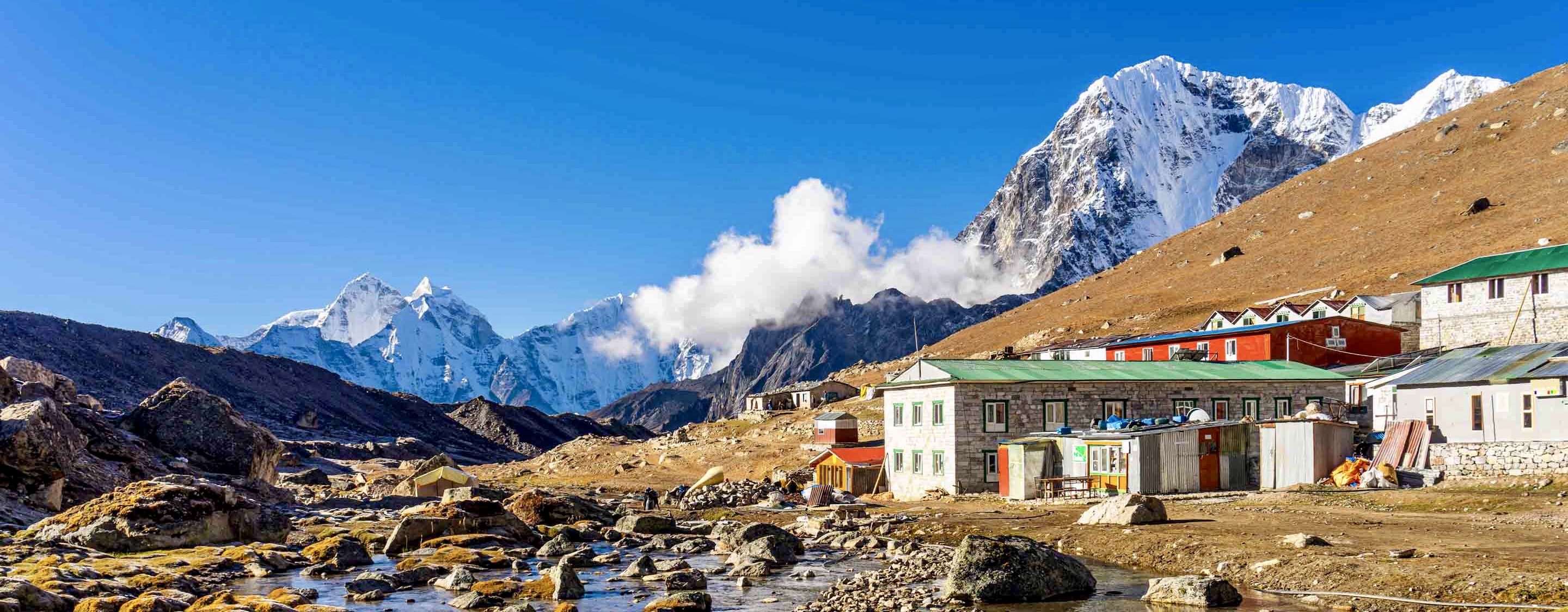
January and February: These are the coldest months, with daytime temperatures around -15°C to -10°C. Nighttime temperatures can drop to -25°C. Despite the cold, the skies are usually very clear, with very few trekkers on the trail.
March and April: The weather starts to warm up with temperatures during the day around 5°C to 12°C. At night, the temperatures can drop to -8°C. The weather is usually clear, making it a popular time for trekking.
May: This month sees warmer daytime temperatures, usually between 5°C to 15°C, with clear and sunny weather. At night, the temperatures can drop to -4°C. This is a popular time for trekking due to good visibility.
June to August: These are the monsoon months, with higher chances of rain and cloudy skies. Temperatures during the day range between 10°C to 15°C, and at night it can drop to 2°C. Despite the rain, some trekkers still prefer this season due to fewer crowds.
September to November: These are the post-monsoon months with clear skies and dry weather. The daytime temperatures range between 10°C to 15°C, and at night it can drop to -5°C. This is one of the most popular times to trek due to the excellent weather conditions.
December: This is the beginning of winter, with colder temperatures ranging between -10°C to 5°C during the day and dropping to -20°C at night. The skies are clear, but there are very few trekkers due to the cold.
Always remember that the weather in the Himalayas can be unpredictable, so it's essential to come prepared with appropriate clothing for cold, heat, rain, and wind. In a luxury trek, you'll be well taken care of with hot meals and comfortable accommodations, making the weather an exciting part of the adventure rather than a challenge.
Everest Base Camp Helicopter Trek - Weather and Temperature
Experiencing the Everest Base Camp Helicopter Trek is an exhilarating journey, offering the breathtaking beauty of the Himalayas in a condensed time frame. While the trekking portion follows the same weather patterns as the traditional Everest Base Camp trek, the helicopter return adds an extra element of weather consideration.
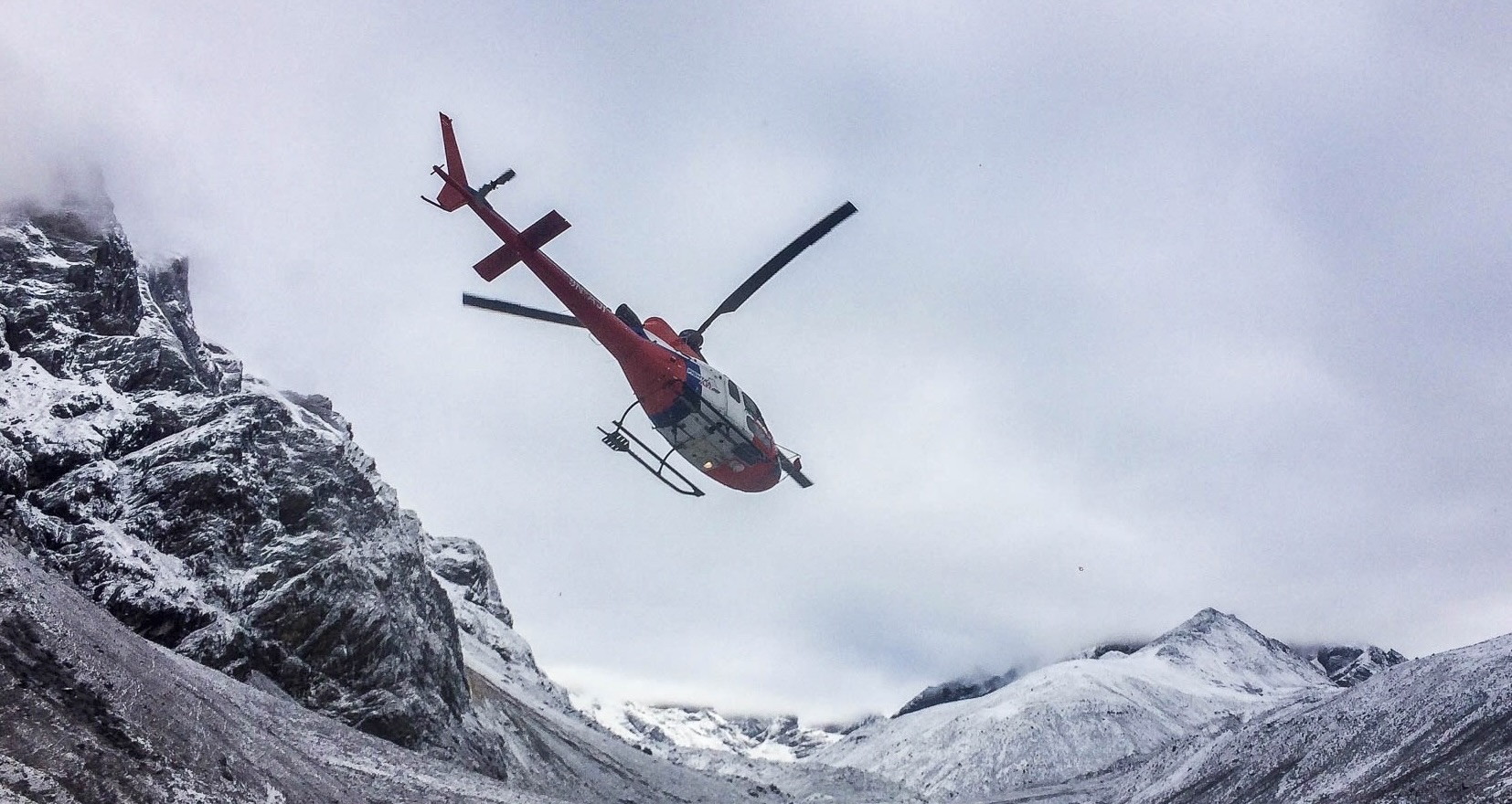
January and February: These months are the coldest, with daytime temperatures reaching -10°C to -15°C, and can drop down to -25°C at night. The skies are usually clear, which is beneficial for helicopter flights.
March and April: The weather starts to warm up, with temperatures ranging from 5°C to 12°C during the day. Nighttime temperatures can still dip to -8°C. The weather is generally clear, which is excellent for helicopter flights.
May: Daytime temperatures warm up to 5°C to 15°C. The weather is generally clear, allowing for excellent visibility for your helicopter ride. At night, the temperatures can still drop to -4°C.
June to August: These are the monsoon months. Temperatures range between 10°C to 15°C during the day and drop to around 2°C at night. The flights are subjected to the day's weather conditions, which could potentially lead to delays or cancellations due to safety reasons.
September to November: These months offer the best weather conditions. The daytime temperatures range between 10°C to 15°C, and at night it can drop to -5°C. The weather is generally clear, making it ideal for helicopter flights.
December: The beginning of winter sees colder temperatures ranging between -10°C to 5°C during the day and dropping to -20°C at night. The skies are clear, but the cold weather can be challenging for some.
The helicopter portion of the trek requires clear and calm weather for safety reasons. Therefore, while the trek can be completed year-round, the best months for the Everest Base Camp Helicopter Trek are pre-monsoon (February-May) and post-monsoon (September-November). However, regardless of when you go, experiencing Everest from the unique vantage point of a helicopter is an adventure that is sure to leave you with lasting memories.
The weather and temperature during your Everest Base Camp trek will vary significantly depending on the month you choose for the expedition. From the crisp, clear skies of the post-monsoon period to the fresh, verdant landscapes of the pre-monsoon season, every month offers a unique perspective on this journey of a lifetime.
It's essential to be adequately prepared for the weather conditions you are likely to encounter. As such, having a comprehensive understanding of the month-wise weather and temperature on the trek can help you make informed decisions about the best time to go, what to pack, and how to prepare. Remember, regardless of the month, the Everest Base Camp trek is an adventure that promises awe-inspiring vistas and the thrill of a lifetime. Here's to your journey to the base of the highest peak on Earth!
FAQs Everest Base Camp Trek Month Wise: Weather and Temperature
Q: what is the best month to trek to everest base camp.
A: The best months to trek to Everest Base Camp are typically pre-monsoon (February to May) and post-monsoon (late September to December) when the skies are clear and temperatures are relatively mild.
Q: Is it possible to trek to Everest Base Camp in winter?
A: Yes, it is possible, but it is more challenging due to colder temperatures and potentially snowy conditions. Fewer trekkers choose this time, so the trail is less crowded.
Q: How cold does it get at Everest Base Camp?
A: Temperatures at Everest Base Camp can drop below -20°C in winter months (December to February). During the trekking season (March to May and September to November), nighttime temperatures can still drop below freezing.
Q: Does it rain a lot during the monsoon season on the Everest Base Camp trek?
A: Yes, the monsoon season (June to early September) can bring heavy rainfall and cloud cover, making the trek more challenging and views less predictable.
Q: What is the temperature like at Everest Base Camp in April?
A: In April, the day temperatures at Everest Base Camp can range from 0°C to 5°C. Night temperatures can drop to -10°C.
Q: Is it safe to trek to Everest Base Camp during the monsoon season?
A: While it's possible to trek during the monsoon season, it's less than ideal due to heavy rain, potential flight delays, and less visibility. It's generally recommended to trek outside of these months.
Q: How quickly do weather conditions change on the Everest Base Camp Trek?
A: Weather conditions in the Everest region can change rapidly due to its high altitude and mountainous terrain. It's not uncommon to experience sunshine, rain, and snow all in a single day.
Q: What clothing should I pack for the Everest Base Camp Trek, considering the weather and temperature changes?
A: Layering is key for the Everest Base Camp trek. Ensure you have thermal base layers, a down jacket, trekking shirts and trousers, a waterproof jacket and trousers, good quality trekking boots, warm gloves, and a beanie.
Q: Do all tea houses on the Everest Base Camp trail have heating?
A: Most tea houses will have a communal area with a stove for heating but bedrooms are usually not heated. It can be very cold at night so a good quality sleeping bag is essential.
Q: How can I prepare for trekking in cold conditions on Everest Base Camp Trek?
A: You can prepare by investing in good quality, warm clothing, and ensuring that you have a sufficient level of fitness. Additionally, it's crucial to understand your body's response to cold and be aware of signs of hypothermia. A positive mindset is also a valuable tool.
Everest Region Trekking Packages
Everest Heli Trek with Kalapathher Landing
Everest Base Camp Heli Trek - 9 Days
If you need any further information, please contact us by email: at [email protected] , Phone: at +977- 985 100 5129 ( WhatsApp )
- Everest Base Camp Trek Weather
- Everest Base Camp Trek Temperature
- EBC Trek Weather
- Himalayan Weather
- Hidden Waterfalls around Kathmandu
- Everest Base Camp Trekking Vs Kilimanjaro Climbing
Drop us a message

Mr. Shishir Banjara
Shishir Banjara is the founder of Luxury Holidays Nepal Pvt Ltd, a renowned luxury travel company, and also a highly esteemed professional blogger with a deep passion for exploring and promoting the beauty of Nepal. Having embarked on countless journeys throughout the country, Shishir has gained a wealth of firsthand knowledge and experiences that have shaped his understanding of Nepal's diverse landscapes, cultural heritage, and hidden gems. His extensive travels have taken him to remote villages, vibrant cities, majestic mountains, and tranquil valleys, allowing him to develop a profound insight into the intricacies and charms of Nepal. Through his blog, he shares captivating stories, insider tips, and breathtaking photographs, inspiring fellow adventurers and curious travelers to embark on their own remarkable journeys and discover the wonders that Nepal has to offer.
Blog by Categories
- Everest Base Camp Trek 19
- Travelogues
- Travel Agent Cooperation
.jpg)
Everest Base Camp Weather: a detailed guide to climate and weather of Everest Base Camp in Tibet
The weather at Everest Base Camp (EBC) is one of the extremes, both in terms of temperatures and winds. The temperature at the base camp rarely gets above freezing throughout the year, and the biting winds that blow across the Himalayas make the temperatures feel even colder. The coldest months of the year are from December to February, when temperatures drop well below freezing, even during the day, with the warmest temperatures in the rainy season in July and August. For most people traveling to EBC, the best time of the year is from April to May and September to October.
Climate and Weather of Everest Base Camp
Tibet is a land that lies on the world’s highest plateau and the temperatures and weather can be cold for most of the year, with high winds and a very varied climate.The weather conditions in Tibet depend on where you are and at what altitude, with the worst conditions being at the highest altitudes, such as that of EBC. Compared to the lower altitudes of Lhasa and Nyingchi, where the weather is relatively mild even in winter, EBC sees some of the harshest weather on the plateau.

At an altitude of 5,200 meters above sea level, EBC has a climate that is characterized as a mountain plateau climate, which can be cold throughout the year. The average temperature is -17 degrees Celsius, which is considered the coldest during the year mostly from mid-December to January. During spring months the temperature warms up rapidly but the night remains still cold and chilly, dropping to below freezing. Temperatures range throughout the year from around 22 degrees in the height of summer to as low as -5 degrees in winter during the day, with temperatures at night ranging from -15 in the winter to around 4 degrees in the summer months.
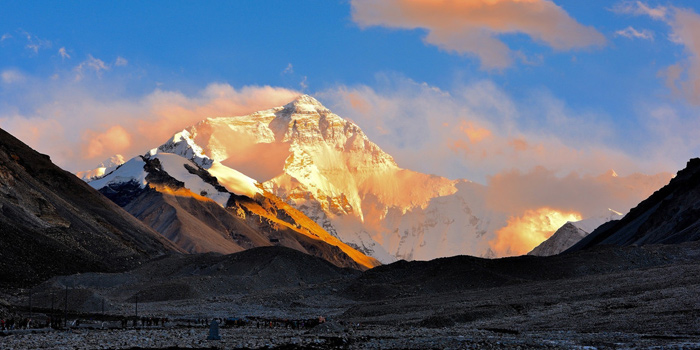
8 Days Lhasa to Everest Base Camp Small Group Tour
Everest base camp weather in four seasons, spring (april - may).
Daytime temperature: 15°C Nighttime temperature: -1°C Wind speed: 11km/h Precipitation/month: 7mm Sunshine hours/day: 9
Spring at EBC is one of the best times of the year to visit. The weather is generally bright with clear skies and few clouds, so visibility of the summit is much better. The base camp is fully open, and the tent guesthouses are up once more, giving tourists a place to stay and eat in traditional Tibetan style. Temperatures may not be as high as summer, but it is still warm enough to be comfortable.
Monsoon Season (June - September)
Daytime temperature: 22°C Nighttime temperature: 4°C Wind speed: 10km/h Precipitation/month: 170mm Sunshine hours/day: 7-8
The monsoon season sees a much higher rainfall at EBC than throughout the rest of the year, and while some areas of the west of Tibet are not as wet, the area around Mount Everest sees high rainfall for this altitude. Temperatures are high, reaching up to around 22 degrees, but the higher rainfall can make the area muddy and hard to traverse.

Autumn (October - November)
Daytime temperature: 17°C Nighttime temperature: -8°C Wind speed: 22km/h Precipitation/month: 2.5mm Sunshine hours/day: 9-10
The autumn season in Tibet is another great time to visit EBC, with the skies being clear once more after the monsoon rains and the landscape still as lush and verdant as ever. Bright sunshine is warming, with highs of up to 17 degrees, though the winds can still be strong and cold, making it feel cooler. The heavier clouds are gone now, and the summit of the mountain is once more clearly visible from the base camp.
Winter (November - April)
Daytime temperature: -5°C Nighttime temperature: -15°C Wind speed: 7-8km/h Precipitation/month: 5mm Sunshine hours/day: 7-8
Winter is the coldest time of year at EBC, though January is actually the coldest month, with an average temperature of around -10°C through the season. However, there is almost no rain and the winds have died off a little, bringing in clear skies and bright sunshine that can still make it worth visiting. Despite being the middle of winter, there is often little snow around EBC, and it is still possible to travel to the base camp easily, even in January.
Best Time to Visit Everest Base Camp for Different Travelers
Mount Everest Base Camp is actually open all year round, and can be accessed from Lhasa quite easily, even in the depths of winter. For those planning a trek to EBC, the best time to travel is from April to May and September to October, when the climate is moderate and there is little rain. Wet weather can make the trek from Tingri to EBC a little harder.
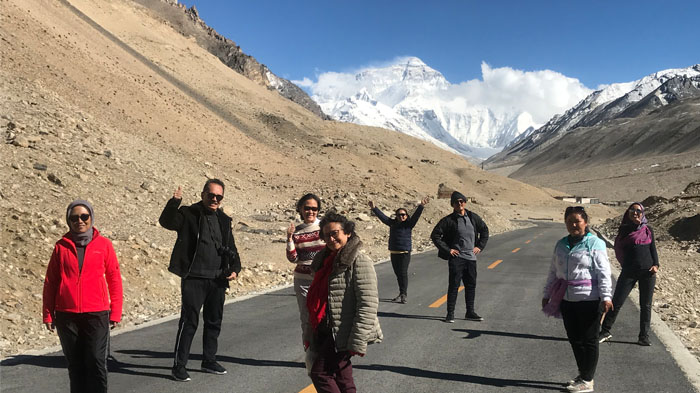
For those that are traveling on a budget, the winter months are actually the best time to travel, as the cost of the tours is cheaper. You will also find that there are cheaper accommodations in the winter months, though there is only the Rongbuk Guesthouse to stay in at EBC in the winter, as the tent guesthouses have packed up until April. But with fewer tourists and cheaper costs, it is better to travel from November to February for a cheap EBC tour .
Packing List for Everest Base Camp Tour
For a good visit to Tibet you need to pack carefully, as it can be cold there at any time of the year. Make sure that you have your valid passport and Chinese Entry Visa with you at all times, and that it is kept secure or on your person at all times.
Tibet Travel Documents
● Tibet Travel Permit : This permit is issued by the Tibet Tourism Bureau and is required for all international travelers heading for Tibet. You need to apply for this permit one month prior to your arrival in Tibet as this permit takes some time to get ready and you need to produce the original copy of this permit at the Airport before you board the flight. ● Alien's Travel Permit: required for travel outside Lhasa, this permit is issued by the Public Security Bureau in Lhasa once you arrive, and can be obtained in an hour by your guide, using your passport and Tibet Travel Permit. ● Frontier Pass: This is required for all tourists heading for the areas around the border of China with Nepal, India, and Bhutan, of which EBC is a part.
Tibet is renowned for having a very high temperature difference from day to night, and the temperatures at night at EBC can get pretty cold, even in the summer months, make sure that you have layers of long and short tops to keep warm with, a good fleece or down jacket and a couple of woolen sweaters, and rain and windproof coats. Bring along plenty of underwear, including long underwear for the colder times, and thick woolen socks to keep your feet warm.
Strong hiking boots are an advantage, as you will be walking on rough and rocky terrain, and you need to make sure your feet are kept dry and your ankles are supported. Sports shoes are only useful for towns and cities and using in the hotel.
Take a large backpack, a small bag and a waist bag is enough. Bigger backpack will be a wise option as it will be unable to keep clothes and will be easy to carry as the path is not that smooth to walk. The small bag will be usable to carry the things for daily use, such as hand towels, toiletries, etc., while the waist bag will be useful to carry some small and important things such as your passport and documents, cellphone, etc.
Toiletries and skin protection
Though the solar radiations are strong in Tibet, it is necessary to keep sunscreen with minimum SPF 35, lip balms, cold cream, moisturizer, UV protection sunglasses, sun hat, ear buds, nail clippers, etc. Do not expose your skin in the sun as rays are harsh there and may cause sunburn. You also need to make sure that you have enough toiletries, such as Toothpaste, toothbrush, soap, oil, shampoo, small hand towel, shaving kit, deodorant, etc.
Cash not Credit Cards
Bring cash in different denominations and try to keep enough cash with you as when you will be away from Lhasa in remote areas cash is the only form of payment available. Credit cards are usable only in the big hotels and restaurants.
Trekking Equipment
You need to take the necessary equipment with you because, in remote areas, availability of things is rare. Take trekking equipment including sleeping bags, sleeping mats, stoves, cookware, water filter, camp bathroom, tents and tarps, first aid kits for an emergency, expedition food, multi-tools, Swiss knife, compass, maps, etc.
Consult your doctor and do carry the prescribed medicines, if you take any on a regular basis. Take medicine for cold, insect bite, headache, stomach ache, and diarrhea. Bring an adequate amount of cleaning solution for your contact lenses as you may not find that easily in Lhasa. There are some medications for altitude sickness available, but you should consult your own doctor before you take them, and it is not recommended.
With such a varied climate around the year, travel to EBC is something that does require careful planning in terms of making sure that your packing is right for the time of year. Always pack the necessary things for the trip, and leave behind things you may not need, as you will be restricted in weight on the flights. Spring and autumn are the best months to travel to EBC, and for those that want to make the trip a little cheaper, winter is the best option, as long as you do not mind a little colder weather and do not want to trek.

Ask a Quick Question
Your Full Name:
Your Email Adress:
More about Your Travel Plan:

About the Author - Master Kungga Dundruk
The Lhasa-born prodigy used to study business overseas, and got his Bachelor of Business in Nepal and India before moving back to his homeland. With pure passion for life and unlimited love for Tibet, Kunga started his guide career as early as 1997 .
Responsible, considerate, and humorous, he devoted his entire life to guiding and serving international tourists traveling in Tibet. As a legendary Tibetan travel guru with 20-year pro guide experience. Currently, he is working in Tibet Vista as the Tour Operating Director. Whenever our clients run into trouble, he is your first call and will offer prompt support.
More Mount Everest Base Camp Travel Guide
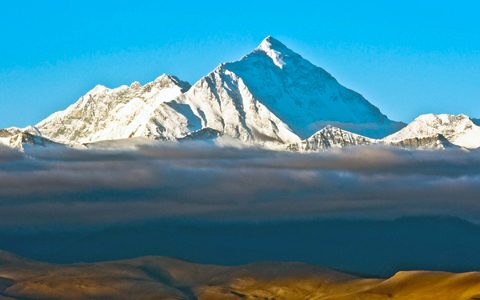
- Everest Base Camp Nepal vs Everest Base Camp Tibet
- Mount Everest History and Its Famous Explorers
- The Difference of Mt.Everest in Nepal and Tibet
- Kathmandu to EBC Distance: how far and how to get to EBC in Nepal and Tibet from Kathmandu
- How Many Base Camps on Everest in Both Sides of Tibet and Nepal
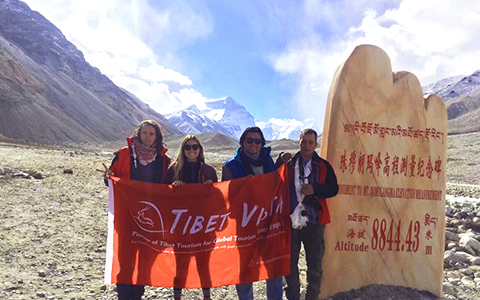
- When is the Best Time to Visit Tibet Everest Base Camp in 2024
- When is the Best Time to Enjoy EBC Trek in Nepal
- The Best Hotel at Everest Base Camp in Tibetan Side
- Guide to Tibet Everest Base Camp Tour in Winter
- How to Get to Everest Base Camp (EBC) from Nepal?
- How to Get to Mount Everest Base Camp from Lhasa
- What Documents Do I Need for Everest Base Camp Tour in Tibet and Nepal?
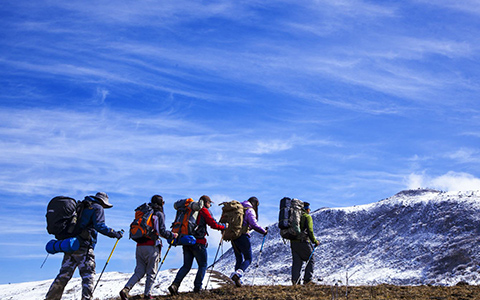
- What to Pack for Everest Base Camp Trek
- Tingri to Everest Base Camp Trekking
- Everest Trek: Trekking Routes along The Gama Valley
- Everest Base Camp Trekking Maps in Tibet
- Ultimate Packing List for Everest Base Camp Trek in Tibet
- Best Trek in Nepal: Everest Base Camp Trek vs. Annapurna Circuit Trek
- Top 2 EBC Trekking Routes in Tibet
- EBC Trek in Tibet vs. EBC Trek in Nepal
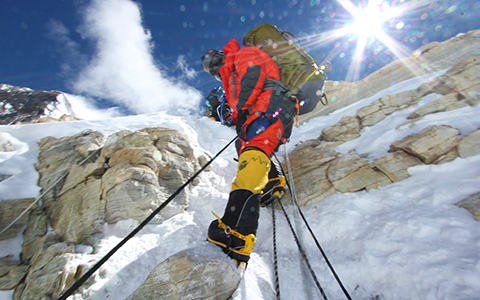
- The Ultimate Guide to Mt. Everest Climbing in Tibet
- Guide to Mount Everest Climbing in Nepal
- Dangers Facing Mt.Everest Climbers
- Edmund Hillary: The First Man to Reach the Top of Mt. Everest
- Top FAQs about Mount Everest Climbing Tour
Recommended Everest Base Camp Tour Packages

Tour Route : Lhasa - Gyantse - Shigatse - Everest Base Camp - Gyirong - Kathmandu
From USD979 p.p

Tour Route :Lhasa - Gyantse - Shigatse - Everest Base Camp - Shigatse - Lhasa
From USD939 p.p

Tour Route :Lhasa - Gyantse - Shigatse - EBC - Shigatse - Lhasa - Namtso Lake - Damxung - Lhasa
From USD1289 p.p
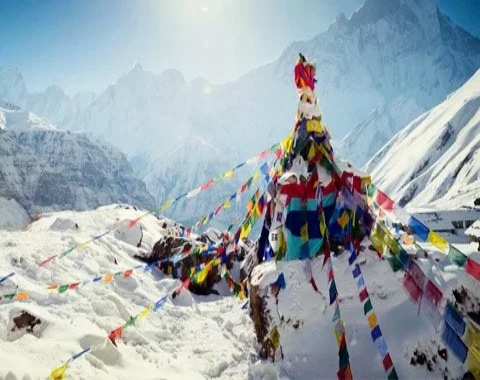
Tour Route :Kathmandu - Phakding-Namche Bazaar-Tengboche- Dingboche- Lobuche-Gorakshep- Everest base camp-Kathmandu
Have a Question? Ask below or email our travel experts directly at [email protected]
Question Summary *
Please fill in your contact information, we will send you the answer by email
Country * : United States India Australia Malaysia United Kingdom Singapore Canada Germany China France Indonesia Hong Kong, China Netherlands Spain Italy New Zealand Brazil Mexico Thailand Switzerland Japan South Africa Nepal Philippines Russia Sweden Belgium Argentina Austria Ireland Israel Chile Vietnam Denmark Bangladesh Poland Portugal Sri Lanka South Korea Oman Romania Pakistan Other Colombia Hungary Taiwan, China Finland Greece Turkey Norway Mongolia Bhutan Bulgaria Costa Rica Myanmar Saudi Arabia Slovenia Ukraine Lithuania Egypt Qatar Mauritius Serbia Ecuador Uruguay Iran Niger Venezuela Cyprus Lebanon Nigeria Honduras Latvia Peru Guatemala Belarus Cambodia Estonia Kenya Macau, China Malta Tunisia Albania Bahrain Jordan Luxembourg Andorra Azerbaijan Georgia Guinea Kuwait Panama El Salvador French Guiana Iceland Kazakhstan Macedonia Micronesia Montenegro Morocco Paraguay Tanzania Uzbekistan Zimbabwe Anguilla Armenia Belize Benin Bolivia Botswana Dominica Eritrea Ethiopia Fiji Laos Liberia Libya Malawi Mali Moldova Monaco Namibia Norfolk Island Reunion Island Somalia Swaziland Tajikistan Turkmenistan Tuvalu Yemen Zambia Afghanistan Algeria Angola Antarctica Aruba Bahamas Barbados Bermuda Burkina Faso Burundi Cameroon Chad Comoros Djibouti East Timor French Polynesia Gabon Gambia Ghana Gibraltar Greenland Grenada Guadeloupe Guam Guernsey Guyana Haiti Iraq Jamaica Jersey Kiribati Kosovo Lesotho Liechtenstein Madagascar Maldives Martinique Mauritania Mayotte Island Montserrat Mozambique Nauru New Caledonia Nicaragua Niue Palau Pitcairn Island Puerto Rico Rwanda Saint Helena Saint Lucia San Marino Senegal Seychelles Sierra Leone Suriname Timor-Leste Togo Tokelau Tonga Islands Uganda Vanuatu Vatican City Western Sahara Western Samoa Costarica Croatia Czech Korea
SUBMIT Cancel
0 Comment ON "Everest Base Camp Weather: a detailed guide to climate and weather of Everest Base Camp in Tibet"
Check All Tibet Travel FAQs Here
See the Wonders
Make our clients visit the right place in the right time
Offer objective guidance and explore Tibet with your own perspective
Advocate eco and responsible travel: leaving only the footprint in Tibet
Happy on Road
Hospitable Tibetan guides with overflowing sense of humor
Meet like-minded global tourists; forge team-work spirit and create lively travel atmosphere
24/7 call service, problem shooting in the first place
Knowledge & Experience
Accompanied by our Tibetan travel gurus
Offer best on-the-spot travel advice and consultancy
Systemic tour running and big networking in Tibet-inbound tourism industry
Safety Guarantee
Fully inform you the specialty of Tibet tour before your departure to Tibet
Oxygen supply device; hyperbaric chamber at EBC; first-aid kit; triple check of tour vehicle on a daily basis, etc.
Well-trained Tibetan guideswho monitor your health throughout your stay in Tibet
Want More Tibet Insider Travel Tips that you can't Find on Search Engine?
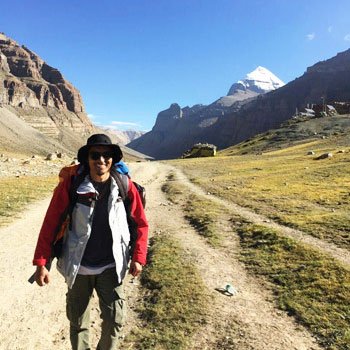
Sign up to receive our insider advice, stay up with latest news, get most professional suggestions about how to plan a lifetime Tibet trip, and be the first to know our special offers.
* We protect your privacy, and never sell or disclose your email with a 3rd party.

Your Submission is Successful
Thank you for subscribing to Tibet Vista Tour's Tibet travel newsletter. Check for your mail for a message from us.
We'll be sending you super-value information, latest travel news, insider travel tips and our clients' photos and videos that will help you plan a pleasant and memorable Tibet trip.
Cheers, Tibet Vista
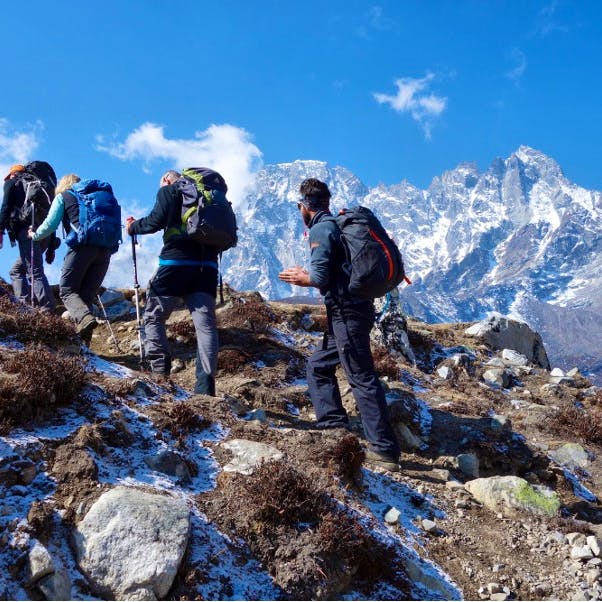
Everest Base Camp Weather: What Every Trekker Needs To Know
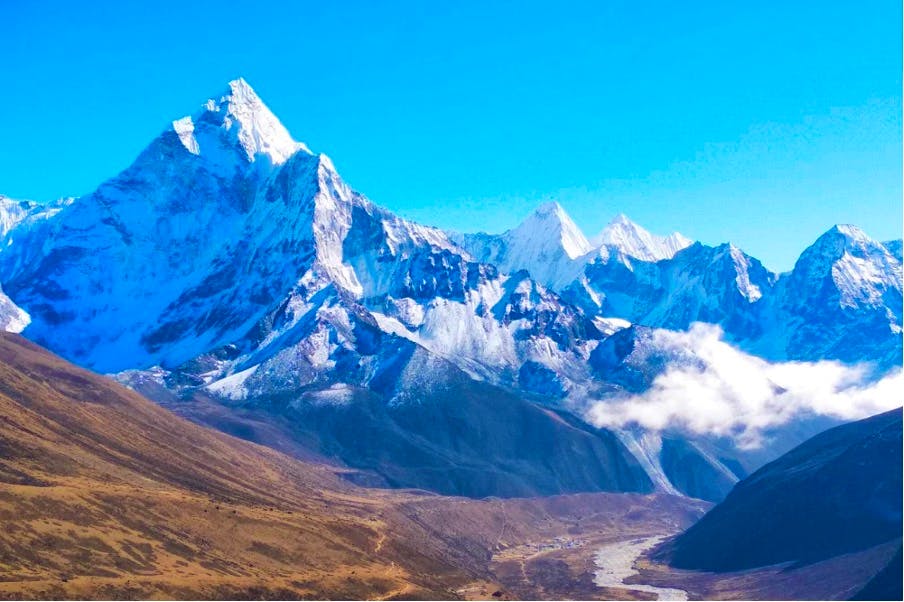
Best Seasons For Trekking
Spring (march, april, may), autumn (september, october, november).
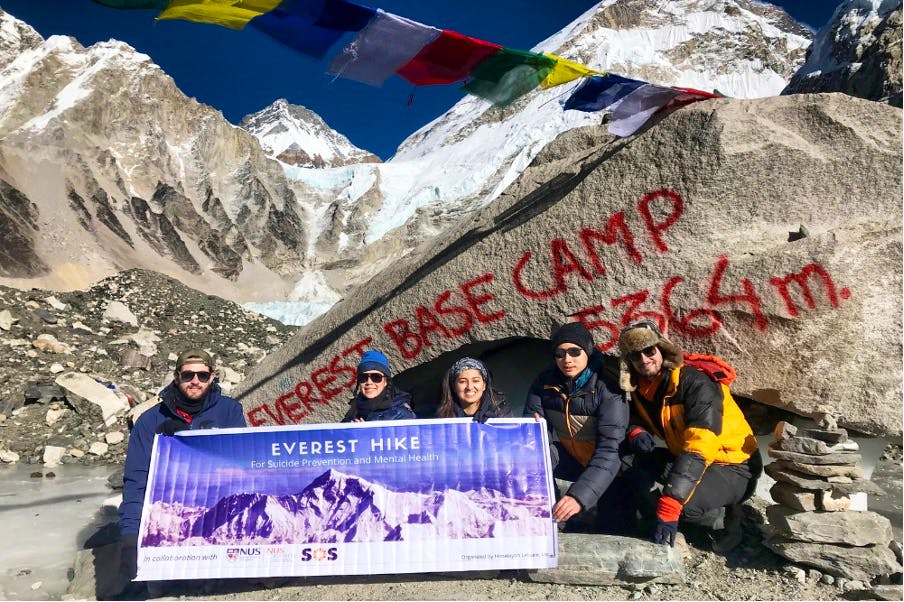
EBC Temperature and What to Expect
Daytime temperatures, nighttime temperatures, temperature variability as you ascend.
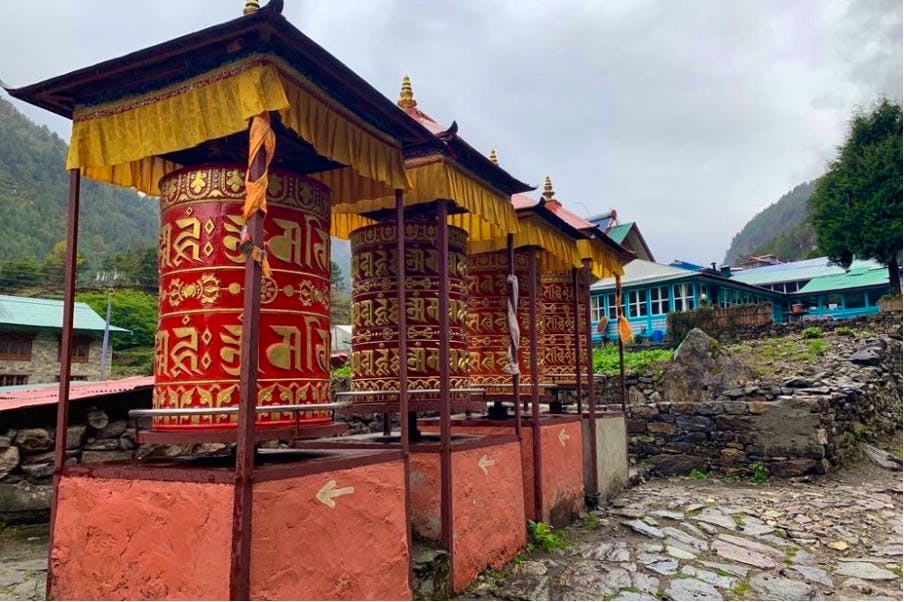
How to Prepare For Everest Weather: Our Top Tips
Layering is key, weather-resistant gear, stay informed.
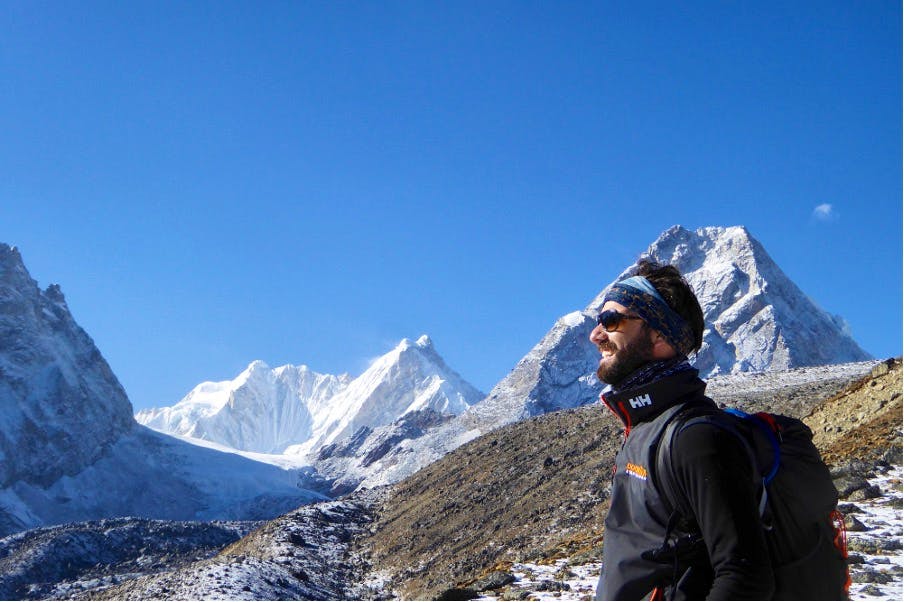
Emergency Essentials
A comprehensive first-aid kit.
A space blanket for warmth in extreme conditions.
Personal items, like lip balm, plasters, and more.
Mental Preparedness

More EBC Articles
A guide to EBC trek difficulty
How much does an EBC hike cost
A guide to travelling in Nepal
History behind Everest base camp
Our favourite view of Everest from base camp
Is hiking to Everest base camp safe
Annapurna base camp Everest
Everest base camp trek deaths
Is EBC suitable for a beginner hiker
Should I hike to EBC - is it worth it
Can I hike to EBC without a guide
What are EBC teahouses like
Everest base camp food
Popular EBC Trips
Everest base camp guided trek
Everest base camp short trek
Everest base camp via Gokyo
Find your next adventure
Mount Everest Base Camp Trek: EBC Trekking Guide For Nepal
The Mount Everest Base Camp Trek in Nepal is one of the world’s best bucket list hikes. In less than 2 weeks, you can trek to the foot of Mt Everest and other snowy peaks in the Himalayan mountains.
The good news is that it’s not a super difficult hike, and you don’t need a big budget to do it. The EBC trek is worth it for the fun and accomplishment alone, but you also get views of the Himalayas that are out of this world.
This travel guide will explain how you can do the Mt Everest Base Camp hike independently (with or without a tour guide), along with a recommended packing list and everything else you need to know before you go!
Best Everest Base Camp Tours
First of all, if you’d rather skip the hassle of planning your own EBC Trek, Klook has Everest Base Camp Tours starting as low as $900 USD for a full 12-day trek.
You may be able to find something cheaper than this once you land in Kathmandu, but booking online with a vetted tour company has some big advantages, and the reviews on their website are very positive.
We’ve used Klook for lots of tours and activities around the world, and they’re great! Highly recommended.
Book Now: Everest Base Camp Tours

When To Do The EBC Trek
The Mt Everest region has 4 different trekking seasons:
- March – May: High season. Best weather, with stable temperatures and bright sunny days, but the trails can get crowded. During these months you may share the EBC trail with pro climbers on the way to go summit Everest.
- June – August: Monsoon season. There’s a lot more rain during these months, and the trails are mostly empty.
- September – October: Clear days and busy trails. This is one of the most popular trekking seasons.
- November – February: Coldest season, but the weather is stable and dry. The trails are mostly clear.
I trekked in early February, and even though it was nice having the trail mostly to myself, the cold in the evenings and mornings was straight up misery.
My home state of Missouri can get very cold in the winter, but the cold has just never been my thing. If I could go back and change it, I would definitely do my Everest Base Camp hike later in the season.

Everest Base Camp Weather
Temperatures on the Mt Everest Base Camp Trek can range from 5 °C (40 °F) to 20 °C (70 °F) depending on month, and as low as -30 °C (-22 °F) at night during the winter months.
If you trek during the warmer months (Mar-May and Sep-Oct), the cold is not a big problem and shouldn’t be hard to cope with. Winter is a different story. Your snot will freeze in your nose at Gorak Shep.
Sunshine is key for winter trekking in Nepal, and thankfully you should have lots of sun in most months outside of the monsoon season. On my February hike, I often found myself shedding all my layers while trekking because I was heating up in the sun.
If you do your Everest Base Camp hike during the winter, the biggest issue is staying warm in the evenings and at night. For this, you’ll definitely want a top quality down jacket and sleeping bag.

All About Everest Base Camp Trekking
My everest base camp itinerary.
- Day 1: Kathmandu to Lukla to Benkar .
- Day 2: Benkar to Namche Bazaar .
- Day 3: Namche Acclimatization Day .
- Day 4: Namche to Deboche .
- Day 5: Deboche to Pangboche .
- Day 6: Pangboche to Dingboche .
- Day 7: Dingboche Acclimatization Day .
- Day 8: Dingboche to Thukla .
- Day 9: Thukla to Gorak Shep .
- Day 10: Everest Base Camp .
- Day 11: Kala Patthar to Gorak Shep to Pheriche .
- Day 12: Pheriche to Namche .
- Day 13: Namche to Lukla .

If you ever need motivation to keep going on the Everest Base Camp hike, just look at how much the porters are carrying!

Mount Pumori as seen from the Kala Patthar viewpoint, just a short distance from Mt Everest Base Camp.

Ama Dablam, one of my favorite mountains on the Mt Everest Base Camp Trek.
EBC Trek Packing List / Gear
This isn’t a complete list of everything to bring on a Mt Everest Base Camp Trek, and you may have to change things up a little depending on what month you go, but these are just some of the basics.
You can find most of this gear in Kathmandu, but in my opinion you’ll get higher quality and a wider selection if you order online.
- Beanie: I only wore this at night, but it definitely helped keep my ears warm.
- Down Jacket: Bring the biggest, warmest DJ possible. This is your most important piece of gear. You can use it as an extra cover at night.
- Fleece Sweater: This is the only jacket you’ll need to wear while trekking most days, especially if it’s sunny.
- Shirts: Something comfy with quick dry material.
- Trekking Pants: Something lightweight and breathable.
- Thermal Underwear: May not be needed if you trek in the warmer months.
- Gloves: I only wore these at night, but they definitely helped keep my hands warm.
- Socks: Merino wool is best for staying warm and stopping moisture.
- Headlight: Smart to have at least a small one, just in case.
- Tumbler: 1 liter water bottle to refill daily on the trek.
- Sunblock: It’s easy to sunburn at high altitudes. A small bottle is plenty.
- Sunglasses: Good for snow. May not be necessary unless you plan to hike a mountain pass like Cho La.
- Hat: I wore old faithful throughout the hike.
- Watch: An altimeter watch would be fun to play with here.
- Camera: Duh. You can’t do the Mt Everest Base Camp Trek without taking lots of pictures.
- Power Bank: Bring a big power bank and you might only need to recharge it once on the whole trek.

Everest Base Camp Trek Cost
For a 13 day trek, I paid about $21 USD per day for food, drinks, and room. Porter/guide was an extra $25 per day, although it’s not a requirement. Flights to Lukla were $330 return, but again not a requirement if you hike in.
You can read the sections below for more info on the daily trekking costs and what you get for your money. It’s not a very expensive trek, all things considered!
Keep in mind, these numbers are from 2020. They’ll go up a little over time. Exchange rates may also vary, so check the latest rates .

The flight to Lukla from Kathmandu is $165 USD each way. You can shop for flights to Lukla at Skyscanner.
If your budget is tight or you have extra time, you can skip this flight by hiking from Jiri to Lukla rather than flying. It only adds a couple days to the itinerary.

Guide / Porter / Solo
You can do the EBC trek with a guide, porter, OR independently (solo).
A guide will show you the way to Mt Everest Base Camp and help with lodging, navigation, advice, taking pictures for you, etc. A porter-guide will do these same things and also carry a 20 kg (45 lb) pack for you.
A porter or guide is NOT a requirement to do this hike, especially if you go in the warmer months when you may not need as much gear. In 2023, they were supposedly introducing a guide requirement for EBC, but so far that has not been enforced at all, thankfully.
With that said, there are some good advantages to hiring a guide, and it’s pretty cheap by Western standards. A porter is only $15 or $20 USD per day, and a porter-guide is $25 per day. A popular arrangement is to hire one porter for two hikers, splitting the cost and still making things easier for both of you.
In the end, this all depends on your budget and hiking preferences.

Hiking Fees
If you’re hiking EBC independently, you’ll need to be aware of two fees you have to pay near the start of the trek.
There’s a local government tax that they’ve now started collecting in Lukla. This one is currently 2,000 Rupees ($17 USD).
There’s also an Everest park fee/ticket you have to pay at the Sagarmatha National Park entrance just beyond the small village of Monjo, Nepal. This one is currently 3,500 Rupees ($30 USD).
No TIMS card is needed anymore for independent hikers. That fee has been retired for the Mount Everest Base Camp Trek.

Accommodation & Amenities
Throughout the Everest Base Camp hike, you’ll stay and sleep at small guesthouses along the way, called teahouses.
This is where you get your meals and drinks for the trek, along with the occasional amenities like showers, charging, or WiFi. The teahouses start out decent, but quickly get more shabby as you go further up the trail.
You have to pay for everything you use, of course, and the prices get quite high as you go, because everything has to be hauled up on the backs of the poor porters.

Guesthouses
The teahouses on the EBC trek are cold and dingy, with drop toilets and cracks in the walls. Don’t expect luxury.
Most rooms are free as long as you buy your meals there (the meals are how they make their money). If you stay at a lodge and don’t eat there, you’ll be expected to pay for the room.
In some cases, I was charged 500 Rupees for a room on top of my meal costs. I’m not sure why some teahouses do this and others don’t, but I never paid more than 500 Rupees for a room, and most were free with the meals.

Food & Drink
I’m happy to report that the food and drinks on the Everest Base Camp hike are top notch, especially after you’ve worked up an appetite trekking.
You have western food choices, or the standard local staples like veggie fried rice, steamed momos (dumplings), and mushroom soup. Everything was hot and fresh. Meal prices for these ranged from 250 to 750 Rupees depending on altitude. Not too bad.
For drinks I tried hot chocolate, lemon/apple/mint tea, and occasionally bottled water for my tumbler. These ranged from 100 to 400 Rupees. If you want to avoid plastic bottles, there’s usually boiled water available and this is safe to drink too.
Getting enough water on the trek is never a problem. Just fill up a 1 liter tumbler in the morning, and this will last you until evening, especially since you’re likely to pass more tea houses along the trail as you’re hiking throughout the day.

Showers are only available at a few lodges, depending on the season and how high up you are, and they cost 600 to 1200 Rupees. In the winter, water higher up will be frozen most of the time.
I never had a shower on my February EBC trek, and that seems to be the norm (although I got one or two opportunities in Namche). Yes, it’s gross. I could smell myself by trek’s end, and it wasn’t pretty.
But aside from the fact that I hate to fork out money for something as basic as a shower, I also never really got close to other people for very long on the trek, so I didn’t feel too guilty about it.
Most days were cold enough that the thought of stripping down for a shower was not really appealing, either. Your best bet is baby wipes and deodorant.

WiFi / Cell Service
WiFi costs anywhere from $5 to $10 USD per day if you buy it from the teahouses.
Alternatively, you can buy a 10 GB/30 Day Everest Link WiFi card in Namche Bazaar and use this for the entire EBC trek. During my Mount Everest Base Camp Trek the WiFi was down across the whole region, so unfortunately I wasn’t able to use either of these options.
I bought an Ncell local SIM card in the Kathmandu airport and had 3G service for half the days of the Everest Base Camp hike. Coverage is still improving in the area, so if you need to stay connected I’d definitely bring a local SIM.

Electricity
All of the teahouses on the way to Mt Everest Base Camp sell outlet charging for electronics, and the prices range from $2 to $10 USD for a full charge, depending on how far up the trail you are.
The key is to bring a big power bank and then use this to charge all of your other electronics (phone, camera, etc). I did this and only paid once to recharge my power bank on the whole trek.

How Much Cash To Bring
Everything you buy during the Everest Base Camp hike (meals, WiFi, charging, etc) will have to be paid for with cash. Credit cards won’t work. There are no ATMs outside of Lukla and Namche Bazaar (Days 1-4), and even the ATMs there are not reliable.
What this means is that you’ll have to withdraw enough cash (Nepalese Rupees) at an ATM in Kathmandu to cover your entire trek. The ATM fees will bite you, and I hate to carry large amounts of cash, but it’s not really avoidable here.
All up, I spent about $20 USD (2,400 Rupees) per day on the Mount Everest Base Camp Trek, and never spent more than $25 USD in a single day. With that said, I didn’t splurge on WiFi, showers, charging, or alcohol. The only things I bought were the bare necessities: room, food, and drinks.
If you hire a porter/guide, you don’t need to factor that into your daily cash carry. That’s paid before the trek starts. But do reserve a little cash for a decent tip.

Mount Everest Base Camp Trek Difficulty
I’m not going to lie, this is a difficult trek. And if you do it in the winter like I did, it’s even harder. With that said, if you are in decent shape, determined, and obey the guidelines for altitude sickness prevention (more on that below), then you’ll have no problem reaching base camp.
There is a lot of elevation gain and loss on this hike. At times near Lukla, the constant ups and downs will make you feel like you’re hiking a roller coaster, but the trail is never too steep or dangerous. After Namche, it’s mostly a slow uphill plod.
This trek has been completed by old seasoned hikers in their 70s, and young kids in their pre-teens. It’s also been flunked by healthy 20-30 somethings who try to push through it quickly without enough acclimatization to altitude.
Patience and discipline are key for trekking to Everest Base Camp. Slow and steady wins the race here.

Trekking Distance
The one way trekking distance from Lukla to Mt Everest Base Camp is about 65 kilometers (40 miles).
That means the total roundtrip distance of an EBC Trek is about 130 kilometers, even if you don’t do any of the detours.
Don’t let that scare you off. It’s a lot of hiking, but every step is worth it.

Altitude Sickness
By far your biggest danger on the Mount Everest Base Camp Trek is altitude sickness, also known as Acute Mountain Sickness (AMS).
No one is immune to this, and it doesn’t matter how fit you are. If you gain altitude too fast, you can get sick and in some cases even die. Plenty of people have died from AMS on the EBC Trek.
The problem is that overzealous hikers push the envelope on this hike all the time, and a lot of them end up needing a very expensive helicopter evacuation to lower ground.
The best way to avoid altitude sickness is to go slow . At altitudes above 3,000 meters (10,000 feet), don’t increase your sleeping elevation by more than 300-500 meters (1,000-1,500 feet) per night.
Every 1,000 meters (3,000 feet) you should also spend a second night at the same elevation. If you get a bad headache, dizziness, or nausea, descend to a lower altitude until you feel better. As long as you follow these general guidelines, you shouldn’t have any issues.
You can take Diamox (acetazolamide) on the trek for extra AMS prevention. This medication can be found in Kathmandu or Namche. I bought mine in Namche and it seemed to help my headache and slight foggy feeling. I didn’t have any side effects aside from the usual tingling toes/fingers.

Everest Base Camp Altitude
The Mount Everest Base Camp altitude is 5,364 meters (17,598 feet). At this elevation, there is 50% of the oxygen at sea level.
However, most treks also go to Kala Patthar, a viewpoint even higher than base camp where you can get the best views of Mount Everest.
The elevation at Kala Patthar is 5,644 meters (18,519 feet). From there, you’ll be rewarded with an incredible panorama of Mount Everest and other icy peaks like Pumori, Lhotse, and Nuptse.
Happy travels!

If you’d rather skip the hassle of planning your own EBC Trek, Klook has Everest Base Camp Tours starting as low as $900 USD for a full 12-day trek.
You may be able to find something cheaper than this once you land in Kathmandu, but booking online with a vetted tour company has some big advantages, and the reviews on their website are very positive for this Mt Everest Base Camp tour.
More Nepal Travel Tips
Hopefully you were helped by this guide for the Everest Base Camp Trek. Let me know in the comments below if I can help answer any questions.
Don’t forget to check out my complete Nepal Travel Guide with tips, info, photos & more!
You may also like
Dhigurah island: budget paradise in the maldives, 10 best hikes in aruba: family friendly trails, how to visit tanjung puting national park in indonesia, banggai islands travel guide & itinerary for sulawesi indonesia, paisu pok lake in banggai: bluest lake in indonesia, samet nangshe viewpoint: best sunrise spot in thailand.
So much useful detailed information.
Thanks for the straight forward information. Beautiful photos

Leave a Comment Cancel Reply
Save my name, email, and website in this browser for the next time I comment.
Everest Base Camp Trek Weather and Temperature
Ganesh adhikari.
- Last Updated on Mar 26, 2024
If you are planning to trek to Everest base camp , then you have to read this blog. It will provide you with detailed information on the weather and climate in the Everest region throughout the year. You will learn the best time to do the Everest base camp trek and other necessary information related to Climate, weather , and temperature .
Everest region is known for its ever-changing and unpredictable weather pattern. Even during the peak trekking seasons- spring and autumn, you have to be prepared for all kinds of climate fluctuations. The upper part of the Everest region is mostly cold in the morning and night despite the time you are trekking.
Given the very complicated weather in the Everest region, proper knowledge is important for a comfortable trekking experience. Read below to learn about the Everest base camp trek temperature by month and much more information.
Table of Contents
Everest base camp trek weather and temperature updated guide 2024, spring season (march to may).
The spring season includes months from March to May. The Everest base camp trek in spring is the peak time for trekking. The spring season has stable weather with a moderate climate and great visibility. Many trekkers visit the Khumbu region to witness its beauty in the spring season. You will get to meet lots of fellow trekkers from different countries on the trail, but it might get a bit crowded.
However, the greenery and pretty flowers, especially in lower areas like Lukla, Phakding, Monjo, and Benkar, pay for the bustle. The rhododendron flowers bloom, making the trail even more beautiful. Spring is great for seeing rare animals and birds along the way. The sky is clear, and the days are warm with fantastic views. Nights are chilly, but the adventure is truly amazing!
Pros of Everest Base Camp trekking in spring:
- Moderate temperatures
- Breathtaking views
- Flora in bloom
- Longer days
- Comfortable lodge stays
Cons of Everest Base Camp trekking in spring:
- Crowded trails
- Higher costs
- Unpredictable weather

Everest Base Camp Trek in March
Temperature during the day: -10°C to 0°C (14°F to 32°F)
Night temperature: Up to -15°C (5°F)
Daily sunshine hour: 6 to 7
Humidity: Dry and comfortable trekking environment
Wind speed: Mild to moderate (5300m or slightly less)
In March, the spring season starts. The weather gradually gets stable, and the temperature increases. The upper part of the trail remains cold in March, but the trekking condition gets better. There can be occasional snowfall in March, but overall, you can do the EBC trek in March month. The views are surreal, and the Lukla flights are mostly on time.
The daylight hours increase with the beginning of March. The temperature ranges from 7°C to -12°C. You have to be well packed for cold while trekking in March. The trekkers return to the region, and the trail slowly begins to bustle. During the day, the climate is warm and gets cold at night and in the morning.

Everest Base Camp Trek in April
Temperature during the day: -5°C to 5°C (23°F to 41°F)
Night temperature: Up to -10°C (14°F)
Daily sunshine hour: 8 to 9
Humidity: Low
Wind speed: 5300m or slightly less
By April, it becomes the best time to explore the Everest region with stable weather, moderate climate, and clear mountain views. The lower part of the trail bloomed with thousands of rhododendrons and other diverse vegetation. The bustle of trekkers returns to the EBC trail, making the environment happy and lively.
The temperature ranges from -5°C to 10°C. The daytime is warmer. Everything related to weather and climate is just perfect in April for the Everest Base Camp trek. You can freely extend the EBC trek to other parts of the region, such as Gokyo Lakes , Three Passes , Ama Dablam Base Camp, etc.

Everest Base Camp Trek weather in May
Temperature during the day: 15°C to 25°C (59°F to 77°F)
Night temperature: -5°C to 0°C (23°F to 32°F)
Daily sunshine hour: 9 to 10
Humidity: Moderate
Wind speed: Mild (5300m or slightly less)
May is the peak time for mountaineering in the Himalayas. Likewise, it is also a great time to enjoy trekking. Once you go above 3,000 meters, the climate gets moderate. The lower part of the Everest region is a bit on the hot and humid side. The temperature touches 30°C during the daytime. The nights and mornings are cold, though.
Many trekkers explore the Everest region in May. The long daylight and pleasant climate present lovely trekking conditions. The Lukla flights are stable, and you can easily opt for helicopter flights in and out of the Everest reign. May offers quite a flexibility to change the itinerary or add further activities in the package anytime.
Ace Vision Treks is known as an ex-guided Trekking Company based in Kathmandu Nepal. So, In my personal experience, I highly recommend the Spring season May is the best time for Trekking and adventure outdoor activities in Nepal.

Monsoon/Summer Season (June to August)
Following the spring months, Nepal transitions into summer/monsoon from June to August. During this time, trekking trails in the Everest region become damp, occasionally slippery, and muddy due to heavy monsoon rains.
Summer is generally considered less favorable for trekking to the base of Mt. Everest due to frequent downpours and cloudy weather. The high part of the region experiences quickly changing and sometimes harsh weather conditions, making trekking uncomfortable.
Additionally, the risk of avalanches near Everest Base Camp increases during the summer period. There's also a possibility of landslides in lower mountainous areas. The number of trekkers on the trail is significantly low, and the paths are nearly empty throughout the season.
You can do the Everest base camp trek in summer/monsoon, but the overall journey will be quite demanding.
Pros of Everest Base Camp trekking in summer/monsoon:
- Lush greenery
- Fewer crowds
- Lower costs of accommodations and meals
Cons of Everest Base Camp trekking in summer/monsoon:
- Heavy rainfall, therefore bad trail condition
- Limited mountain views
- Increased risk of leeches and insects on the way
- Difficult river crossings
- Lukla flight disruptions
Everest Base Camp Trek in June
Temperature during the day: 5°C to 25°C (41°F to 77°F)
Night temperature: Around 0°C degrees Celsius (32°F)
Daily sunshine hour: 6 to 7
Humidity: High humidity with occasional rain
Wind speed: Fluctuate a lot depending on weather conditions
June is the beginning of the summer and rainy seasons. The climate is hot and humid, especially in Kathmandu and the lower part of the Everest region. The weather gets quite unpredictable and poor, affecting the Lukla flights. Likewise, the views may be obstructed because of a cloudy sky. It is an off-time for the Everest Base Camp trek.
The temperature in June goes from a maximum of 16°C, and a minimum of -1°C. The upper part of the Everest region gets cold in the mornings and nights. There are not many trekkers on the way. The cost of accommodation, meals, and Lukla flights decreases.

Everest Base Camp Trek in July
Temperature during the day: 10°C to 20°C (50°F to 68°F
Night temperature: Around 5°C (41°F)
Daily sunshine hour: 5 to 6
Humidity: High humidity with frequent rainfall
Wind speed: Fluctuate a lot depending on weather conditions
With the start of July, the rainfall gets regular. The trail from Lukla to Namche Bazaar and Tengboche is at its worst because of rainfall. There are muds and leeches everywhere on the way. Risks of landslides are high, along with unclear views and slippery tracks. The climate is very inconsistent. You will feel hot and cold simultaneously.
The humidity level is high. The trail is empty, and the prices of accommodation, meals, etc, are low. Despite all these cons of summer/monsoon season, the vegetation, rivers, streams, and waterfalls along the EBC trail thrive in this month. It is the best time to study the biodiversity of the Everest region.
The temperature ranges from 17°C in the daytime to 2°C at night. If you are thinking of doing the Everest Base Camp trek in July, have contingency days and properly plan the trip.

Everest Base Camp Trek in August
Night temperature: Up to 5°C (41°F)
Humidity: High humidity with regular rainfall
August is the final month of summer/monsoon. The climate is quite hot, going above 30°C. Likewise, the rainfall is also heavy and regular. The trails are wet, muddy, and slippery. Given poor weather and bad trail conditions, August is not a good time for the EBC trek. Also, the risk of landslides is quite high in the lower part of the region.
The Lukla flights are not on time, and visibility is low. Trekking in August is not recommended unless you do not mind bad weather. The rivers and streams are full, so crossing them is risky as well. The climate remains either too hot or cold. August is also a low time for Everest base Camp trekking.

Autumn Season (September to November)
Autumn is the Everest Base Camp trek's best time. The weather from September to November is at its most stable, offering crystal clear skies and unobstructed views. The cloudless sky offers clear mountain views and picturesque landscapes. The lush greenery and autumn flowers add a burst of color to nature. Wildlife thrives in dry conditions.
It's neither too hot nor too cold, making the journey enjoyable. While temperatures at higher elevations are lower than those at lower elevations, the overall climate is favorable for trekking. Autumn is the ideal season for exploring various trekking routes in the Everest region. Contact us to do the Everest base camp trek in autumn . We have the best cost.
Pros of Everest Base Camp trekking in autumn:
- Stable weather
- Colorful landscapes
- Festivals and cultural experiences
- Lodge availability
Cons of Everest Base Camp trekking in autumn:
- Higher costs of accommodations and meals

Everest Base Camp Trek Weather in September
Temperature during the day: 10°C to 20°C (50°F to 68°F)
Night temperature: Around 0°C (32°F)
Daily sunshine hour: 7-8
Humidity: Low humidity levels
Wind speed: Moderate (around 5300m)
In the Everest region , September marks the end of monsoon, but rainfalls in Kathmandu and the lower part of the Solukhumbu region till the third week of this month. You can do the Everest Base Camp trek in September, as this month starts one of the best times for trekking in the Himalayas. Note that you may come across occasional rainfall, but it will not affect your trek that much.
The weather gradually begins to get stable, and chillness in the air increases. The temperature goes up to 25°C to 20°C in the lower elevation. Whereas the upper part of the trail sees temperatures ranging from 2°C to 10°C. The trails slowly begin to see the bustle of the trekkers from around the world, and the trail condition also gets better. The mountain views are clear and better.

Everest Base Camp Trek Weather in October
Night temperature: -10°C to -5°C (14°F to 23°F)
Daily sunshine hour: 8-9
Humidity: Low with a dry and pleasant climate
As October starts, the weather stabilizes with no clouds, mist, or fog. The daylight hours increase by 8 to 9 hours per day, giving a lot of time to trekkers to enjoy the views. There is less chance of rainfall or snowfall, which makes the trail condition fantastic. Likewise, there is a hint of cold in the air, and the climate slowly dries.
Because of the monsoon season, the rivers, streams, and waterfalls all are in their best condition. Likewise, the vegetation also thrives before it loses all the colors and changes into beautiful hues of browns, oranges, and reds. Once again, The EBC trail gets packed with travelers from around the world, making the environment quite lively.
Overall, October is the best time to do the Everest Base Camp trek . There is less chance of Lukla flights seeing long delays or cancellations. All the lodges are open. The temperature ranges from 12°C daytime to a minimum of -6°C at night and morning.

Everest Base Camp Trek Weather and Temperature in November
Night temperature: -15°C to 5°C (5°F to 32°F)
Daily sunshine hour: 8
November is the final month of the autumn season. It is also the last month in the year to enjoy Everest Base Camp trekking without worrying about the weather and climate. The soft, crisp breeze with sunny, bright daylight makes trekking excellent. The mountain views are breathtaking, and the climate remains stable, with great hiking trail conditions.
The temperature ranges from 6°C to -12°C in November in the Everest region. At the beginning of this month, the trail seemed the bustle of the trekkers, and by the end week of November, most of the trekkers left the region. Likewise, towards the end of this month, there can be snowfall in the upper part of the trail. Autumn season November is the best time to do EBC trekking in Nepal .

Winter Season (December to February)
The days are shorter than the nights in the winter season. The weather is stable and dry with freezing temperatures. Throughout the winter, the entire Everest region remains dry and crystal-clear, with occasional morning mist and snowfall. Thick layers of snow cover most places surrounding the peaks.
During winter, most lodges are vacant and are available at a low cost. Despite the chilly temperatures, trekking to Everest Base Camp in winter remains possible with the right gear and preparations.
In mid-winter, nighttime temperatures may plummet to as low as -30°C (-22°F), however, the lower elevations offer comparatively milder conditions, with sunshine during the day making for comfortable walking.
It's worth noting that alternative routes such as Everest High Passes trek , Mera Peak climbing , and Gokyo Lakes trek might be closed due to the lower number of tourists, heavy snowfall, and extreme cold.
Pros of Everest Base Camp trekking in winter:
- Fewer crowd
- Clear mountain views
- Low costs of accommodations and meals
- Unique winter scenery
- Dry weather
Cons of Everest Base Camp trekking in winter:
- Cold temperatures
- Shorter days
- Limited lodge availability
- Risk of Lukla flight disruptions
- Bad trail conditions

Everest Base Camp Trek in December
Temperature during the day: 5 to 12 degrees Celsius (41 to 54 degrees Fahrenheit)
Night temperature: -10 to -5 degrees Celsius (14 to 23 degrees Fahrenheit)
Daily sunshine hour: 7
Humidity: Low with cool and crisp air
Wind speed: Moderate to strong (5500m or higher)
December is the first month of the winter season. With the beginning of December starts the deep and dark winter in the Everest region. The weather challenges get high. In the early days of this month, you can do the Everest base camp trek with not many hurdles. However, as the days pass by, the weather begins to get very unpredictable, and the cold increases extremely.
The temperature during the daytime ranges from -5°C to 5°C (23°F to 41°F). Likewise, during the night, the temperature plunges to -15°C to -20°C (-5°F to -4°F). Compared to the lower part of the EBC trail, the upper region is very cold. Similarly, there is also the chance of snowfall in December, which increases the complexity of the trail.
In the early morning hours, there may be fog. Likewise, as the sun rises, the sky becomes clear. Compared to November, the crowd is significantly lower, and the trails are almost empty. If you are trekking to the Everest Base Camp in December, stay updated with Everest Base Camp Trek Weather and Temperature.

Everest Base Camp Trek in January
Temperature during the day: -20°C to -10°C ( -4°F to 14°F)
Night temperature: Around -25°C (-13°F) or even lower
Daily sunshine hour: 6-7
Humidity: Low with a dry climate and snowfall
By the beginning of January, the winter is at its highest level. This month has extreme cold. The temperature drops as low as -20°C (-4°F) and lower some time. During the daytime, the temperature hovers around 6°C (42.8°F). The nights and morning hours are the coldest and require a high-quality insulating sleeping bag if you are trekking to the base camp of Mt. Everest in January.
January is not a favorable time for Everest Base Camp trekking , and the trail is all empty. You may come across 1-2 trekkers on the way, which is also rare. The Lukla flights are not on time, and the weather is very unstable. Snowfall is common at higher elevations, and if the weather gets bad, some sections of the trails might get closed, too.
The Everest Base Camp trek in January requires lots of planning and preparation. Even though the challenges are high during this month, the serene surroundings and surreal winter landscapes make trekking quite memorable. We highly recommend having 1-2 contingency days in your Everest Base Camp trek itinerary if you are trekking in January in case you come across very bad weather or face delay/cancellation in the Lukla flight.

Everest Base Camp Trek in February
Temperature during the day: -15°C to -5°C (5°F to 23°F)
Night temperature: Around -20°C (-4°F)
Daily sunshine hour: 6
February is the last month of the winter season. The cold is at its peak, and by the end of the month, the climate gradually begins to see life. Trekking to EBC in February is also very challenging and full of uncertainties. With short daylight hours, snowfall, and extreme cold, the challenges of the trek are the highest.
The temperature during the daytime reaches up to 8°C (46.4°F) and nights and morning hours see -15°C (5°F) and lower. The trail remains empty in February as well. Towards the end of February, there can be some trekkers. On clear days, the mountain views are breathtaking. You can do the Everest Base Camp trek in February with proper planning and contingency days in the Trekking itinerary.

Frequently Asked Questions About Everest Base Camp Trek Weather, Temperature, Best Time
How cold is the trek to Everest Base Camp?
The cold along the Everest Base Camp trail varies from one season to another. During the peak trekking seasons, temperatures at lower elevations are generally mild, ranging from 10°C to 20°C (50°F to 68°F). However, as trekkers ascend to higher altitudes, particularly above 4,000 meters (13,000 feet), temperatures can drop significantly.
What is the coldest month at Everest Base Camp?
The coldest month at Everest Base Camp is generally January. During this month, temperatures can drop significantly, with daytime temperatures ranging from -10°C to -15°C (14°F to 5°F). Nighttime temperatures are even colder, often reaching -20°C (-4°F) or lower.
How do you stay warm on the Everest Base Camp trek?
To stay warm during the Everest Base Camp trek, prioritize layering clothing. A thermal base layer helps trap body heat while insulating layers such as fleece or down jackets provide additional warmth. A waterproof and windproof outer layer is essential to protect against the harsh elements. Likewise, wear insulated gloves, socks, a hat, and a neck gaiter or scarf.
Does Everest Base Camp always have snow?
While Everest Base Camp itself doesn't always have snow, the surrounding landscape and higher elevations often do, particularly during the winter months.
Which month is best for the Everest base camp trek?
The best months for the Everest Base Camp trek are generally considered to be either April or October. During these months, the weather is relatively stable, with milder temperatures, long daylight hours, and clearer skies. Both of these months provide favorable conditions for the trek, allowing trekkers to enjoy stunning views of the Himalayan peaks.
What is the warmest temperature in Everest Base Camp?
The warmest temperatures along the Everest Base Camp trail can range from 10°C to 25°C (50°F to 68°F) in spring and autumn. The lower part of the trail may see temperatures increasing up to 30°C (86°F).
How cold is Everest Base Camp in summer?
While summer is not an ideal time for the EBC trek, the temperature can still be quite chilly at higher elevations and the base camp. In June, July, and August, the summer months, the temperatures can range from 5°C to 15°C (41°F to 59°F) during the day.

Does it rain on Everest?
While EBC itself does not experience rainfall, the surrounding regions, including the Everest Base Camp trekking route, can be affected by monsoon rains. From June to August, the monsoon season brings heavy precipitation in the Everest region. The lower elevations along the trekking route may experience rain, and the higher altitudes can receive snowfall.
Is the Everest Base Camp trail open all year?
Yes, the Everest Base Camp trail is technically accessible throughout the year, but the feasibility of trekking largely depends on weather conditions and seasonal variations. While it is possible to trek during these less favorable times, it requires careful planning, appropriate gear, and a higher tolerance for challenging weather conditions.
Is it possible to trek to Everest Base Camp during the monsoon season?
Trekking to Everest Base Camp during the monsoon season is possible but comes with additional challenges. The region experiences heavy rainfall in monsoon, making the lower parts of the trail slippery and increasing the risk of landslides. The monsoon can also obscure the stunning views of the mountains, impacting the overall trekking experience.
Are there any specific gear recommendations for the Everest Base Camp trek?
Key recommendations include a well-insulated and waterproof jacket, pants, and sturdy, waterproof hiking boots to navigate varying terrains and weather conditions. Layering is crucial, so pack moisture-wicking base layers, insulating mid-layers, and a quality down or synthetic-filled jacket for warmth. Follow our EBC trek packing list for more detailed information.
How do weather conditions impact flight schedules to and from Lukla, the starting point of the trek?
Weather conditions significantly impact flight schedules to and from Lukla. The short airstrip and challenging terrain at Lukla make it sensitive to adverse weather conditions. Flights are often operated by small aircraft, and factors such as fog, rain, snow, or high winds can lead to delays or cancellations.
Need travel inspiration to the Himalayas? Check out my other updated travel blogs below:
- The Reality of Everest Base Camp Trek Difficulty
- Attractions of Everest Base Camp Trekking
- Everest Base Camp Trek vs Other Treks in Nepal
- Everest Base Camp Trek vs Manaslu Circuit Trek - Which is Better?
- Manaslu Circuit Trek Weather and Temperature , Best Time 2024
- Trekking in Nepal - A Complete Travel Guide
- Adventure Travel Ideas

Ganesh is an adventure outdoor enthusiast originally from Gorkha, Nepal. I hiked Everest, Annapurna, Langtang, and Manaslu region and the most famous teahouse trekking in Nepal. Besides Hiking, I provide online travel packages for travelers to value their time with family and friends. As well, I always provide updated travel information about the Himalayas! what's Going on? let's keep and touch with me for an unforgettable travel experience in a lifetime. I organize private tours for hikers per your interest and time frame.
Ask a Question

Discover Real Experience Why Visit Nepal

Manaslu Region Trekking Routes

Everest Region Trekking

- Cultural Trips
- Wildlife Expeditions
- Destinations
- Outdoor Programs
- Discover trekking
- Health and fitness
- Experiential learning
- Trekking tips
- Outdoor skills
- Trekking gear
Everest Basecamp Trek Temperature and Weather
Are you aware of how cold it gets on your Everest Basecamp trek? Do you know the average temperature you should expect on this trek? Whether you are trekking in spring, summer, autumn or winter, if you are well-informed about the Everest Basecamp Trek temperature and weather, you can tackle the weather across seasons and trek comfortably.
The Everest Basecamp Trek temperature depends on the season you choose. As the trek takes you to a higher altitude, the temperature remains low as you are at a higher elevation from sea level. EBC experiences pleasant weather and temperatures in spring and autumn. Although some trekkers attempt the EBC trek in winter, the weather is extreme, and the cold becomes unbearable.
Use this detailed Everest Basecamp trek temperature and weather guide to plan your trek based on your preferences and interests.
Everest Basecamp Trek Monthly Temperature Details
Ebc trek weather in winter – december to february .
Everest Basecamp Trek in winter registers a minimum of -17°C. The temperature remains low throughout the day, and the number declines to minus. The winter months of December, January and February are the coldest to trek to the EBC.
Expect snowfall on the trail and extreme cold. The days are comparatively warm if the sun shows up, but nights are chillier, and the temperature reaches a freezing point with harsh weather conditions.
Everest Basecamp Trek Temperature in December
Everest Basecamp trek temperature in December ranges between -14°C to -1°C in and around the basecamp regions. The lower region experiences slightly warmer temperatures. Early morning and night register the lowest temperatures.
Everest Basecamp Trek Temperature in January
EBC trek temperature in January declines further, making it extremely difficult to trek. The amount of snow also obstructs your speed on the trail. Expect a maximum of 0°C and a minimum of -17°C at the base camp.
Everest Basecamp Trek Temperature in February
You experience comparatively warm weather at the base camp in February. EBC trek temperature in February touches a minimum of – 13°C. Day temperature hovers around 4°C. You can expect clear sunny days offering crisp mountain views.
EBC Trek Weather in Spring – March to April
After the winter cold wears off, the temperature increases, and you will have bright days. Spring is one of the most loved seasons owing to pleasant weather and comfortable temperatures. March and April register pleasant temperatures and delightful weather. You will have longer daylight hours and a warm trail to trek in spring.
Everest Basecamp Trek Temperature in March
EBC trek temperature in March is sub zero at higher altitudes. Lower regions have bearable temperatures. The day features bright and sunny days. Brace for cold and chilly nights with sub-zero temperatures. March in the Everest base camp has a maximum of 7°C during the day to a minimum of -12°C in the morning and night.
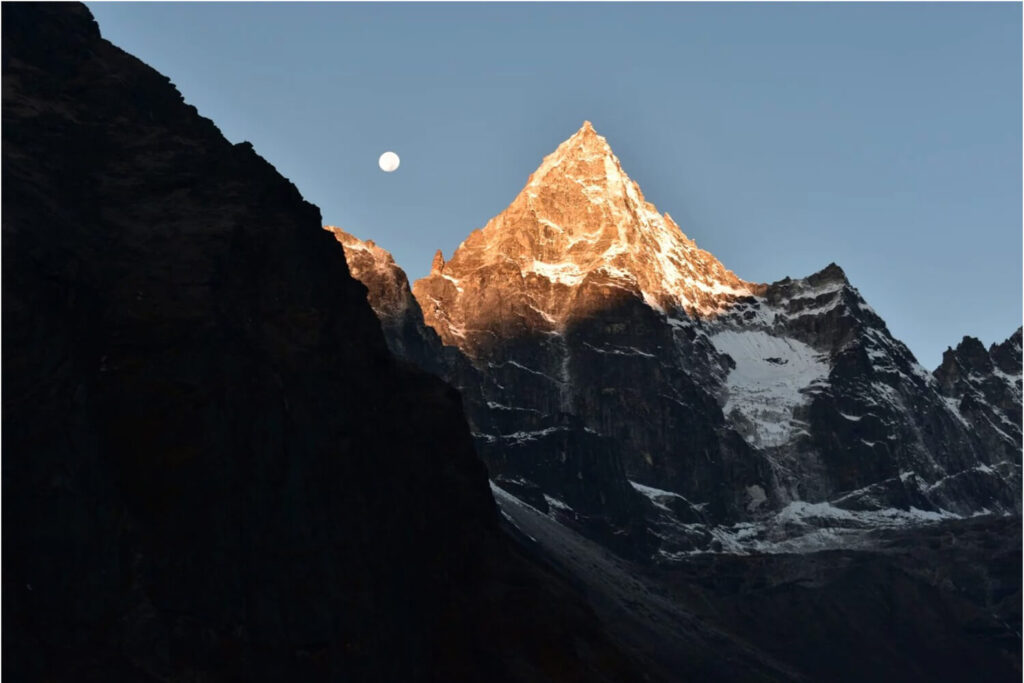
Everest Basecamp Trek Temperature in April
EBC registers a slight increase in temperature in April. The temperature in April ranges between 10°C in the daytime to min -5°C in the nights and early mornings. April has warm and sunny days with clear weather offering magnificent views of the big mountains.
Everest Basecamp Trek Temperature in May
EBC trek temperature in May is comfortable compared to spring months. May marks the beginning of summer in EBC. The lower campsites will be sunny and hot. You can trek during the daytime in a T-shirt. However, the nights will be cold.
May temperature in EBC touches a maximum of 15°C in the daytime and a minimum of 0°C at night and early mornings. Haze on the trail obstructs mountain views in summer. Plan your EBC in early May to enjoy breathtaking mountain views.
EBC Trek Weather in Autumn – September to November
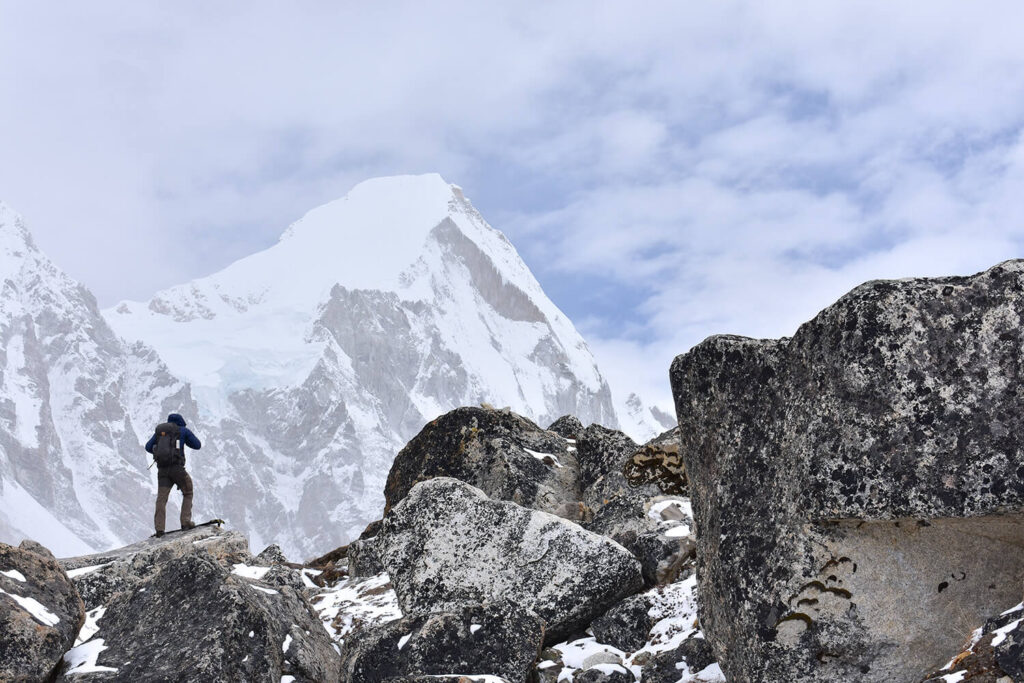
Autumn arrives in EBC by September end and continues till mid-November. The temperature remains mild and has favourable weather conditions. Expect stable weather during the day. Nights and early mornings will be cold. Weather remains clement in autumn, featuring long daylight hours and a warm trail.
Everest Basecamp Trek Temperature in September
EBC trek temperature in September reaches a maximum of 15°C and declines to 0°C at night. Monsoon rain extends to the first week of September. Come prepared with rain gear if trekking in early September.
Everest Basecamp Trek Temperature in October
EBC trek temperature in October reaches 12°C during the daytime and touches a minimum of -6°C at night. The days are dry and clear.
Everest Basecamp Trek Temperature in November
EBC temperature in November touches a minimum of -12°C and a maximum of 6°C. An ultimate view of the Himalayan peaks compensates for the cold temperatures you brace in November.
Everest Basecamp Trek Highlights
The Everest Base Camp trek in Nepal is one of the most coveted trails among trekking enthusiasts. The EBC trek traverses Sagarmatha National Park and gives you an exclusive, lifetime experience of witnessing the world’s highest mountain up and close.
You can attempt the EBC trek via three popular routes: Classic Everest Basecamp, the EBC trek via Gokyo Ri and the thrilling EBC Trek via Three High Passes Route.
Unknown to many, the Everest Basecamp Trek thrills you with four of the 14 highest peaks in the world. The spectacular sight of Everest, Makalu, Lhotse, and Cho Oyu compensates for the challenge you took to be on the trek.
Lukla Airport is the starting point of the Everest Basecamp Trek. It takes a minimum of 12 to 21 days to complete the trek, depending on the route you prefer to reach. Trekkers enjoy the comfort of tea houses on this classic Himalayan trek. In addition to the mesmerising mountain views, you come across culturally rich Nepali villages bustling with trekkers and climbers.
Although thrilling, the trek is challenging and is suitable for experienced trekkers.
Leave a Reply Cancel Reply
Save my name, email, and website in this browser for the next time I comment.
Related Tours

Dodital Darwa Top Trek
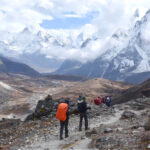
Everest Base Camp Trek – 10 Days
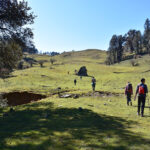
Dayara Bugyal – 4D/3N Trek
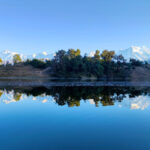
Deoriatal – Rohini Bugyal Trek
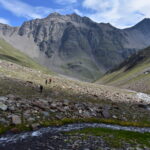
Pin Bhaba Pass Trek
Trekking in Nepal
Everest Base Camp Weather – Best Time for EBC Trek
By Suraj Katwal
Updated On Nov 4, 2022
Learn about Everest Base Camp Weather and know about the best season to trek the Everest region . Visibility of Mount Everest is best during the Autumn and Spring Seasons as the overall temperature is best for trekking.
While ascending up the mountainous part of Nepal, you will gain a significant altitude. Starting from Kathmandu (the capital city of Nepal) situated at about 1,345 meters, you will gain a total of 4,000 meters before you reach Everest Base Camp at an altitude of 5,550 meters.
So, you will experience variations in weather every day as you head towards Everest Base Camp. The weather turns unpredictable in this trek as you head higher.
Everest Base Camp Weather
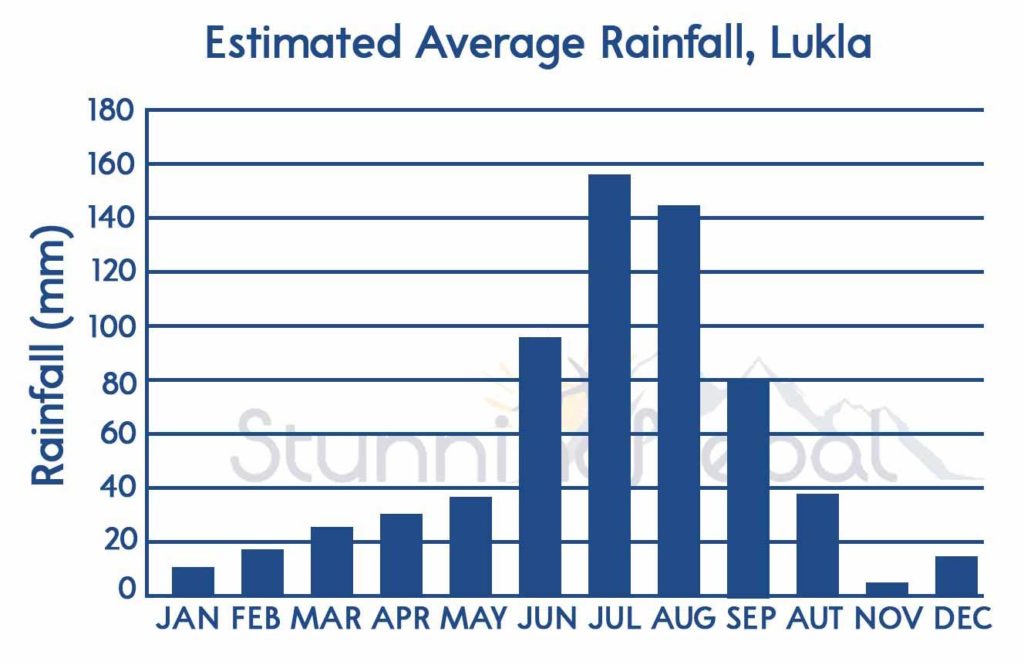
As Mt. Everest is covered by snow all year round, the climate for this reason has a big gap between day and night. The temperature is at the plus point as well as minus and beyond zero.
The Everest Base Camp trek’s best time is during the autumn and spring seasons on the basis of ideal weather.
Also Read: Everest Base Camp Trek Tips – 10 Actionable Tips
Best Season for Everest Base Camp Trekking
Each season is different with unique features and challenges that add up to your adventure. You can trek in any season on your preference.
Here, we have detailed the weather condition at Everest Base Camp for four major seasons.

1. Spring (March, April, May)
The Everest region is calm during the spring in terms of climate and is the best season for the Everest Base Camp trek. Spring months in Nepal include March, April, and May.
As it is the best time for EBC trekking, you will find a lot of adventurers from different countries on the trails to Everest Base Camp. The trail is overcrowded during this season and you will get to meet many Everest climbers.
As spring is the season of blossoms, you will enjoy different species of wildflowers along the trail in the lower altitudes. The mountains, glaciers, and quaint villages will bring out the most awesome color during this season.
Blooming rhododendron (the national flower of Nepal) will certainly give you a pleasant feeling. Also, take some time to enjoy the species of rare mountainous birds and animals. You will definitely fall in love with the natural lush in the Sagarmatha National Park.
The average temperature during the day reaches up to 10°C in the lower altitudes and up to a maximum of 17°C during the sunny days at higher altitudes. However, the temperature lowers from -5°C to -15°C in the morning and night.
Your journey will remain fresh in your memory file as photography becomes awesome at Everest Base Camp during the spring.
2. Summer (June, July, August)
In Nepal, the summer months are from June to August. In this season, trekking trails may be wet due to the monsoon. This season is a less favorable time to trek Mount Everest Base Camp in comparison to spring.
There’s a high possibility of a landslide in the lower region and avalanches in the higher altitudes. Moreover, summer is not favorable for observing the panoramic view of the mountains.
However, for an aspiring botanist, it might be the best time to study various species of flora and fauna. Most of the tea shops along the trail remain closed during the time of rainfall. In this season, the trail can be less crowded.
3. Autumn (September, October, November)
September to November is autumn in Nepal. This is the perfect time to trek the Everest Base Camp as the weather is the clearest and most stable. The sky is clear during autumn so, you can enjoy a great view of snowy mountains.
The temperature in autumn is the warmest and is a comfortable time for trekking. So, you will have to deal with the crowd. Though the climate is almost clear, you need to be prepared with proper gear as the weather in the mountain region can’t be predicted.
4. Winter (December, January, February)
From December to February, the northern hemisphere of Nepal remains frozen. The days are shorter and nights are a lot colder. Despite the chilling weather, you can still trek as the climate remains stable and dry during winter.
The temperature at Everest Base Camp during the nighttime can be somewhere between -20 to -3 degrees Celsius. There will be no problem if you choose to stay in a tent at the base camp. Winter can be called off-season to trek Everest Base Camp.
But, it may be the best time for you if you want to avoid the crowd. As most of the tea houses and lodges are vacant during this freezing weather, you will get to enjoy good hospitality and enjoy discounts.
Without a doubt, winter can be the challenging season for EBC trekkers because the trail that goes through the high passes such as the Gokyo trail and Mera peak trail will be closed. Almost all the places will be covered with thick layered snow.
However, a spectacular view of mountains on a clear day will be the best part of your trip. It will definitely be adventurous trekking with a lot of snow and chill.
Recommended Reading: What to wear in Nepal in January?
Suraj Katwal
Suraj is a travel enthusiast who believes in finding solace in the heart of nature. He enjoys exploring new destinations, different culture, and encouraging people to travel.
Travel Resources
Hotel & Flight
Searching for the best hotels & flight tickets to visit Nepal? Check out the best deals.
Related Articles...
5 Best One Week Treks in Nepal
Annapurna Base Camp Trek Cost for Nepali
Annapurna Base Camp Trek vs Everest Base Camp Trek
30 Interesting Facts About Mount Everest
Why is Annapurna so Deadly Mountain?
How to Find Travel Agency for Everest Base Camp Trek?
Annapurna Base Camp Trek Weather
Top 5 Family Trek in Nepal
Leave a Comment Cancel reply
About stunning nepal.
Stunning Nepal is a travel blog that intends to provide travel tips, references & guides, things to do & also your guide for hiking & trekking in Nepal.
Travel Guide
Things To Do
Food and Festivals
Privacy Policy
Get in Touch
Stunning Nepal
Address: Dhanawantari Marg, Kathmandu 44600, Nepal
+977-9808211139
© 2024 Stunning Nepal. All Rights Reserved
- ქართული ენა

Temperature
Precipitation, 14 day weather everest base camp.
- Everest Base Camp
- 14-Day Weather
This chart shows the 14 day weather trend for Everest Base Camp (Tibet, China) with daily weather symbols, minimum and maximum temperatures, precipitation amount and probability.
- The deviance is coloured within the temperature graph. The stronger the ups and downs, the more uncertain the forecast will be. The thick line represents the most probable trend.
- Variation in precipitation is represented as a „T“. These uncertainties usually increase with the number of forecasts days ahead.
- The forecast is created with „ensemble“ models. Several model runs with varying start parameter are calculated to estimate the predictability of the forecast more precisely.
More weather data
Seasonal forecast, multimodel ensemble, astronomy seeing.
- Weather Today
- Weather Maps
- Website Widgets
- Weather APIs
- Climate Services
- Website Help
- Website Subscriptions
- Weather Apps
- Terms & Conditions
Advertising is essential to maintain our free website with unique detail and accuracy.
Please whitelist www.meteoblue.com on your ad blocker or consider buying one of our products:
Already have a subscription? Then please login .
Weather and Temperature In Everest Base Camp Trek
- Nepal Travel Tips
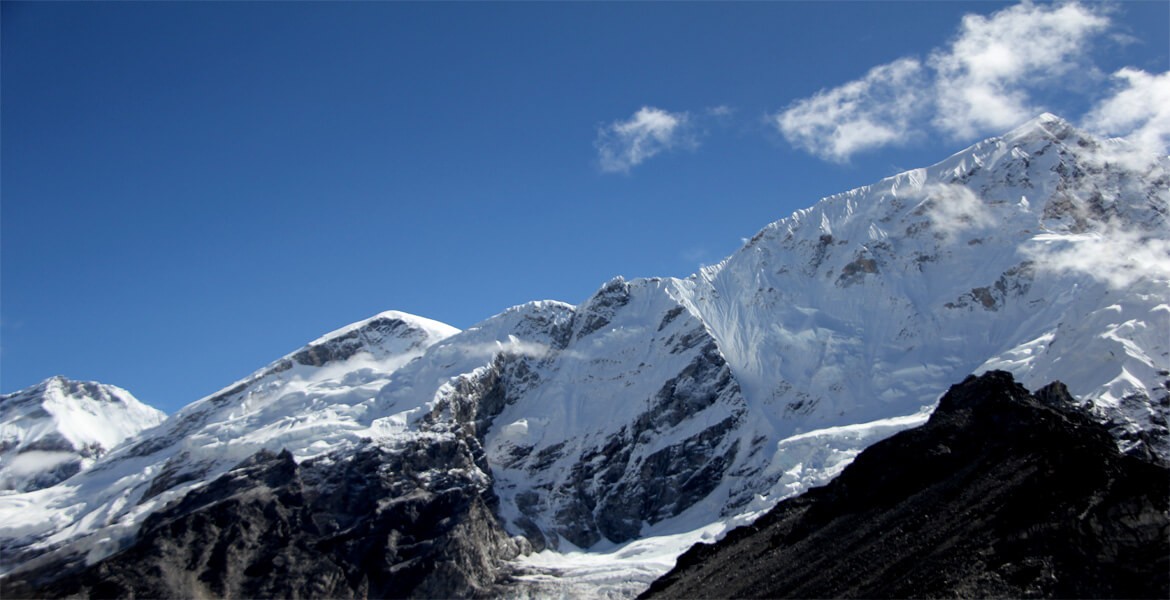
Everest Himalaya
- Jun 10, 2023
Rajesh Thapaliya
The world's highest peak, Everest Base Camp Trek , is one of the most adventurous trekking destinations in the mighty Himalayan region of Nepal. This legendary trek of Everest Base Camp takes you from the village of Lukla, the Trekking point of the Everest Region, which is situated at the elevation of the 2860meters, all the way to the Everest Base Camp, at an altitude of 8,848 meters. Before making a vacation trip to the Everest Base Camp Trek, trekkers should know the Weather and Temperature of the Everest Region in Nepal.
There are four seasons, each with advantages and disadvantages in Nepal. Some trekkers prefer one season, while the same season may be quite challenging for others. According to the seasons the weather and Temperature are different, and depending on the Weather and Temperature of the season, trekkers should pack essential gear and equipment before heading toward the Everest Base Camp Trek in Nepal.

Table of Contents
Everest base camp trek weather in spring (march, april, and may).
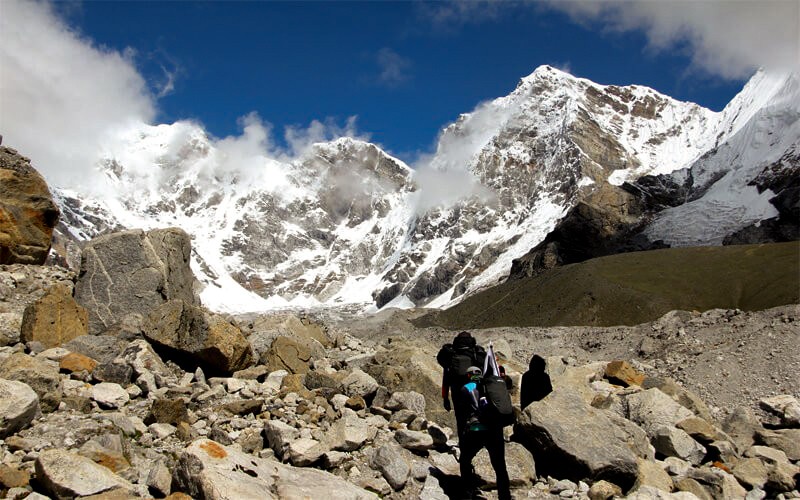
the season consists of March, April, and May, the perfect months for making the Everest Base Camp Trek in Nepal. Everest Base Camp Trek up to the mighty Mt. Everest offers astonishing moments in one life, which will live in the heart and minds of the trekkers. The Weather at Everest Base Camp is one of the most unpredictable elements that trekkers should know before making the Everest Base Camp Trek in Nepal. The days in the spring are pretty long compared to other seasons in Nepal. The Spring season is the season of blooming, where travelers can witness a variety of flowers blooming on the way during their Trekking. The blooming surrounding will add more excitement to your Trek. Due to pleasant weather and moderate Temperature, many trekkers or travelers prefer this season as an ideal season to explore Everest Base Camp in Nepal.
Everest Base Camp Trek
Gokyo lakes trek, everest view trek, everest base camp trek temperature in march, base camp trek temperature in april.
In the April season of the Everest Region, the Temperature is moderate and keeps increasing Temperature in a day. This month, there will be a maximum of 10 degrees Celsius during the day while -10 degrees Celsius at night.
EBC Trek Temperature in May
May is the end of the spring season, in which the maximum Temperature is 15 degrees Celsius a day and -6 degrees Celsius a night. This month the weather is warm and a bit humid in the Everest Region of Nepal. In this month, the possibilities of rainfall are quite impossible, even though sometimes there might be rainfall at the end part of the season.
Is Spring the Best Time to Explore Everest Base Camp?
The Spring season is one of the Best Times to explore Everest Base Camp in Nepal. During this season, there will be relatively less precipitation in the Everest Region of Nepal, where trekkers will get a golden opportunity to have a stunning view of the mountains during their Trekking days. The weather is clear, and the environment is so pleasing that everywhere they can witness blooming flowers along the Trekking trail, adding more excitement and energy to trekking at the higher altitude of Everest Base Camp. So, most trekkers make spring season their ideal season to explore and Trek in the Everest Region of Nepal.
Adventure Everest Region Trek:
- Everest High Passes Trek
- Cho La Pass Trek
Renjo La Pass Trek
Everest base camp trek weather in summer (june, july, august).
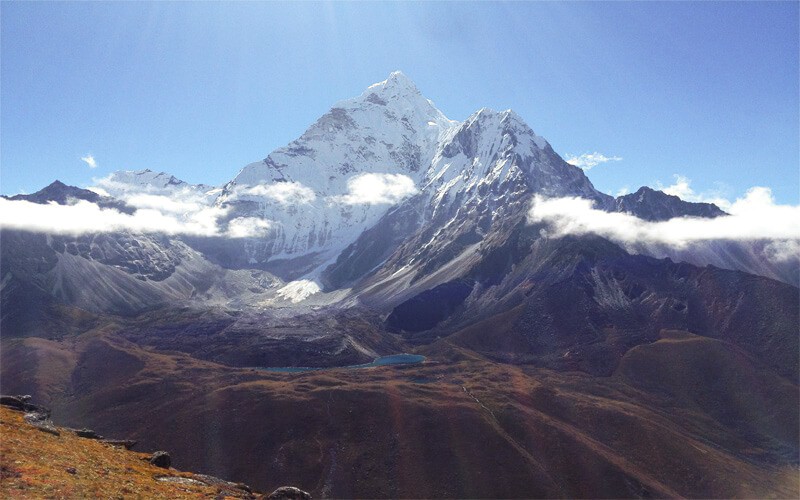
The Summer season consists of three months: June, July, and August. Many trekkers around the world prefer to trek in the Summer season. While talking about the Weather, this season is obvious to have fantastic scenery of the Himalayas from the Everest Base Camp and during the Trekking days. Considering the Temperature in this season is too hot, even though frequent rain makes the lower part of the trail muddy, slippery, and wet. In this season, days are pretty long, and nights are shorter than in other seasons of Nepal.
Due to the heavy downpour environment in the Everest Region of Nepal, most trekkers don’t desire to make their vacation trip. While talking about the weather and Temperature of this season, the season is less preferred because the Weather is foggy, and there will be greater chances of covering stunning views of the Himalayas by cloud. The visibility of the Himalayas is quite tricky in this season. In June, the temperature will be 16 degrees Celsius maximum during the day while -1 degrees Celsius at night. In June and August, the temperature is slightly different. On a day, there will be 15 degrees Celsius, while -2 degrees Celsius a night.
Everest Base Camp Trek Temperature in June
If you are a peace lover and eager to make a Trekking vacation towards the world's highest peak (Everest Base Camp), this season is perfect.
Base Camp TrekTemperature in July
Ebc trek temperature in august, is summer a good time to visit everest base camp.
Usually, the summer season is considered off-season to make the Everest Base Camp Trek in Nepal. If you are a keen lover of solitude and desire to discount the Everest Base Camp Trek package, this season is the perfect time to make your vacation trip to Everest Base Camp in Nepal. During this season, there may be occasional interruptions in the Everest Base Camp Trek in the Everest Region of Nepal due to uncertain rainfall. In such a case, Frolic Adventure will extend extra days in your Everest Base Camp Trek itinerary. In this season, early morning, there will be clear whether that is why trekkers should Trek early in the morning to have clear and amazing views of the Himalayas. You have to follow some instructions from your guide.
- Gokyo Valley Trek
- Everest Panorama Trek
Everest Base Camp Trek Weather in Autumn (September, October, November)
.jpg)
The Autumn season consists of three months: September, October, and November. Many trekkers around the world prefer to Trek in the Autumn season. While talking about the Weather, this season has fantastic scenery of the Himalayas from the Everest Base Camp and during the Trekking days. Considering the Temperature in this season is not too cold nor too hot. Due to the Perfect Temperature and Weather, the Everest Base Camp Trek is mostly crowded this season because most trekkers come to visit and make their Trekking destination. During this season, some trekkers may not prefer to trek to Everest Base Camp but love peace and a calm environment. During this season, the temperature of Everest Base Camp is 15 degrees Celsius during the day and 2 degrees Celsius at night.
Everest Base Camp Trek Temperature in September
September is the beginning of autumn and the end of the summer season in Nepal. During this season, there will be unpredictable weather. In most cases, the temperature will be 15 degrees Celsius during the day and 2 degrees Celsius a night in the Everest Region of Nepal.
Base Camp TrekTemperature in October
Most trekkers prefer to Trek in October because in this month, the Temperature is a maximum of 12 degrees Celsius during the day and -9 degrees Celsius at night.
EBC Temperature in November
The month of November comes at the end of autumn and the beginning of winter in Nepal. This month, the Temperature will be slightly moderate, with a maximum of 6 degrees Celsius a day and -15 degrees Celsius a night. So, trekkers should have proper gear, such as a sleeping bag and warm clothes, while Trekking this month to the Everest Base Camp Trek in Nepal. This month, you can see breathtaking views of the Himalayas and Everest Base Camp in high definition.
Is Autumn a Good Time to Visit the Everest Base Camp?
The Autumn season is best known for its stable, precise weather and not too cold or hot. Due to the tremendous and clear-cut visibility of the stunning Himalayas ranges, most trekkers prefer to take their vacation in the autumn season to explore the world's highest peak (Everest Base Camp). This season, there will be excessively crowded due to the number of trekkers in the Everest Region of Nepal. This season may not be ideal for those trekkers who love peace environment during their Trek to Everest Base Camp.
- Gokyo Lake Trek
Everest Base Camp Trek Weather in Winter (December, January, February)
The Winter season consists of December, January, and February, which are the coldest season of the year in Nepal. This season falls between after autumn and spring. In this season, the days are shorter, and the nights are longer compared to other seasons in Nepal. During this season, most of the Everest Base Camp Trekking trail is dry, and the Temperature is bearable at the low altitude of the Trekking trail. In the Everest Region, the average Temperature range is around 20 degree Celsius a day and -17 degrees Celsius a night. You might experience cold at night, so you must care about proper gear before Trekking in Everest Region this season.
Everest Base Camp Trek Temperature in December
Base camp trektemperature in january, ebc trek temperature in february, is winter a good time to visit the everest base camp.
Compared to other seasons in Nepal, Winter is the least preferred because there will be heavy snowfall at higher altitudes, making your Trekking quite challenging and demanding in Nepal's Everest Base Camp Trek.
Some helpful information:
- Everest Base Camp Trek Accommodation
- Everest Base Camp Trek Gear List
- Altitude Sickness
The Weather and Temperatures of the Everest Region in Nepal vary according to the seasons. Although all seasons are perfect for the Everest Base Camp trek , trekkers should know which season best suits them to explore Everest Base Camp. Looking at the above mention Weather and Temperature data, you can organize your vacation trip and pack all the essential gear according to the seasons. Now, book your Everest Base Camp Trek with us.
Share this:
- basecamptrek

Namaste! I am Rajesh, a Nepal travel blogger who provides Nepal travel tips to travellers who are planning to visit Nepal and know about Nepal.
I am a tourism service provider in Nepal So far, I have been to the Nepalese Himalayan base camps as a tour leader and collected lots of information about the Nepalese Himalayas. You can find my experiences in my travel blogs, so it may make it a lot easier for you to travel to Nepal.
You may find beautiful photos on Instagram , Facebook and Twitter . I have worked very hard to be in this stage after high school and dedicated my experiences to the people who would like to know about Nepal and Nepal travel.
Send an enquire
Recent post.
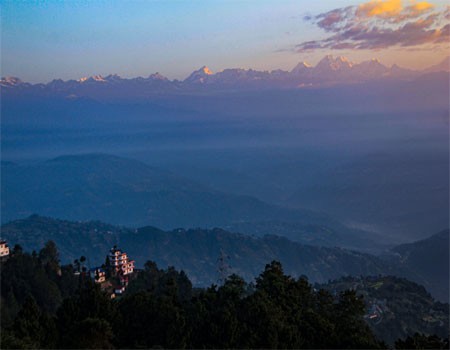
How to go Nagarkot from Kathmandu
- Jan 29, 2024
You can drive directly to Nagarkot from Kathmandu at any time. Still, it depends on ...
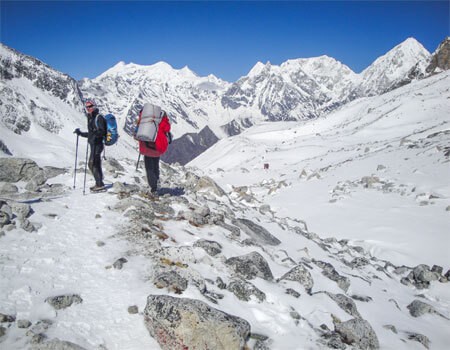
Manaslu Circuit Trekking Distance
- Jan 28, 2024
- Manaslu Region
You will walk 10-12 days from Sotikhola to Dharapani or Ngadi to complete 142.4km (88.5 ...
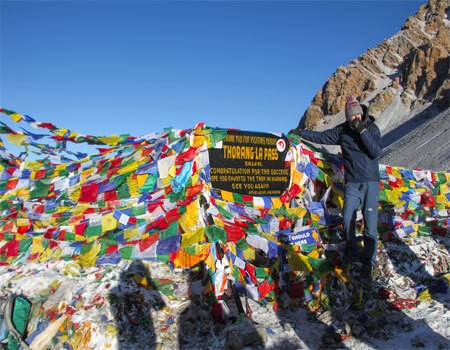
Annapurna Circuit Trekking Distance
- Dec 18, 2023
- Annapurna Region Guide
Annapurna Circuit Walking Distance According to Starting and Ending PointsBesisahar to Nayapul: 221km (137.323 miles) ...
- Culture and Religion
- Everest Region Guide
- Heritage Sites in Nepal
- Langtang Guide
- News and Events
- Things to do in Nepal
- Travel Diary
- Uncategorized
You may also like
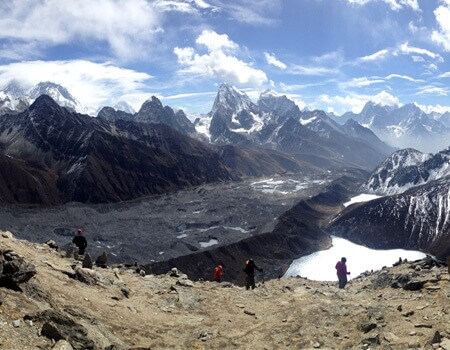
The Renjo-La Pass Trek is the best trekking trip in the Everest Region for the incredible ...
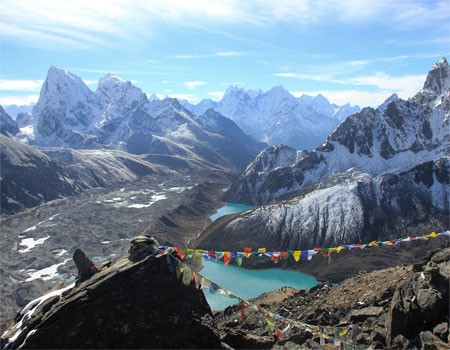
The Gokyo Lakes Trek is a quiet route in the Everest Region compared to the ...
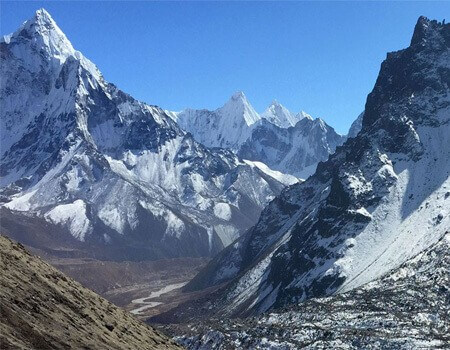
Everest Three High Passes Trek
The Everest High Passes Trek covers Three major hills to cross; that's why it's also famous ...
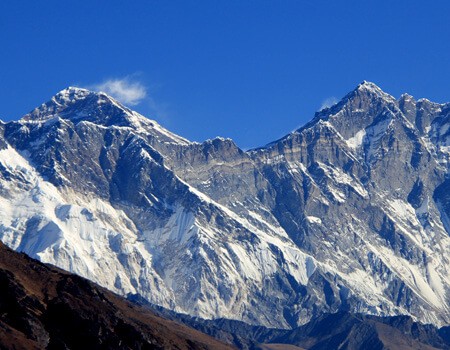
Everest Mountain Flight
The journeys to the Himalayas have never been so classy yet marvelous in sheer magnitude. ...
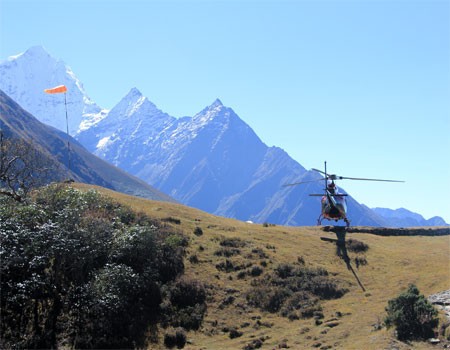
Everest Base Camp Helicopter Tour
Everest Base Camp Helicopter Tour for 4-5 hours from Kathmandu is the best option to ...
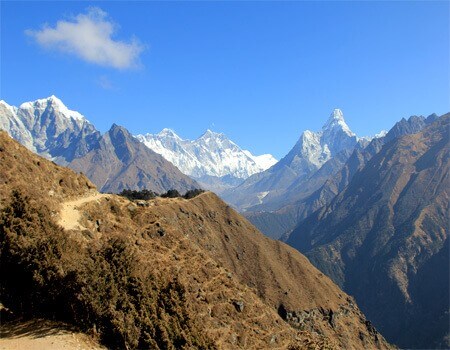
The Everest View Trek, also known as the Everest Panorama Trek, is indeed one of ...
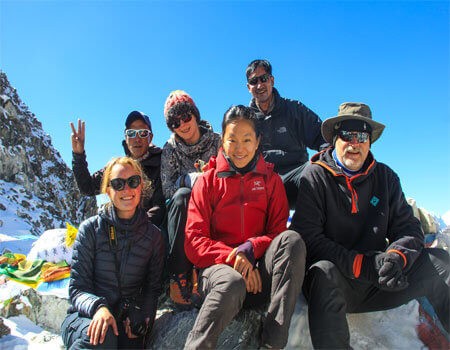
Everest Base Camp with Gokyo Lakes Trek
The Everest Base Camp with Gokyo Lakes Trek via Cho La Pass is in the Solukhumbu ...

Everest Base Camp (EBC) Trek is the most thrilling adventure activity for trekkers worldwide. This ...
We are Associate and Certified
Registered with: company registration office, government of nepal, licensed by: nepal tourism board & department of tourism, proud member of trekking agency's association of nepal, general member of nepal mountaineering association.

Whatsapp/Viber
Send your messages
- Legal Documents
- Terms & Condition
- Privacy Policy
- Why Trek With Us
- Everest Base Camp Trek
- Everest Panorama Trek
- Rapid Everest Base Camp Trek
- Three High Passes with Everest Base Camp Trek
- Mt Everest View Trek
- Luxury Everest Base Camp Trek
- Everest Base Camp and Gokyo Lakes Trek
- Gokyo Lakes Trek
- Gokyo Valley Trek
- Classic Everest Base Camp Trek
- Annapurna Base Camp Trek via Poon Hill
- Annapurna Circuit Trek
- Mardi Himal Trekking
- Short Annapurna Base Camp Trek
- Ghorepani Poon Hill Trek 10 Days
- Ghorepani Poon Hill Trek
- Khopra Danda Trek
- Tilicho Lake + Annapurna Circuit Trek
- Khopra Trek
- Langtang Himal Panorama Trek
- Tamang Heritage Trekking – 10 Days
- Gosaikunda Pass Trek
- Holy Lake Gosaikunda Trek
- Manaslu Circuit Trek
- Kanchanjanga Trek
- Upper Mustang Adventure – 18 Days
- Makalu Base Camp Trek
- Upper Dolpo Trek
- Lower Dolpo Trekking
- Tsum Valley Trekking
- Nar-Phu Annapurna Trek
- Everest Base Camp Helicopter Tour
- Annapurna Base Camp Helicopter Tour
- Langtang Himal Helicopter Tour
- Nepal Scenic-Cultural Tour
- Bhaktapur Tour
- Kathmandu City Tour
- Beyond Kathmandu Valley Tour
- Nepal Famous Historical Tour
- Lobuche Peak Climb
- Mera Peak Climbing
- Island Peak Climb Via EBC
- Tent Peak Climb
- Chulu East Peak Climb
- Yala Peak Climbing
- Koshi Tappu Wild-Life Safari
- Bardiya National Park Safari
- Chitwan Jungle Safari
- Mount Kailash Mansarovar Yatra
- Tibet Overland Tour
- Mt. Kailash Tour
- Lhasa to Lhasa via Everest Base Camp
- A Glimpse Of Bhutan Tour
- Laya To Gasa Trek
- Druk Path Trek
- Jhomolhari Trek
- Darjeeling and Bhutan Tour
- Mountain Flights
- Paragliding
- Rafting in Nepal
- Mountain Biking
- Bungee Jumping
- Rock Climbing
- Nepal Travel Info
- Tibet Travel Info
- Bhutan Travel Info
- Booking FAQ
- Group Joining
- Travel Insurance
- Booking Procedure
- Everest Base Camp Trek Weather
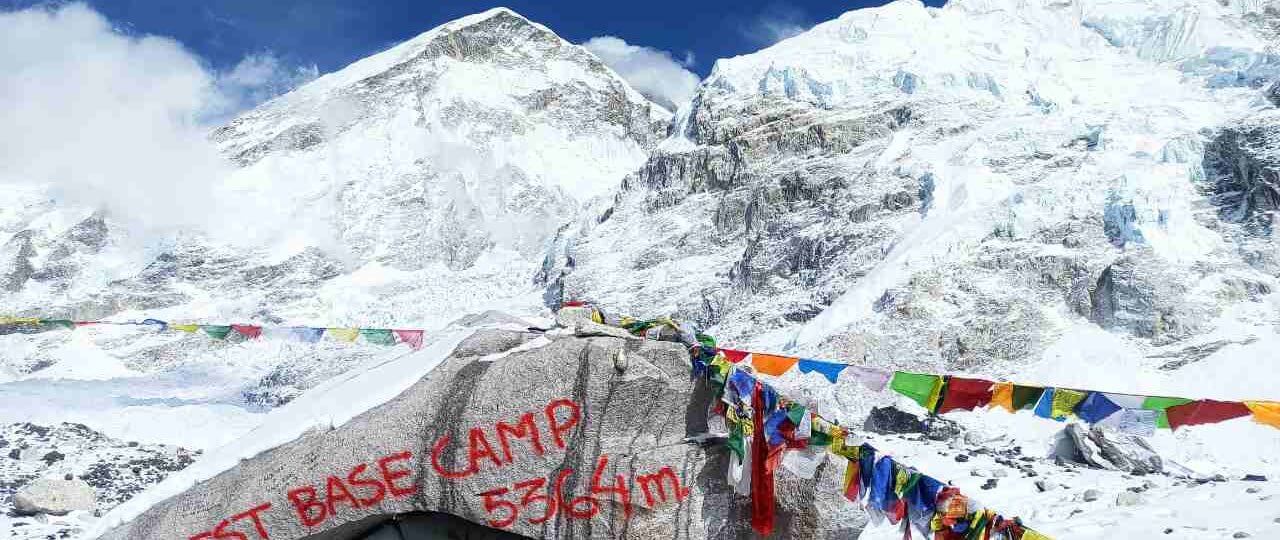
Everest Base Camp Trek Weather in this EBC trekking blog, we’ll talk about Everest Base Camp weather with changes in seasons. Technically speaking, the beauty of the Everest Base camp doesn’t get hindered by the season. It’s good to trek in all of the season, however, some merits and demerits come along the way. I have divided the Everest base camp weather into four categories (according to the four seasons).
The enjoyable yet hard mountain paths, difficult steep hill climbs, amazing landscapes and views all add up to the worth of embracing the journey to Everest. It takes little to less mountaineering experience to complete the trek, but some training such as aerobics, stamina and immunity-boosting before the trek is highly recommended.
Everest Base Camp Weather in Spring
- Temperature: 15°-20° degrees (Day) & 1 degrees (Morning & Night)
- Wind Speed: Average 12 Km/hour
- Precipitation: 10mm
Spring is the best time for EBC Trek. In Nepal, the spring season is in the months of March, April and May. After numerous months of sheer cold winds and frozen lakes, the flowers finally begin to bloom, and nature finally starts a new life.
The teahouses finally get open after a huge amount of snowfall and blizzards. The weather is moderate and you will be able to fully enjoy nature’s fresh air and sceneries. The sky is generally clear with some cloudy days which makes it easier to get across terrains and steep mountains.

However, since this time is an ideal time, the trek is busiest during the spring season. Pre Booking your before heading on to this trek is a good idea during these months.
Everest Base Camp Weather in Summer
- Temperature: 22°-28°degrees (Day) & 4 degrees (Morning & Night)
- Wind Speed: Average 14 Km/hour
- Precipitation: 180mm
As the month of spring passes, the summer starts. The monsoon starts in April and can range up to the month of July. The days are warmer and it often rains during the afternoon.
Even though the Everest Base Camp weather is dry during the season, the trails are muddy and slippery so footwear with a fine grip is recommended. Most trekkers avoid trekking to Everest Base Camp in Summer, which means the route will be silent.
You should bring extra pairs of literally everything including innerwear, and outerwear if you wish to go during the rainy seasons. Sometimes, you should be able to handle the leeches and wet trails and be extra careful.
This may not be the best time to do this trek, because of the rain, and most days will be misty and cloudy. That means you won’t be able to fully enjoy the sparkling snow-white mountains and the views. But that does not stop many travellers to experience Everest Base Camp during these conditions.
Everest Base Camp Weather in Autumn
- Temperature: 17°-20°degrees (Day) & -8 degrees (Morning & Night)
- Wind Speed: Average 21 Km/hour
- Precipitation: 2.5 mm
The driest of all seasons is Autumn. It is also considered the best trekking season according to many trek lovers. The time during the months of September, November and December. As the monsoon departs, so will the clouds, which results in clearer skies and stunning views of the mountains.
The winds can sometimes be strong making it much colder to walk along the terrains. As this season is popular among the trekkers, you should expect some busy trails while trekking to EBC in Autumn. Pre Booking hotels and stays are recommended as ever during the Autumn Season.
Everest Base Camp Weather in Winter
- Temperature: 5 degrees (Day) & -15 degrees (Morning & Night)
- Wind Speed: Average 5 Km/hour
- Precipitation: 7 mm
If you are planning for Mount Everest Base Camp Trek in Winter season is normally cold, and you can expect how cold it could get in the mountains. The winter season starts in December and lasts until the end of February. Most trekkers don’t prefer trekking during the colder season, but some are happy with snow and silent trails.

The days are short while the nights are longer which means you will mostly be in a freezing environment. It makes your time-limited for the trek. I recommend you to go on the trek with major safety precautions and care. The weather is harsh and can get worse at night time. Getting a highly experienced guide is a must while you fight against the intense weather.
During the winter season, the trekkers can grab pretty much fair deals and discounts on their packages.
So, if you are ready to plan or will ever plan a trip to the Everest Base Camp Trek Weather you definitely would want to know about the Everest Base Camp Trek weather and we hope this blog might have helped you with that. The major factor that most people are worried about is the Everest Base Camp temperature. The average temperature in the Everest Region is 17 degrees during the day and might go down below -15 degrees during the morning and the night. Know all about the trek with our EBC Trek Guide.
Need help preparing for the Everest Base Camp Trek? Inquire us, we have been organizing EBC Trek for more than 15 years now and we will help you plan a perfect one for you.
Related Blog
- Religious Tour In Nepal
- How to Prepare for Everest Base Camp Trek?
- Everest Base Camp Packing List
- Everest Base Camp Trek Clothes to pack for the trek?
- Top 12 Best Trek in Nepal
- Covid-19 and Nepal Travel Updates
- Adventure Sports in Nepal
- Places To Visit In Kathmandu
- Why Annapurna Base Camp Trek?
- 5 Reasons to Visit Bhutan & the Best Time to Visit
- Nepal Wildlife Jungle Safari
- A Complete Guide for Everest Base Camp Trek
- Best Season To Trek In Nepal
- 10 Things Not To Miss While Trekking In Nepal
- Best Time Trekking in Nepal
- Pokhara Travel Guide
- Holi - The Festival of Colors
- Climate of Nepal
- Things to do in Pokhara
- Everest Base Camp Trek Cost
- Everest Base Camp Trek in Summer
- Best Adventure Treks In Nepal
- Things to do during Everest Base Camp Trek
- Trekking in Nepal in Spring
- Winter Trekking in Nepal
- Hiring a Guide in Nepal
- Physical Fitness, Altitude and Trekking in Nepal
- Budget Friendly Trekking in Nepal
- Trekking In Nepal In Autumn
- Everest Region Trekking Routes
- Everest Base Camp Trek Clothes: What clothes to pack for the trek?
- Everest Base Camp Trek Blog: Why EBC Trek?
- Monsoon Trekking in Nepal
- Everest Base Camp Trek Package
- 6 best elevation traveller valentine day;s gift for your girlfriend
- Best Adventure Treks in Nepal 2023
WhatsApp us

- Classic EBC Trek
- EBC + Gokyo Trek
- Jiri to EBC
- 3 Passes Trek to EBC
- Island Peak and EBC
- Acclimatisation
- Packing List
- Get a Trek Quote
Start planning your Everest base camp trek
We help adventure-seekers plan and book their dream trek to EBC
Welcome to EBC Trek Guide
Reaching Everest Base Camp has become the goal of thousands of avid trekkers the world over. There is a sense of grandeur that comes with trekking through an area considered a Mecca for climbing and mountain enthusiasts.
This website is the most comprehensive online guide to the Everest Base Camp Trek. On it you will find all the information you need to trek safely and successfully in the region.
On this page we provide a general overview to the Everest Base Camp Trek, along with many links to further reading on topics like: Altitude Sickness, Packing Lists, Route Variations and many FAQs!
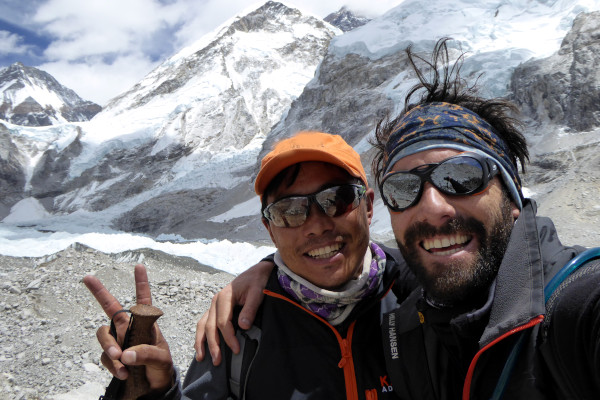
Plan your EBC Trek
Get a quote from our recommended local EBC trek operator
Everest Base Camp Trek FAQ
What makes the everest base camp hike special.
The iconic Everest Base Camp Trek leads you through the Khumbu Valley, allowing you to experience the immense beauty of the surrounding Sagarmatha National Park while simultaneously providing breath-taking vistas of 4 of the 6 highest peaks in the world – My. Everest (8.848m), Mt. Lhotse (8,516 meters), Mt. Makalu (8,470 meters) and Cho Oyu (8,201 meters).
The classic trek retraces the footsteps of Sir Edmund Hillary, Tenzing Norgay and the countless other early pioneers of Mount Everest as you trek from Lukla to the Base Camp.
As a teahouse trek you will stay in some of the highest villages in the world as you explore the local culture and traditions of the native Sherpas by learning about their spiritual connection with the mountains.
On the trek you will have the chance to ascend Kala Patthar , reaching an altitude of 5,500m and witness awe-inspiring views of Mount Everest.
You will also have the chance to explore the various Buddhist monasteries dotted along the trail and learn about a culture steeped in history and tradition, inextricably linked to the very mountains on which you have unforgettable views.
Below we have provided a brief overview of the classic route itinerary, with regional and trekking maps. We have also answered some of the most frequently asked questions on the logistics of the trek, permits, tour guides, weather, insurance, cost, difficulty and what to pack.
Where is the Everest base camp trek located?
All treks in the Everest region are located within the orange rectangle on the map below. The block represents the Everest or Khumbu region of Nepal and shows its location in relation to Kathmandu, where flights to and from Nepal arrive and depart.
The starting point of the Everest Base Camp Trek, Lukla , is also visible on the map. Other variations of the trek which don’t involve flying to Lukla generally start at Jiri – you can read more about this route variation here .

What is the best Everest region map?
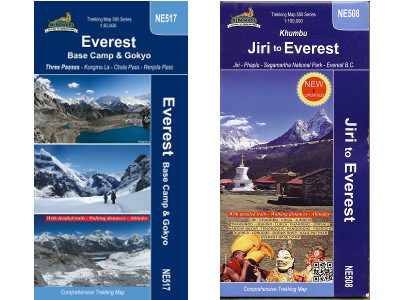
There are many great trekking maps for the Everest Region. Some take in the Gokyo region, whereas others cover Jiri and further Southern and Western aspects of the region.
We recommend Nepa Maps .
What is the best Everest guidebook?
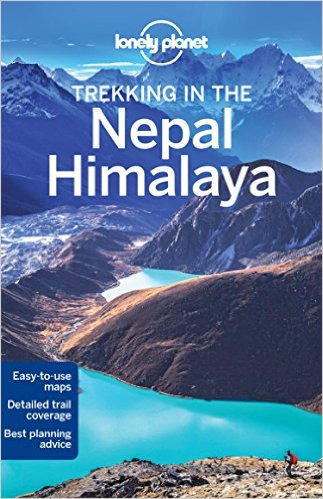
We recommended taking a detailed guidebook with you on the trek.
The Lonely Planet Trekking in Nepal Himalaya guidebook is updated regularly and is a well-known, trusted resource used by many trekkers worldwide.
The guide is very detailed and contains information for many treks, meaning you can use it more than once!
How high is Everest base camp?
Everest base camp is 5,364 metres (17,598 ft) high. The graph below shows the altitude profile for the classic Everest Base Camp trek. The order of the names on the horizontal axis shows the typical progression of the hike with the major stops on the way. The graph makes it easier to see the gradual ascent and more rapid descent of the trek.
The highest point on the EBC hike is Kala Patthar at 5,554 meters.
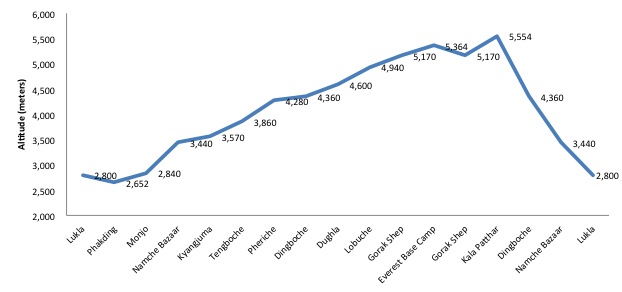
What is the day-to-day itinerary on the Mt Everest base camp hike?
The classic Everest Base Camp Trek starts in Lukla and leads you through the Khumbu Valley to the Everest Base Camp situated on the south-side of Mount Everest.
Most trekker’s adventures, however, begin in Kathmandu where the international airport for Nepal is located. From there it is a short, yet unforgettable flight into Lukla from where you will start the actual trekking (try get a seat on the left hand side of the plane for best first views of the Himalaya).
The entire journey including the trek typically lasts between 14 and 16 days, with 12 days on the trail. Of these 12 days, 2/3 will be spent acclimatising to the high altitude, so 9-10 days of actual trekking can be expected.
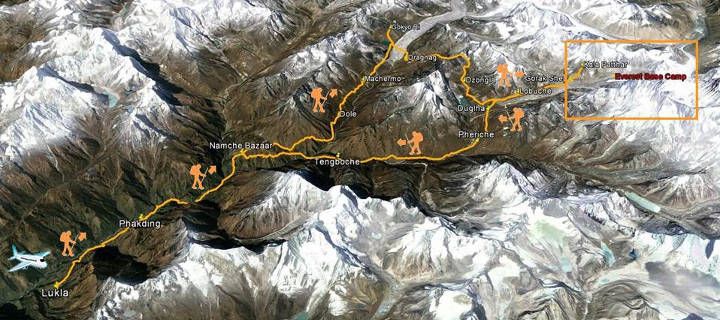
For those who don’t want to start their trek by flying into Lukla Airport, the Jiri to Everest Base Camp Trek variation provides a unique alternative. This trek starts with a bus ride from Kathmandu to Jiri from where the trekking starts. Because Jiri is considerably further away than Lukla, this variation will add around 5 days onto the trek.
Here is a standard itinerary for a 14-day Everest Base Camp Trek experience.
Day 1: Arrive in Kathmandu
If you have organised a trip with a tour operator they will usually provide airport transfers, otherwise there are loads of taxis available at the airport. Top tip: make sure to agree a price before getting in the taxi. Meters are sometimes used, but rare. We recommend staying in Thamel (which is about 15 minute drive from Kathmandu airport). There are many hotels in Thamel, Kathmandu, with varying degrees of hospitality.
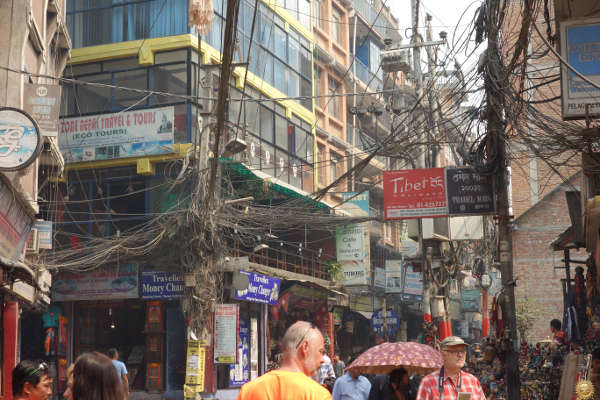
Vibrant streets of Thamel, Kathmandu
Day 2: Fly Kathmandu to Lukla. Trek to Phadking
Weather permitting you will fly from Kathmandu International Airport to Lukla in the morning. Flights to Lukla are prone to delay due to weather. We recommend building as much flexibility into your itinerary to cater for delays (i.e. having a day or two spare after the trek).
If trekking with a tour operator they will have arranged your flight, otherwise you can purchase tickets at the airport for around US$250-$300 return. If you are taking a guide the cost of his flight with be charged at a local rate of about $100 return.
Expect a nerve-racking flight into the famous Lukla Airport that provides great views of the region and of Everest – try to get a seat on the left side of the plane. Once landed, you will start the trek to the village of Phadking – on the way you will pass incredible boulders, carved with Buddhist prayers.
Day 3: Trek from Phadking to Namche Bazaar
This day will be spent trekking from Phadking through Mojo, ending up in Namche Bazaar. Some people cut this day short by stopping in Mojo (if you do the Mount Kailash Teahouse is great, and offers hot showers!).
You will enter the Sagarmatha National Park (a UNESCO World Heritage Site) on this day. You will have plenty of time spent in Namche Bazaar – a small Sherpa market town, with countless sightseeing opportunities including the potential to catch your first glimpse of Everest.
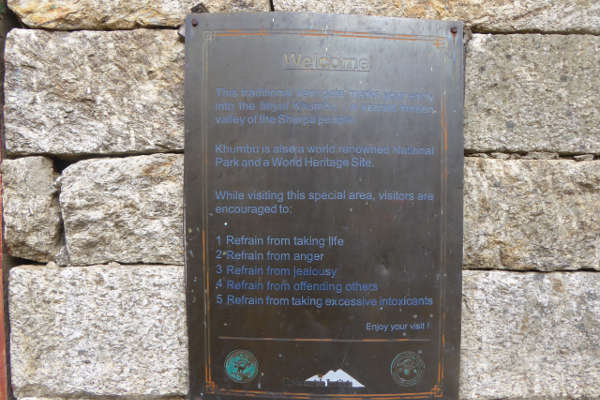
Sign with rules about entering Sagamartha National Park
Day 4: Acclimatization day in Namche Bazaar
At close to 3,500m, Namche Bazaar acts as an important acclimatization stop while doubling up as an opportunity to explore the village and surrounding areas. If it happens to be a Saturday, be sure to check out the market. Most tour guides will take you on a short acclimatization trek to the Everest View Hotel.
If it’s a clear day you should be able to snap some awesome pics of Ama Dablam in the foreground, and Mount Everest in the background. The hotel also provides WiFi at a cost so if you’re looking to call back home or just to connect, bring your device with you. For more information on internet on the trek, check out our detailed article .

Namche Bazaar
Day 5: Trek from Namche Bazaar to Tengboche
The day is spent trekking from Namche Bazaar to Tengboche, the home of the Tengboche Monastery – the largest in the region.
Some variations will take you through the ancient Tibet-Nepal trading route over the Nanpa La pass to Thami.
Day 6: Trek from Tengboche to Periche
The next stop on the trek is Pheriche – the home of the Himalaya Rescue Association . The route takes you through Phangboche, which offers amazing views of Ama Dablam towering above you.
Day 7: Acclimitization Day. Potentially Trek from Pheriche to Dingboche
Pheriche is usually used as a stop for the second acclimatization day. There are various activities to do in the area. Tshola Tsho Lake is a popular destination for trekkers stopping in Pheriche.
Your tour guide might even take you to the nearby village of Dingboche where you will be able to see great views of Lhotse and Island Peak to the east. Dingboche is used as the start to the variation trek to Island Peak .
Day 8: Trek from Pheriche to Lobuche
This day is long and is spent climbing over 600m from Pheriche to Lobuche. On the way, you will pass the well-known Khumbu Glacier as well as various memorials to those Sherpas and climbers who have died on Everest.
You will be able to see Scott Fischer’s memorial here. You will also see Lobuche East (make sure to use the zoom on your camera or if you have binoculars to try see any climbers on the peak)
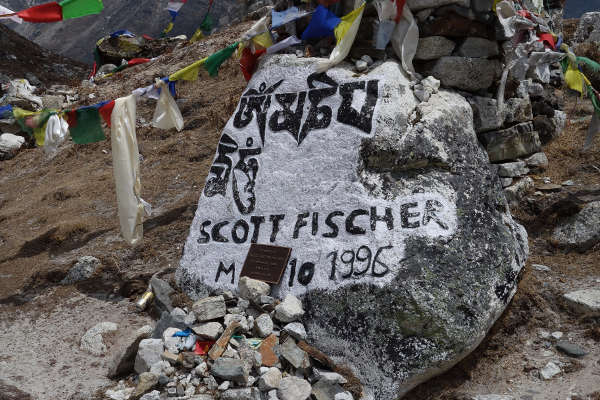
Scott Fischer's memorial
Day 9: Hike from Lobuche to Gorak Shep
Hike from Lobuche to Gorak Shep, the highest permanently inhabited village in the world. Here, you will rest for a while and have something to eat before climbing further to the Everest Base Camp.
The trekker stop point is just before the actual base camp.
Most tour groups are not allowed to enter or stay in Everest Base Camp so take the chance to experience the buzz and excitement of the climbing groups is often limited.
After getting your iconic picture taken at EBC you will descend back to Gorak Shep where you will stay for the night.
Day 10: Gorak Shep to Kala Patthar, then onto Dingboche
Another day of steep trekking allows you to reach Kala Patthar – the highest point on the trek at just over 5,500m. Its location and height result in the best views of Everest, Nuptse and Lhotse in the area. Just hope that the weather is kind to you on this day as it is one of the highlights of the whole trek.
That same day you will descend over 1,000m down to Dingboche where you will spend the night.
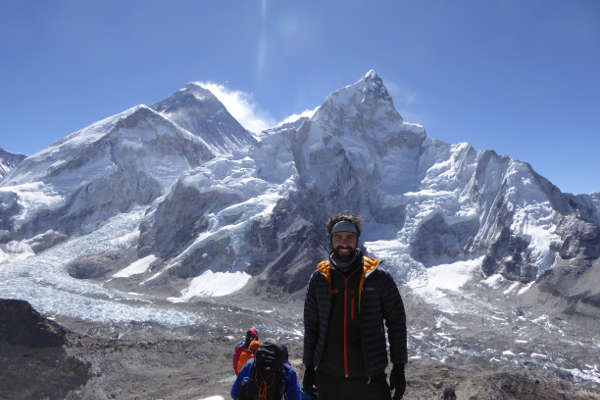
View from Kala Patthar with EBC, the Khumbu Glacier, Nuptse and Mount Everest in the background
Day 11: Hike back to Namche Bazaar from Dingboche
Descend back to Namche Bazaar via Tengboche. Keep your camera on you as you pass through the rhododendron covered slopes – making for a great photo.
Day 12: Hike from Namche Bazaar to Lukla
Return all the way back to Lukla with a long day of hiking. Your last night on the mountain will be spent celebrating in Lukla.
Day 13 and 14: Fly back from Lukla to Kathmandu
Catch the return flight from Lukla to Kathmandu in the morning. Onward travel back home our to your next destination!
More Everest Base Camp hike FAQs
How much does it cost to trek to everest base camp.
You can trek to Mt Everest base camp for as little as $700 if you go solo without a guide. Guided tours that often include return flights to Kathmandu cost around $1000-1300 per person depending on the operator. For a detailed breakdown of costs, see our article on the cost of the Everest Base Camp Trek .
Can you trek to Everest Base Camp independently or without a guide / support?
Yes, but it is only advised for trekkers that have experience of high altitude multi-day trekking, and are comfortable carry 15-20kg a day.
Trekking independently is the cheapest option because you forgo any of the amenities and expertise that is typically offered with a guided trek. You will have to arrange your own domestic flights to and from Lukla airport, and arrange accommodation for each stop in the trek.
If you are comfortable organising the logistics of the trek, then this might be an option for you.
Should I join a guided EBC trek / group?
If this is one of your first high altitude trekking experiences then we recommend using a tour operator and joining a guided group. The typical package will include domestic flights, transport to and from the airport, accommodation for every overnight stop, all permits and passes, porters to carry your luggage and of course the expertise of a guide who will provide you with an insight into the region.
Local tour operators are abundant and often cheaper than western operators, but their level of service will be reflected in their price. Hygiene and ethical standards of some of these operators is also questionable. Prices range from £600 ($750) to £1200 ($1500). To book with one of my vetted local operators, check out our booking platform, Skyhook .
Western tour operators will provide a much more consistent service. Without cutting prices, they offer affordable yet comfortable accommodation and will employ the best guides in the region who will be able to converse in English. Prices range from £1200 ($1500) to £2500 ($3200).
When is the best time to hike to Everest Base Camp?
Contrary to what you might think, the best time to go on the Everest Base Camp trek is not during the height of summer. The spring months of February through May is widely considered the peak season or best time to hike to Everest base camp. This is also the time when the region is at its busiest.
Weather during these months is stable and dry – perfect for trekking and for sightseeing. The lower mountains and foothills are most colourful during this time as well, so you can expect verdant fields and hillsides covered in rhododendrons.
September and October is another popular trekking period on the other side of summer that tends to be a little less busy. Another way to avoid the hustle and bustle of peak season is to try some of the trek variations such as the Gokyo Lakes hike .
Trekking in the winter months (November-January) is still possible, but be prepared for temperatures below freezing. Peak summer is known as monsoon season, characterised by short, sharp downpours. The trails are very wet and trekking during these months is not advised.
Read our detailed article on the best time to trek to Everest Base Camp .

How difficult is the Everest Base Camp Trek?
Contrary to popular belief, Everest Base Camp trek is not very difficult. It requires no prior trekking experience or mountaineering skills of any sort. We have seen people from all walks of life, shapes and sizes completing the trek.
The round-trip length of the trek is 130km, which is spread over just short of two weeks of trekking. Expect to cover around 15km over 5/6 hours of trekking each day – a very achievable number. The hardest part of the trek is the altitude and the effect that it can have on your body.
All good tour operators will factor in acclimatisation days into their itinerary and will aim for a gradual pace of ascent that will ensure your body slowly gets used to the altitude.
We recommend undertaking a gym training programme and practice hikes 6-8 weeks prior to embarking on the trek. Read up more on the difficulty of the EBC trek and how to train for the EBC trek .
Do I need a visa or permit for the EBC Trek?
Yes. If you are a national of a country other than India, you will need to purchase a visa. The 15-day multi entry visa starts at $25 and the 30-day visa goes for $40. The usual guided trek lasts around 15 days, but there is always the possibility of travel delay so we recommending opting for the 30-day visa for a slightly higher price.
You will need a Trekkers Information Management System card (TIMS) as well as a Sagarmatha National Park Entry Permit. Tour operators will include both in their price and will obtain them for you beforehand. If you plan to trek independently, however, you will need $20 for the TIMS card and roughly $40 for the Sagarmatha entry permit.
Make sure you bring at least four passport sized photos in case they are needed for permits.
Will I get altitude sickness on the trek to Mt Everest base camp?
Most people who follow the standard route itinerary, take a gradual ascent with acclimatisation days built in and monitor their symptoms will not suffer from any sort of altitude sickness.
That being said, altitude sickness is not correlated to age or fitness and can affect some people worse than others.
Because it is a potential risk, you must read up about acclimatisation and altitude sickness so that you understand the symptoms and how to prevent them.
What should I pack for the Mt Everest trek?
Condensing a packing list into one short answer is impossible, so we have compiled a very detailed and comprehensive EBC Packing List guide to help you plan and pack for the trek.
It is possible to buy most gear in Kathmandu, but we recommend bringing all the important stuff with you from home. Read our guide for recommendations on what to bring, which brands are trusted as well as items you won’t need during the trek.
What insurance do I need for EBC?
You will need to take out insurance that will cover you for hiking up to altitudes of 6,000m.
Typical travel insurance will not cover this so we have compiled an article that will help you find the right insurance policy that adequately covers delays, accidents and altitude related illness.
World Nomads provide insurance for treks to Everest Base Camp.
Read our detailed guide on travel insurance for the Everest Base Camp Trek .
EBC Trek Route Variations
There are a number of route variations for the trek to Everest Base Camp. Below we briefly discuss the three most popular options.
Gokyo Lakes Trek
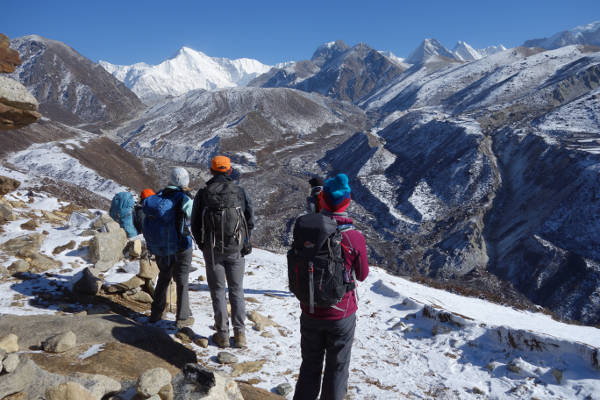
One of the more popular variations of the Everest Base Camp Trek, the Gokyo Lakes Trek , also starts at Lukla and follows the classic base camp trek to Namche Bazaar where it forks north-west.
The trek proceeds through the towns of Dole and Machermo before reaching the stunning Gokyo Lakes. From there you can ascend to the peak of Gokyo Ri in the north, before crossing the Ngozumba glacier and Cho La Pass and re-joining the classic trek at Lobuche.
The detour adds 2/3 days onto the trek but provides the wonderful opportunity to summit a peak while also avoiding some of the busier parts of the trek.
Jiri To Everest Base Camp

This variation of the classic trek offers an alternative to flying into Lukla from Kathmandu to start the trek. The Jiri variation starts with an 8-hour bus ride from Kathmandu to Jiri, where the trek begins.
The variation adds an extra 5/6 days onto the trip as you trek through the Solukhumbu region and make your way past Lukla, where the trek then follows the same route as the classic Everest Base Camp Trek.
It involves a scenic, yet long, bus ride as well as a lot more exposure to the Tibetan and Sherpa cultures. Expect to trek through more forests and streams as you start at the relatively low altitude of 1,800m and work your way up to Lukla and beyond.
Three Passes Trek

The Three Passes Trek is a tougher variation than the classic Everest Base Camp Trek because it involves crossing three very high passes as well as summiting some walking peaks which are not included on the classic trek.
The variation starts by following the classic trek from Lukla to Namche Bazaar before veering west towards Thame and the remote Nangpa Valley. The first of the three passes encountered is the Renjo La, where you will be afforded magnificent views of Everest before descending to the idyllic Gokyo lakes.
The next pass, Cho La, involves walking up a fairly steep and icy trail before reaching a small glacier at the top. From here, you descend and re-join the main base camp trek where you summit Kala Patthar – the iconic viewpoint. You continue onto base camp itself before descending to Lobuche.
You then head east over the third pass of Kongma La and continue onwards to summit the third peak of Chukking Ri. Once again you will have amazing views of the surrounding peaks that you would not get to see on the classic trek. The circuit is completed by returning to Lukla through the main Everest trail.
Island Peak Climb via EBC
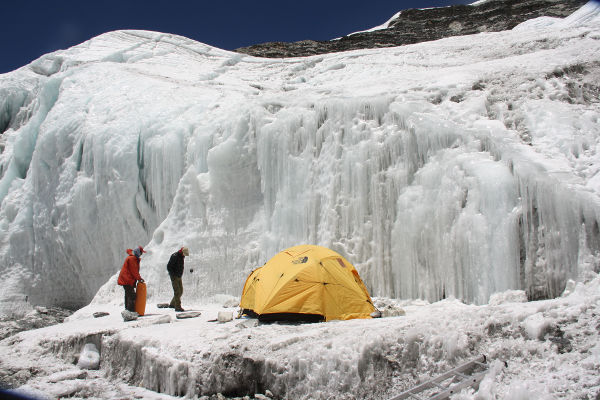
Island Peak is not so much a variation as it is an expedition in it’s own right. Summiting Island Peak is significantly harder than the trekking any of the routes mentioned above, but it does usually involve a visit to Everest Base Camp to acclimatise before the summit attempt. The climb to the peak is not considered technical although it still requires basic knowledge of jumaring, abseiling, using crampons and ice axes. Standing at just under 6,200m, altitude is a real factor.
Most climbers of Island Peak use the traditional base camp trek as a means of acclimatising before heading to the Island Peak Base Camp via Dingboche on the main trail, or by traversing the Chongma La pass. Summiting from the base camp typically takes two days and the whole variation will add around 4 days onto the classic EBC trek.
Recent EBC Blog Posts
Coronavirus pandemic: can i still hike to everest base camp (covid 19 update), mount everest deaths rise due to overcrowding, everest base camp trek packing list – exactly what you need to bring, dj paul oakenfold plays gig at everest base camp, food on the everest base camp trek, teahouses on the everest base camp trek.
References: EBC Trek Guide is maintained by a group of passionate Nepal guides and independent trekkers, many of whom live in Kathmandu and are experts on the trekking trails to Everest and throughout the region. Much of the site is based off personal experiences which are then cross-referenced with secondary sources like trail and travel guides (i.e. Trailblazer, Lonely Planet ), and third party websites. If you find any inaccuracies on the site please contact us.
Tags: Everest Base Camp Trek, Trekking to Everest Base Camp, EBC Trek
Get my recommendations on the Best EBC trek operators
- Customize Trip

- TripAdvisor Awards 2018/2019/2020/2021/2022
- WhatsApp & Viber +977 9851072590
- Mail Support [email protected]
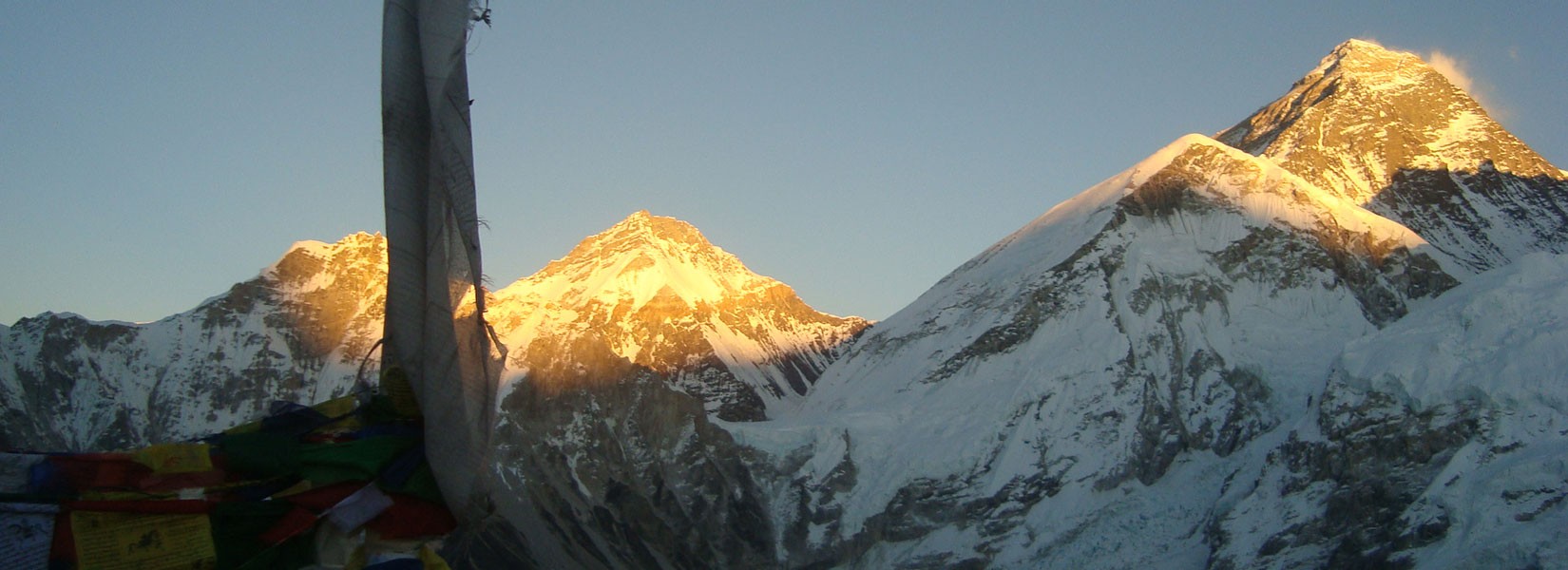
- Everest Base Camp Trek in March
- You are here:
- Travel News
Everest Base Camp Trek in March: Weather, Travel Tips, Packing List and More
- Dec 31, 2021
Table of Contents
Everest base camp trek in march .
Trek to Everest Base Camp during the March month is the ultimate time for high altitude walkers in Nepal Himalaya kingdom. March month is the beginning of spring in this season everything invigorates a new life of nature, the trekking trail will be quiet and offer you an amazing experience of the Everest base camp trek.
While the climate in the mountains is still cold and may still be a problem in some places. The environment is very fresh and able to see very clear mountain vistas. The meadows and forest will be in full bloom with riots of colors of wildflowers specially rhododendron is the national flower of Nepal.
You will be completely enjoying your EBC trek, trekkers hit the trail in larger numbers again in March as well are much good reason to do this trip, here’s what you need to know more details about the trek to Everest Base Camp in March .
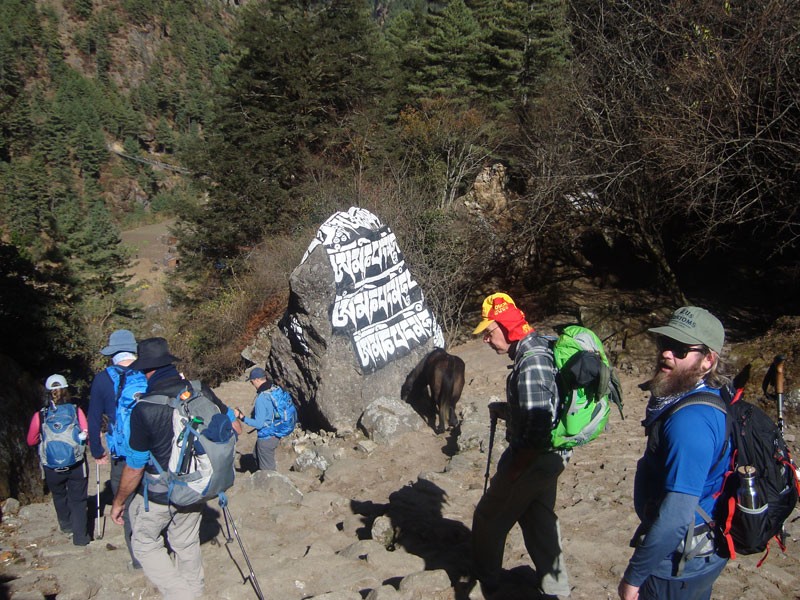
Weather
It is not a month for rain, meaning a very good chance to have beautiful weather and can able to see a clear mountain view along with your trekking to Mt. Everest base camp at 5,364m | 17,593ft . March month s just being the transition from the winter season to spring and will be very fresh weather condition and still, some major trek high passes trek route could be covered by snow. The temperature approximately could be at Everest base camp almost 7 degrees that all in depending on the weather condition.
All the EBC trekkers can enjoy day trek weather night and the morning feels still cold but mountain views are very clear and could able to share your Everest base camp trek experience in good adventure trip and wonderful mountains view in March month trek to Everest Base Camp. There are other benefits for trekkers can enjoy with their hike exploration of Sherpa homeland, and valley in beautiful weather but do not keep in your mind the temperature in the EBC route is unpredictable.
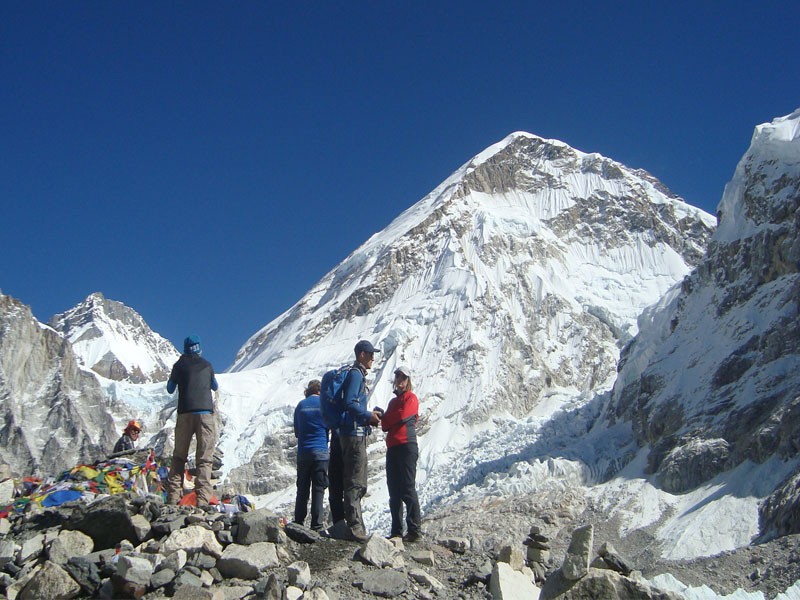
Travel Tips
As per my previous experience, providing you the following Tips about Everest Base Camp Trek in March grab it then share your different experiences with us.
Accommodation, Food, and Cost
Trek to Everest Base Camp in March month would not busy as much as April and May. You can find almost similar lodge-teahouses accommodation on the trek route of EBC beside Lukla and Namche Bazaar both places can able make the overnight sleep in a fancy hotel. Trekking with a good through best local trek operator manages all standard lodges along the EBC trek period.
You can eat breakfast and lunch at the same place where you sleep overnight if you do not eat the same lodge your room bill costs go up to lunch at different Sherpa restaurants day by day and you require to eat Nepali hygienic food as well can find western continental Chinese. Overall daily meals: breakfast, lunch, and dinner cost you approximately USD 20-22 dollars per person per day through Nepalese style.
Advance Well Prepared
Before starting your trek in the high altitude of Everest base camp you need to prepare well in advance! Because the weather in the Everest region is could in morning and night so, you can wear a layer of clothes so that you can add or remove your clothes based on weather conditions.
As you have a very good dream to reach Everest base camp at 5,364m, you require to do in advance morning exercise such as morning walk and cycling it means our muscle and body is fit for trekking 5-6 hours a day along the EBC trek.
Start Your Trek in Early
As per global O’clock in Nepal Everest trek region the March month day is short, the night will be longer, while we require to walk every day 6-7 hours walk before reaching Everest base camp and you need also extra time break for the daily lunch break, soft drink break if you start your trek every day early after the breakfast as per your EBC trek itinerary you will get enough hours time for exploration even more details which is also top tips for you.
Acclimatization
For high altitude trek such as Everest Base Camp-Kalapatthar 5,545m hike, you require at least two rest days (acclimatization) before reaching the EBC which days will help you to your better achievement and require drinks to hydrate regularly to cope with altitude sickness as well the process of acclimatization slowly increases the level of oxygen in your body. Do not make the whole day sleep in the two rest days period you need to ascending at least 300-400 up then descend at your overnight stop point, drinks 3-4 letters clean water help you to get more advantage entire your trek.
Trip Advance Booking
March month is not a busy season, after the 2nd of the week, the trek trail will be started crowds by mass of trekking group sometimes unable to find the accommodation after the Namche. This affects your trekking experience, not in good condition. To get rid of these problems you must select your trek itinerary and book as early as possible for your trip secure advance booking which makes your EBC trip comfortable and never feels again of a bad situation.
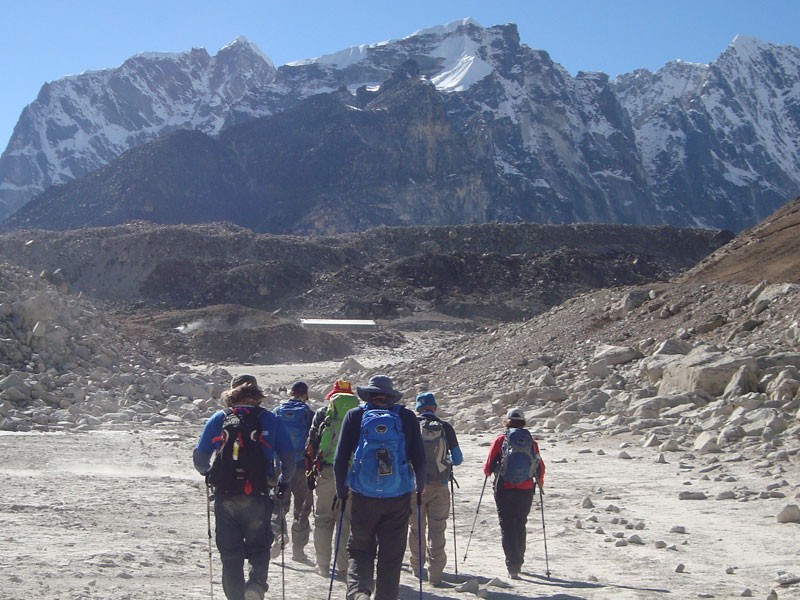
Packing List What to Bring
As we are planning to do the trek during march month, the winter season just passed, and still have a chance to get the cold at high altitude trek routes. Everest Base Camp Trek equipment is very important to know before packing your list in baggage, even though teahouses usually provide blankets but we recommend you bring your own warm sleeping bags. Blankets at teahouses aren’t washed very often due to high altitude and busy season time. A warm down jacket is also necessary for the trek to Everest base camp in March.
It is our great pleasure to recommend in the following EBC trek equipment that what to bring with you while you are doing Everest base camp trek in March as well as you can look up and shopping in Kathmandu-Thamel after your arrival in Nepal but time is also important. Also bring good merino and synthetic fiber clothing to keep you warm in the evenings and nights, as well as woolen hats, gloves, socks, and scarves. Sunscreen is also a must however, Visit this link for your Packing list: Recommend EBC trek equipment
Events In March
The Everest region is mostly Tibetan Buddhist in culture and religion, and several of Nepal’s various exciting festivals come from Hindu traditions, so are not widely celebrated in the mountains zone. If you are planning a trek in Nepal in March, you can share your experience on of the following festivals in Kathmandu before or after your EBC trek .
Hindu traditional Nepalese festival typically follows a lunar calendar, so some festivals that fall in March one year may be in February of April the next. The festivals that often fall in March that you can meet in the following during your Everest base camp trek
Maha Shivaratri
Shivratri-the night of Lord Shiva: This is one the greatest festivals of Hindu religion, celebrated in honor of Lord Shiva. A great religious fair takes place in the Pasupatinath Temple (UNESCO world heritage site) and thousands of people from all over Nepal and India visit this temple they are fast the whole day and celebrate at night. On this day more than a thousand Sadhus (Hindu holy men) are gathered to worship Lord Shiva at Pashupatinath Temple that day and night will be special smoking merriment.
Ghodejatra is known as the festival of horses. It is one of the most exciting festivals in Kathmandu city. Horse face and other sports take place at Tundikhet on this day in other parts of the city the various deities are carried shoulder-high on wheels chariot (Khat) with the accompaniment of traditional music. Mainly this festival performs horse by Nepal army.
This is an interesting festival in Nepal which is known as the festival of colors. People are playing and enjoying throwing different colors between the people of group, families together celebration, they do celebrate this festival two days one for the hilly region, and another for Tari belt.
Popular Trek in Everest Region
Everest Base Camp Helicopter Trek 10 Days
EBC Short Trek 12 Days
Everest View Trek 11 Days
Classic Everest Base Camp Trek 16 Days
Gokyo Lake Renjo La Pass Trek 15 Days
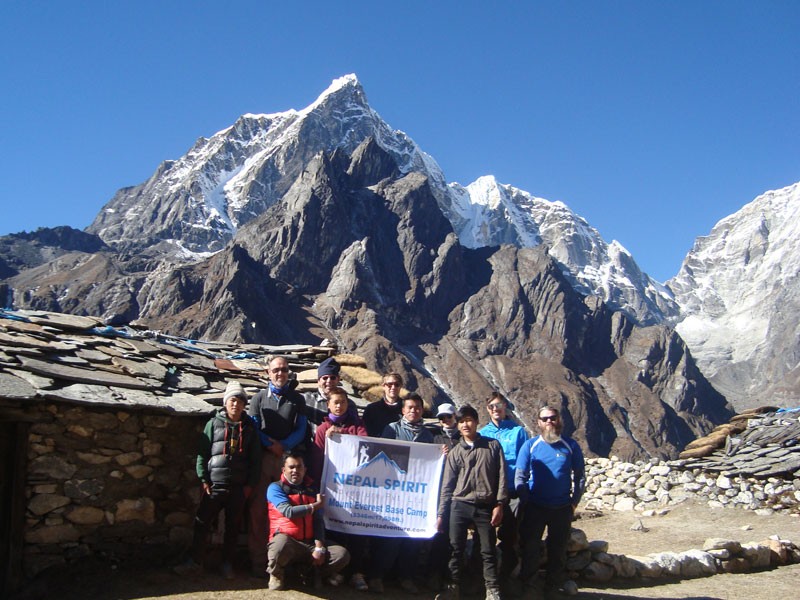
Trek in Nepal Himalaya on high altitude foothill walking is not easy but people have a dream to reach the world’s highest base camp once in a lifetime. In this trek, if you are preparing perfectly for your trekking then you will be successful to reach Everest base camp at 5,364m. You walk slowly from Lukla to EBC with having enough high altitude acclimatization days, book your EBC trek with an expertise Nepal base trek company.
Friendly and experienced trek guides and staff only can make your trip a comfortable and easy journey and start this adventure trek you need to take a short flight from Kathmandu to Lukla. The Lukla flights are normally scheduled before 12 pm; sometimes the flight could be delayed due to frequent changes in the climate of Lukla. But don’t worry flight is scheduled after the climate is favorable for the flight or could be scheduled for the next day.
During the Everest Base Camp Trek in March, the average walking period for trekkers is 5-7 hours per day. If you are uncomfortable with this situation you can apply Luxury Everest Lodge Trek or start the trek slowly from Lukla to Everest base camp then take a helicopter flight to Kathmandu that would be also another advantage of a lifetime experience taking a helicopter flight from a high altitude Gorakh Shep (5170m/16962ft) to Kathmandu which require you 11 night 12 days from Kathmandu to Kathmandu call Everest Base Camp Helicopter Trek
- Everest base camp trek
- Everest Base Camp Trek Tips
Quick Inquiry
Recent post.
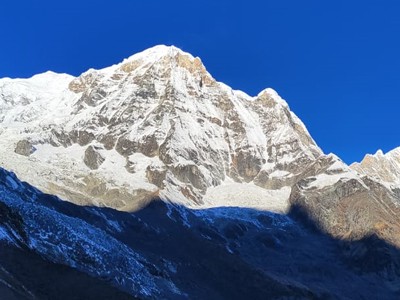
Complete Guide Trek Annapurna Base Camp
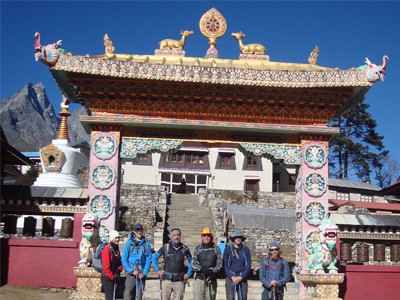
Tengboche Monastery in Khumbu
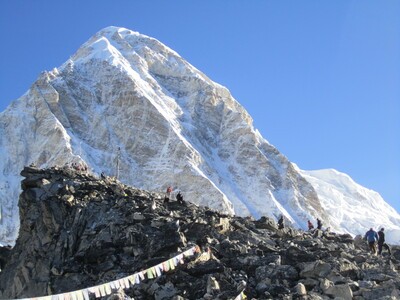
How Long is Perfect for Everest Base Camp Trek
Related posts.
- Chungsi Cave Upper Mustang Nepal
- Everest Base Camp Trek
- Nepal Trekking Season
- News and Events
- Travel & Trekking
- Travel Trekking Insurance
- Trek and Festival
- Trekking and Tour
- Why Everest Trek in October
Main Navigation
Annapurna region.
- Mardi Himal Trek
- Annapurna Base Camp Trek
- Annapurna Circuit Trek
- Annapurna Panorama Trek
- Poon Hill Sunrise Trek
- Annapurna Sanctuary Trek
- Nar Phu Valley Trek
- Poon Hill Trek
- Annapurna Sunrise Trek
- Ghorepani Poon Hill Trek
- Ghorepani Ghandruk Loop Trek
- 4 Days Poon Hill Trek
- Annapurna Short Trek
- Poon Hill Annapurna Base Camp Trek
- Poon Hill Trekking package
- Short Mardi Himal Trek
- 5 days Annapurna Base Camp Trek
- 6 Days Annapurna Base Camp Trek
- 10 Days Poon Hill Annapurna Base Camp Trek
Everest Region Trek
- EBC Helicopter Tour with Landing - 1 Day
- Luxury EBC Trek with Helicopter Return - 5 Days
- EBC Trek with Helicopter Return - 10 Days
- Short Everest Base Camp Trek - 11 Days
- Short Classic Everest Base Camp Trek - 12 Days
- Classic Everest Base Camp Trek - 14 Days
- Everest Base Camp Luxury Trek - 14 Days
- Gokyo Lakes Trek -14 Days
- Short Comfort EBC Trek -13 Days
- Comfort Everest Base Camp Trek - 15 Days
- Gokyo Renjo La Pass Trek - 15 Days
- Gokyo Cho La Pass EBC Trek - 18 Days
- Everest Three High Pass Trek - 19 days
Manaslu Region Trek
- Short Manaslu Circuit Trek
- Tsum Valley Trekking
- Rupina La Manaslu Circuit Trek
- Manaslu Tsum Valley Trek
- Manaslu Trek
Langtang Region Trek
- Langtang Helambu Trek
- Tamang Heritage Trek
- Langtang Easy Trek
- Langtang Trekking
- Langtang Ganja La Pass Trek
- Langtang Gosainkunda Circuit Trek
- Gosainkunda Helambu Trek
Dolpo Region Trek
- Beni - Lower Dolpo Trek
- Upper Dolpo Trek
- Lower Dolpo Trek
Eastern Region
- Complete Everest Base Camp Trek Package
- Rolwaling Trek
- Makalu Base Camp Trekking
Newly Open Trekking
Kanchenjunga region trekking.
- Kanchenjunga Base Camp Trek
- Kanchenjunga Circuit Trek
- Everest Base Camp Helicopter Flight Tour with Landing
- Kathmandu - Pokhara Tour
- Nepal Overland Tour
- Nepal Trekking Tour
- Nepal Trekking with Jungle Safari Tour
- Nepal Cultural Tour
- Nepal Tour with Kids
- Kathmandu-Pokhara-Chitwan-Nagarkot Hiking Tour
Peak Climbing
- Island Peak Climbing
- Mera Peak Climbing
- Lobuche Peak Climbing
- Yala Peak Climbing
- Chulu West Peak Climbing
- Naya Kanga Peak Climbing
- Pisang Peak Climbing
- Shivapuri Nagarkot Trek
- Nagarkot Dhulikhel Namobuddha Trek
- Pokhara Sarangkot Trek
- Hiking and Meditation trip in Nepal
- Annapurna Skyline Trek
- Kathmandu City Sightseeing Tour
- Namo Buddha Day Hiking Tour
- Bhaktapur Half Day Tour
- Nagarkot Sunrise Day Tour
- Nagarkot Sunset Day Tour
- Nagarkot Day Hiking Tour
- Chandragiri Hill Half Day Tour .
- Boudha-Pashupati-Bhaktapur Full Day Tour
- Bhutan Spiritual Tour
- Bhutan Cultural Tour
- Bhutan Short Spiritual Tour
- Tibet Overland Tour
- Kailash Manasarovar Yatra
- Tibet Shangrila Tour
- Tibet Special Tour
- Tibet Introductory Tour
- Lhasa Everest Base Camp Tour
- Simikot Kailash Lhasa Tour
- Simikot Kailash Zhangmu Tour
- +9779851082484

Everest base camp trek in April: Weather, Tips, Difficulty, and Packing List
Everest base camp trek in april:.
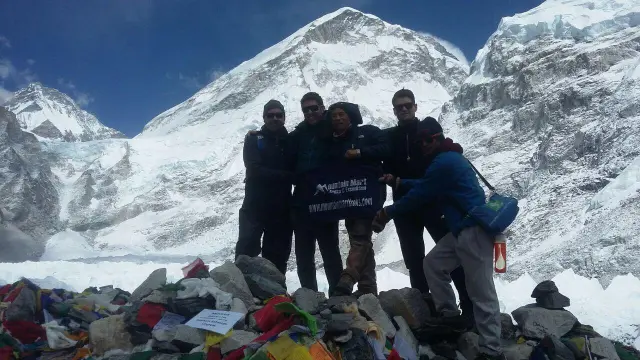
Table of Contents
While trekking in the Everest region the view of snow-covered mountains, glacial lakes, wild animals, ancient villages, stupas and gompas help to forget the hardness of the trek. EBC trek in April is the best package for you to trek into the Everest Region with the most experienced and leading local company of Nepal. Mountain Mart Treks assures comfortable trips, route safety, best price and highly experienced local guides to complete your Everest base camp trek successfully.
.webp)
Walk at your pace:

Hydrate yourself
While trekking into the higher elevation body water escapes through sweat. So you need to hydrate properly to prevent dehydration. We suggest you drink more than 4 litres of water per day. When the body gets enough water then your mind and body works properly. It also increases the oxygen level in your body which helps you to avoid AMS .
Pre-booking
Pre-booking is essential for you to secure your place for trekking. Everest Base Camp Trekking in April is one of the best time for trekking into Everest base camp . In the trekking season, the route gets busy, and hard to find the room in lodge and tea house of trekking trails. Despite this, domestic flight from Kathmandu to Lukla and vice-versa is a vital issue as morning weather is safer in the mountain area and fewer chances of flight cancellation. Advance booking of Everest base camp trek provides you better knowledge guide, the first flight of the morning, good view, and comfortable room.
Everest Base Camp Eco-friendly treks
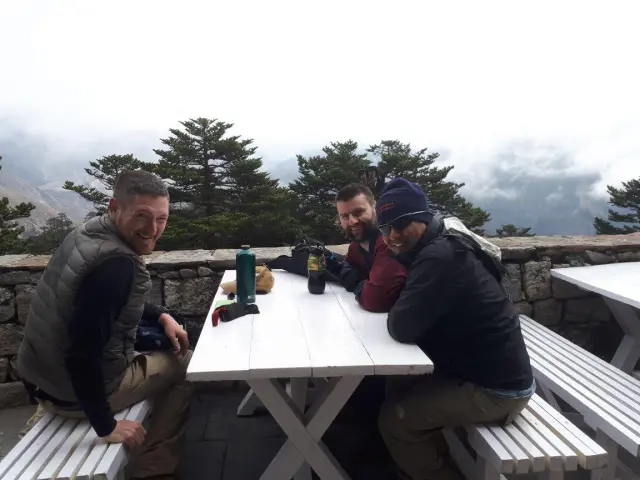
Packing list
In April, where the days become warmer as compared to March and before, but morning and night become still cold depending on the altitude. Despite this, global warming sometimes changes the weather opposite of regular prediction. This is mid of spring season so there is a low probability of rain In the higher elevation. So, the spring season does not mean you just need to wear a single layer of clothes. But you need to wear clothes in layers. As compared to a various season of the year, this is the best time to trek for you into the Everest Region. So you need to pack the right gear, items and gadgets according to month. You can get the overall list by following this link, Everest Base Camp Packing List for April .
Trek Difficulty and Lukla flight

Most of the people who live in the Everest Region are sherpa and they are primarily Buddhist in culture and in religion. The different events and festivals are celebrated by sherpa. But, in this month Hindu festivals are celebrated by the people who live in the hilly region. The different festivals which are celebrated in Nepal have some value and beliefs. So all the festivals are important for Nepalese people. While you travelling to Nepal in April you can experience the following festivals:
- Ram Navami / Chaite Dashain: This festival is celebrated by the Hindu people on the occasion of the birth of Lord Rama, the seventh avatar of Lord Vishnu on the ninth day of Chaitra Navaratri.
- Nepali New Year: Nepal uses the Bikram Sambat (BS) instead of AD. In Nepal, the different ethnic group celebrates their own new year but the National new year fall in mid-April.
Other packages
- Comfort Everest base camp trek 16 days
- Classical Everest base camp trek 15 days
- Classic short Everest base camp trek 12 days
- Everest base camp trek 11 days
- Gokyo lake trek 14 days

Why trek to EBC in April?
- Long warm days
- Experience the memorable flight to Lukla.
- Explore the Namche Bazar and Sherpa culture.
- Visit Tengboche Monastery which is one of the highest monasteries in Khumbu Region
- Walkthrough highest suspension bridge.
- Visit Kala Patthar for a close view of Mt. Everest and sunrise.
Everest base camp trek in April is a great opportunity to explore the natural beauty, ancient culture and the world's highest base camp for keen trekkers like you. An excellent weather condition with moderate temperature makes a suitable time for the trek. Snowy mountains, glacial lakes, colourful forest, and ancient gompas are the major attraction of the Everest trek. The pleasant environment and warm welcome in the trails help you to forget the pain and hardness of the trek. To dive into nature’s womb you are heartily welcome to Nepal. Contact us , if you have any queries?
What is your opinion on this blog? Please suggest.
Other Categories
- Travel Information
Recent Posts
- Manaslu Circuit vs Annapurna Circuit Trek - Which is Best?
- Tips For Annapurna Trekking Packages
- Everest Base Camp Trek vs. Annapurna Base Camp Trek: A Comprehensive Comparison
- Luxury Lodge vs Normal Lodge Trek
- Langtang Valley Trekking
- How Much Does the Langtang Valley Trek Cost?
- Know Before Hiking Poon Hill: The Ultimate Poon Hill Trek Guide
- Everest Trekking Package for 2024/2025
- Top 7 Reasons: Why Everest Base Camp Trek is Popular Today?
- Where is Nepal located on the World Map? - Nepal Facts
- Where is Mount Everest Located?
- Where is Location of Mount Everest in the World Map?
- What is the death rate on Everest? [2022/23 Updated]
- What is Everest Base Camp Trek? - Our Top Tips for your EBC Trek 2022/23/24
- Trekking in Nepal in September - Is September a Good time to visit Nepal 2022/23/24?
Recommended - Boutique Hotel in Thamel, Kathmandu
Charming Newari Heritage Hotel in central Kathmandu, with a rooftop restaurant for stunning valley views.

We are associated with
Acceptable payments.
Find & Follow Us on
© 2011 - 2024 All rights reserved. Mountain Mart Treks & Expedition. Developed By: Xenatech Nepal .
Notice. This site uses cookies to optimize your user experience. By using this site, you are consenting to our use of these cookies. Check out our Privacy Policy and our Cookies Policy.

Passing Thru Travel
The 10 Best Treks in Nepal’s Majestic Mountains 2024
Posted: February 21, 2024 | Last updated: February 21, 2024
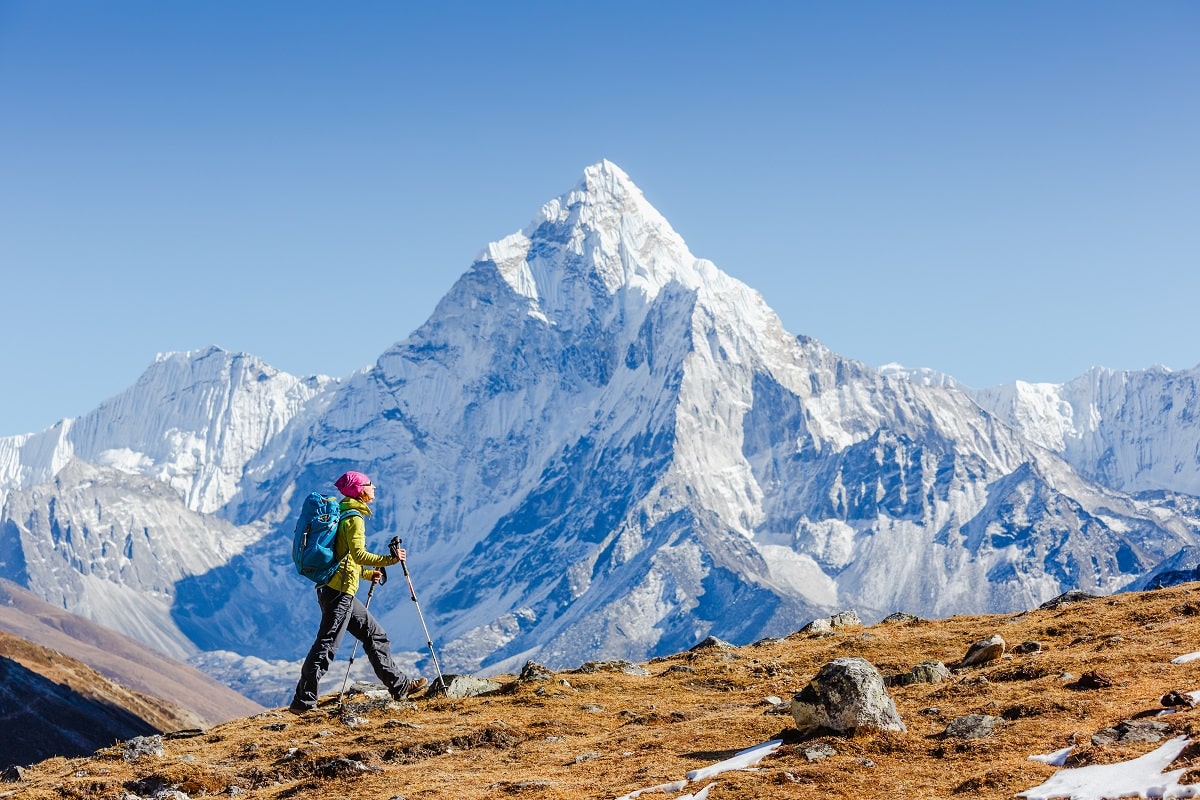
Nestled between the towering peaks of the Himalayas, Nepal is a land of unparalleled natural beauty and a haven for trekkers. From the iconic Everest Base Camp to the serene trails of the Annapurna region, Nepal’s mountains offer a diverse array of trekking experiences, each more awe-inspiring than the last. This guide will take you through 10 of Nepal’s most majestic mountain destinations, providing insights and practical advice for your trekking adventure.
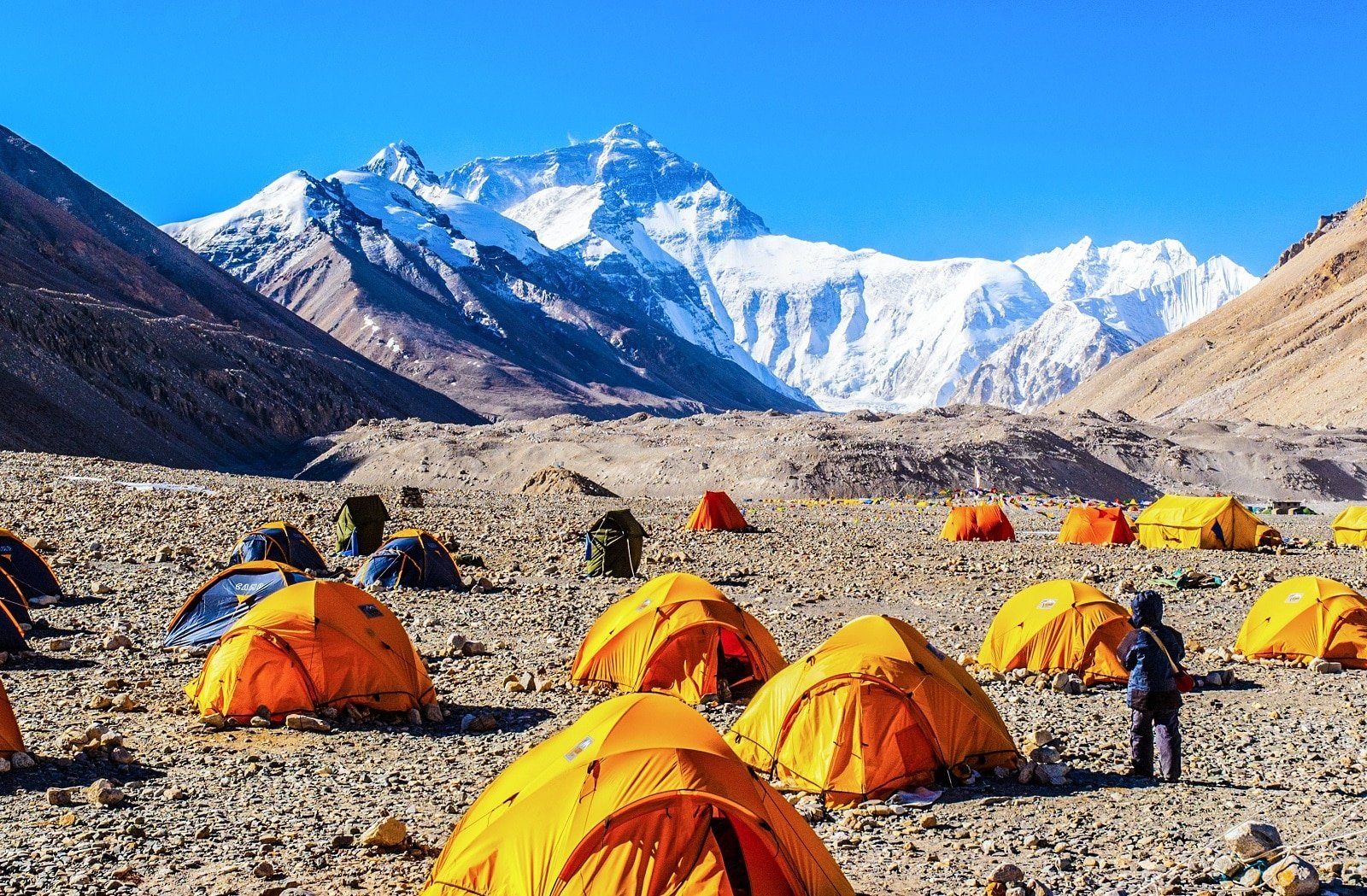
1. Everest Base Camp
Embarking on the Everest Base Camp trek, you’ll journey through the heart of the Himalayas, where the world’s highest peaks, including Everest, Lhotse, and Nuptse, tower above. Starting with a thrilling flight to Lukla, the trek takes you through traditional Sherpa villages, Buddhist monasteries, and along the Dudh Kosi River. The route is challenging yet rewarding, with acclimatization days in Namche Bazaar and Dingboche. The final ascent to Base Camp offers a stunning view of the Khumbu Icefall, making all the effort worthwhile.
Insider’s Tip: Acclimatize properly to avoid altitude sickness.
When To Travel: Pre-monsoon (March to May) or post-monsoon (September to November).
How To Get There: Fly to Lukla from Kathmandu and start your trek from there.
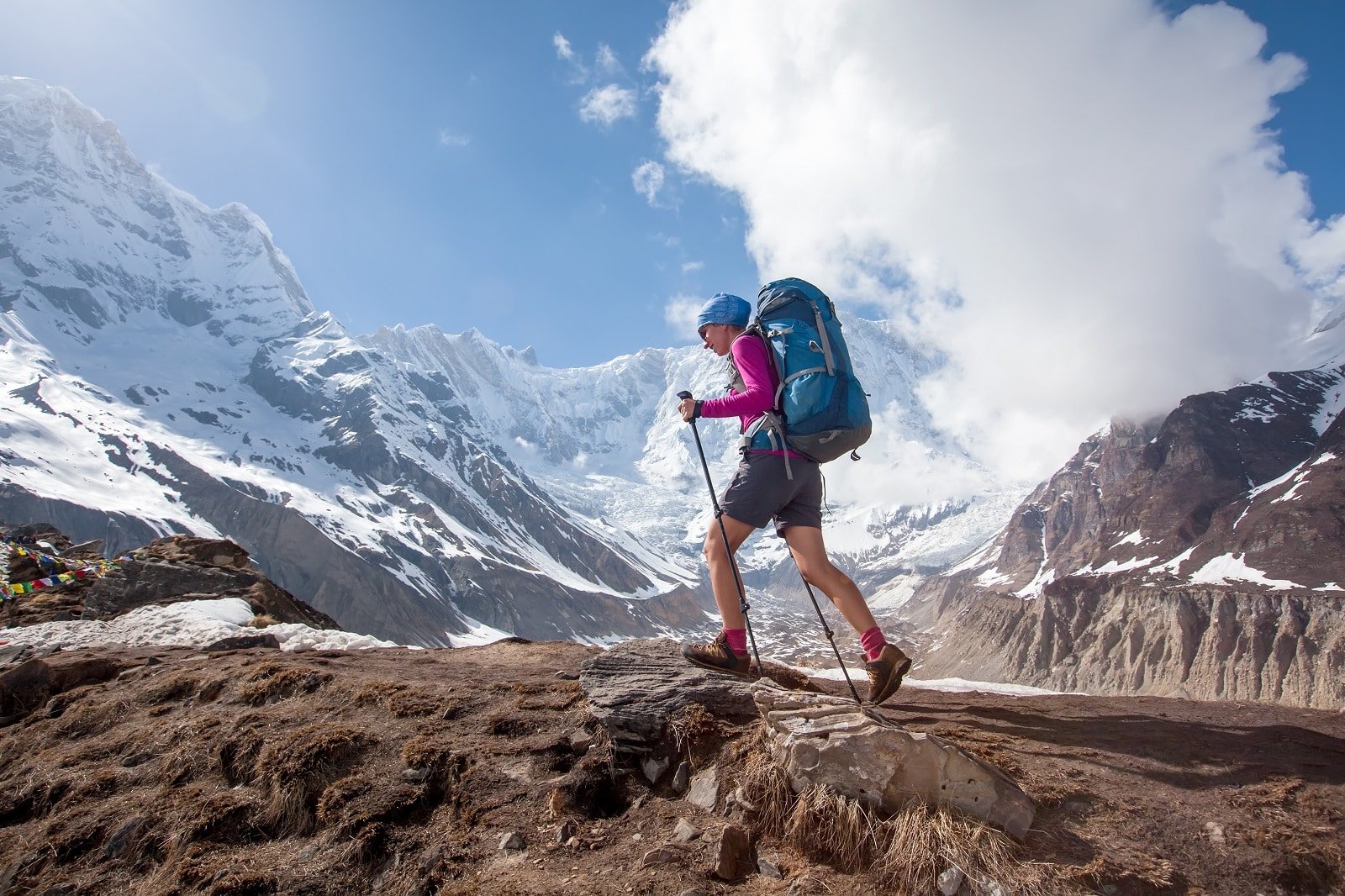
2. Annapurna Circuit
The Annapurna Circuit is a classic trek that takes you around the majestic Annapurna massif. This journey offers a remarkable diversity of landscapes, from the subtropical jungle of the Marshyangdi Valley to the arid, Tibetan-like terrain of the Upper Mustang. Crossing the Thorong La Pass, the trek’s highest point, is a challenging but exhilarating experience. The trek also allows for cultural immersion in the mountain communities of the Gurung and Manangi people.
Insider’s Tip: Take side trips to the ice lakes or Tilicho Lake for additional stunning views.
When To Travel: March to May and October to November for the best weather conditions.
How To Get There: The trek typically starts in Besisahar or Bhulbhule, accessible by road from Kathmandu or Pokhara.
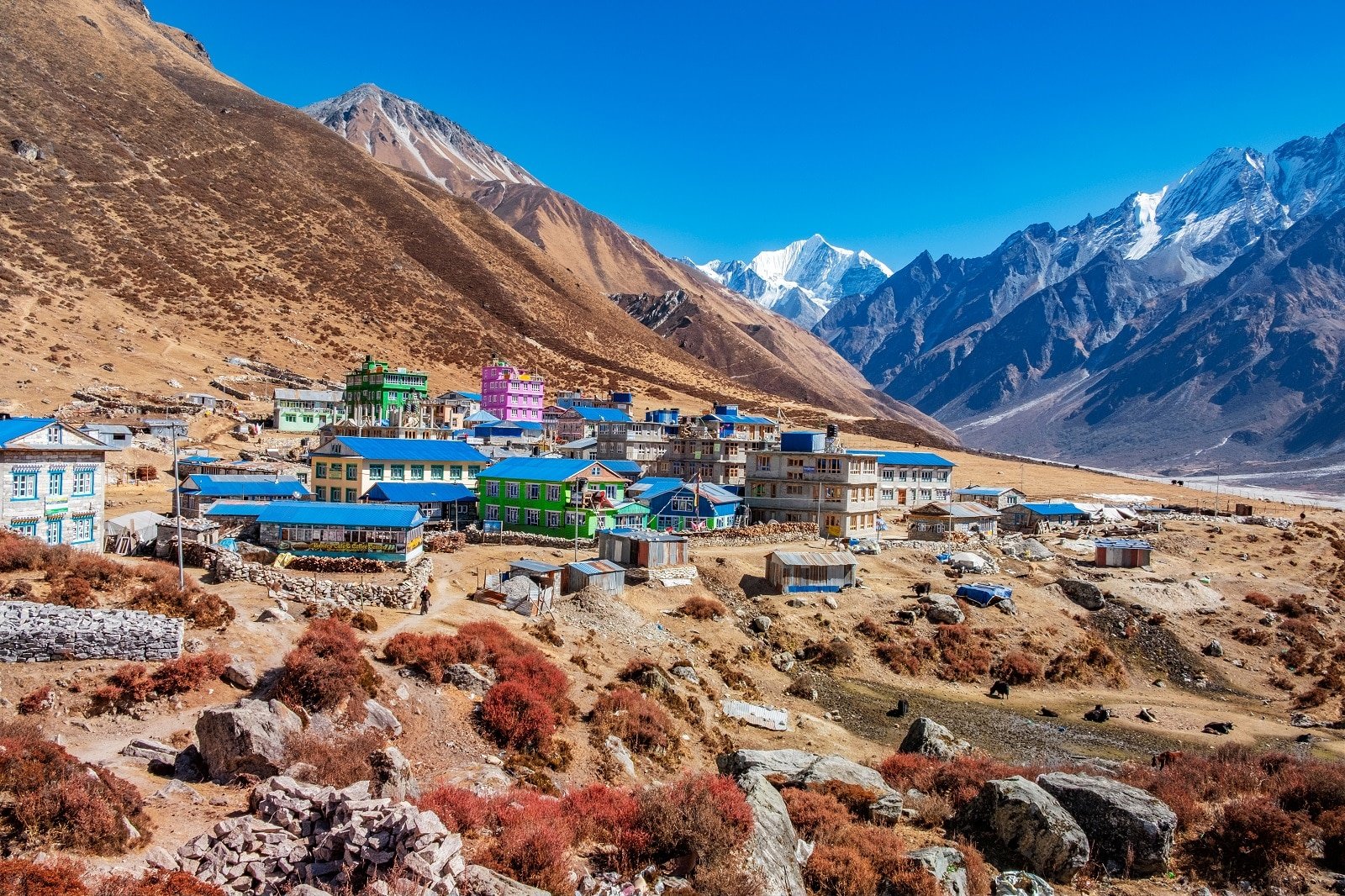
3. Langtang Valley
The Langtang Valley trek offers a quieter, more intimate Himalayan experience. It begins with a drive to Syabrubesi and a trek through forests, pastures, and traditional villages. The valley provides close-up views of Langtang Ri and Langtang Lirung. The trek also includes a visit to Kyanjin Gompa, a significant Buddhist monastery, and an optional climb to Tserko Ri for panoramic mountain vistas. This region was heavily affected by the 2015 earthquake, and trekking here supports local recovery efforts.
Insider’s Tip: Extend your trek to Gosaikunda Lake for a spiritual experience.
When To Travel: March to May and September to November for clear skies and pleasant temperatures.
How To Get There: Drive to Syabrubesi from Kathmandu, the starting point of the trek.
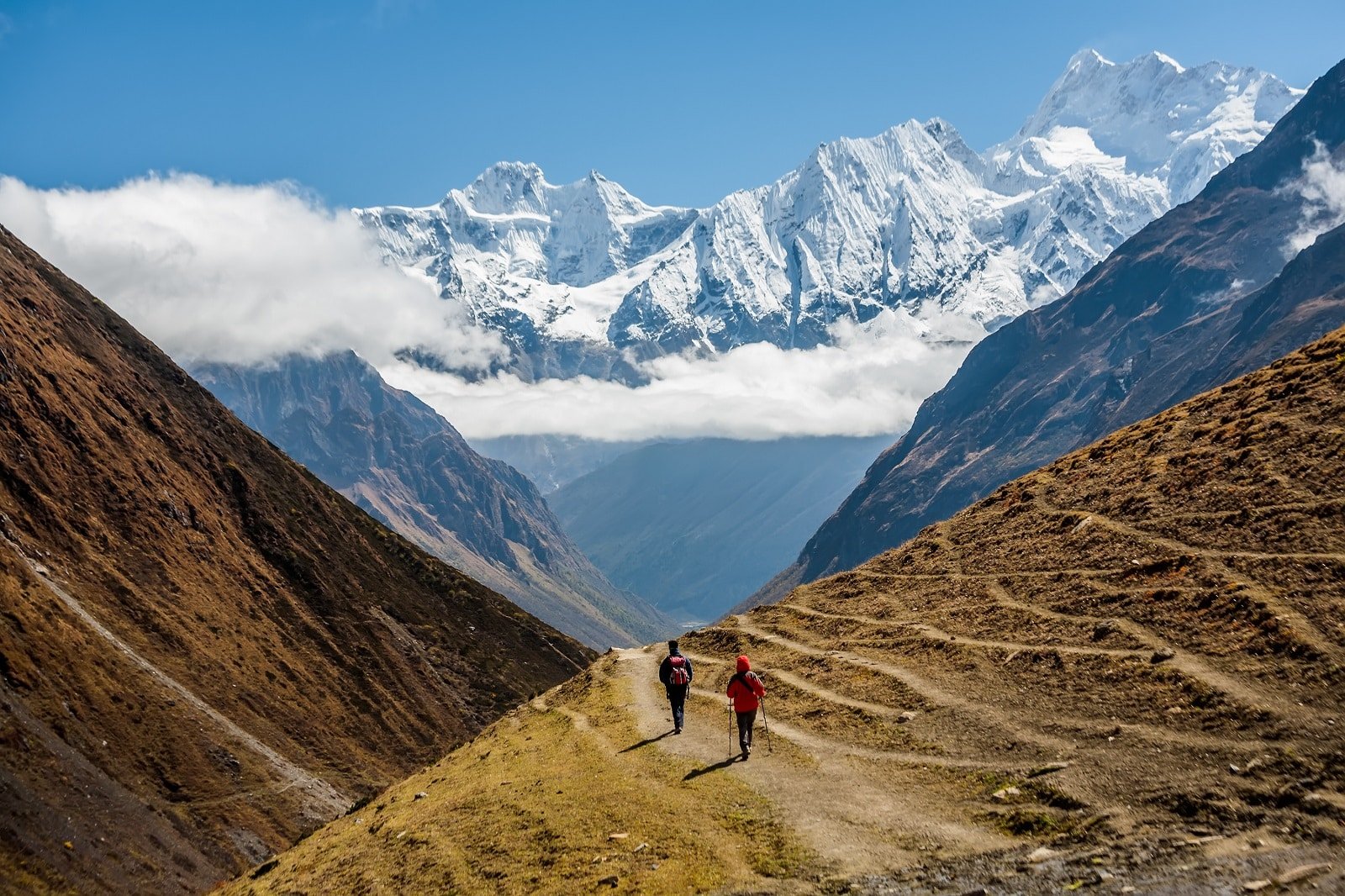
4. Manaslu Circuit
The Manaslu Circuit trek circles the majestic Manaslu, the world’s eighth-highest peak. This trek is less crowded than its more famous counterparts. It offers a look into the untouched natural beauty and culture of the Nepali Himalayas. The trek involves crossing the Larkya La Pass and traverses through Budhi Gandaki Valley, known for its mix of Hindu and Tibetan Buddhist villages. The circuit is a challenging trek, blending cultural richness and scenic splendor.
Insider’s Tip: Ensure you have a guide, as the Manaslu trek requires special permits.
When To Travel: March to May and September to November are ideal.
How To Get There: The trek starts at Arughat or Soti Khola, which can be reached by bus or jeep from Kathmandu.
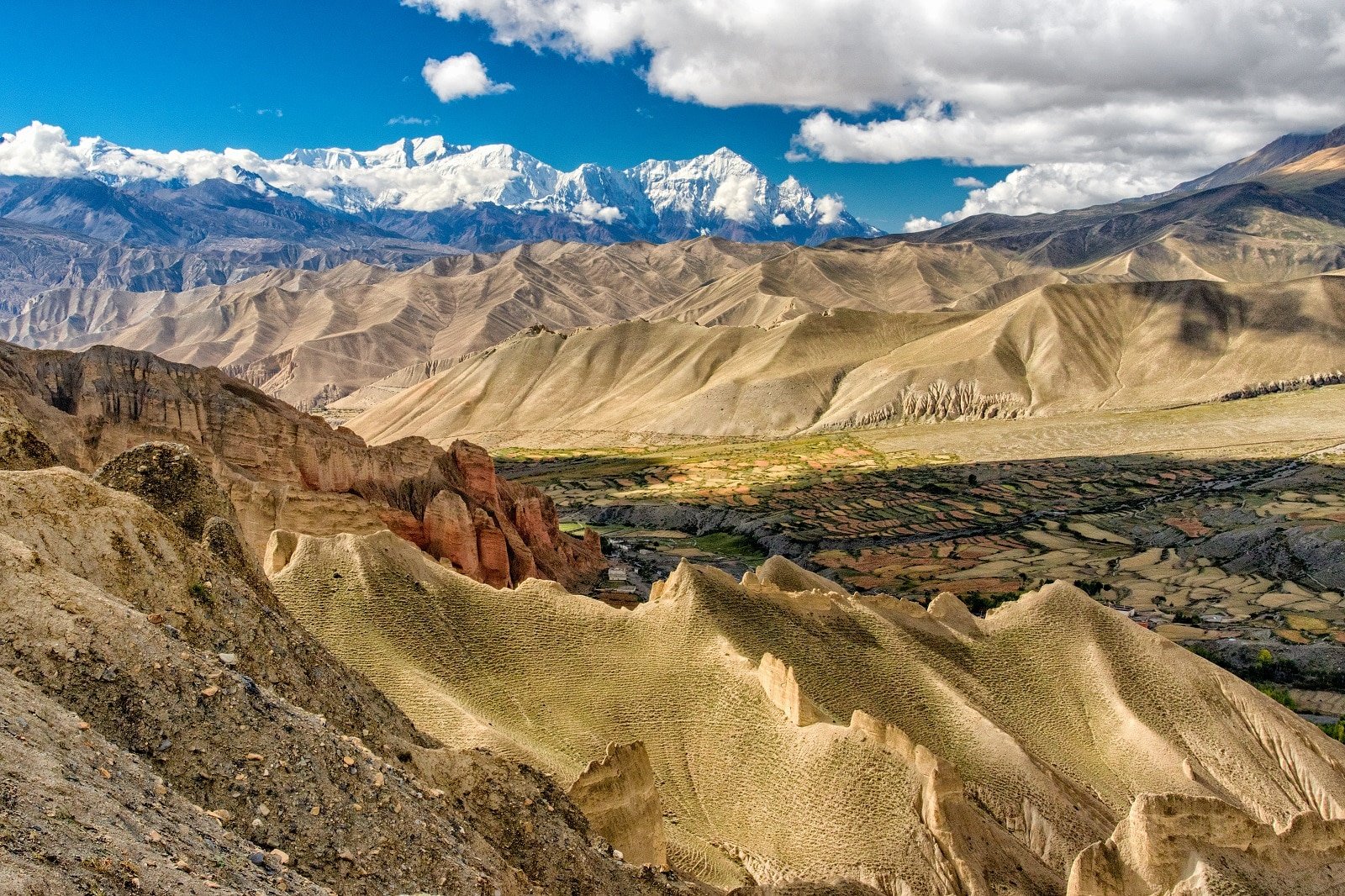
5. Upper Mustang
Trekking in Upper Mustang takes you to a region that was once an independent kingdom. The landscape here is more desert-like, characterized by eroded canyons and colorful stratified rock formations. Lo Manthang, the walled capital, is a highlight, with its monasteries and royal palace. This area is culturally and geographically more akin to Tibet, offering a unique trekking experience distinct from the rest of Nepal.
Insider’s Tip: Visit the ancient monasteries and the royal palace in Lo Manthang. Stay at the beautiful Shinta Mani Mustang.
When To Travel: May to October, as the region lies in the rain shadow area.
How To Get There: Fly or drive to Jomsom, then trek or drive to Lo Manthang.
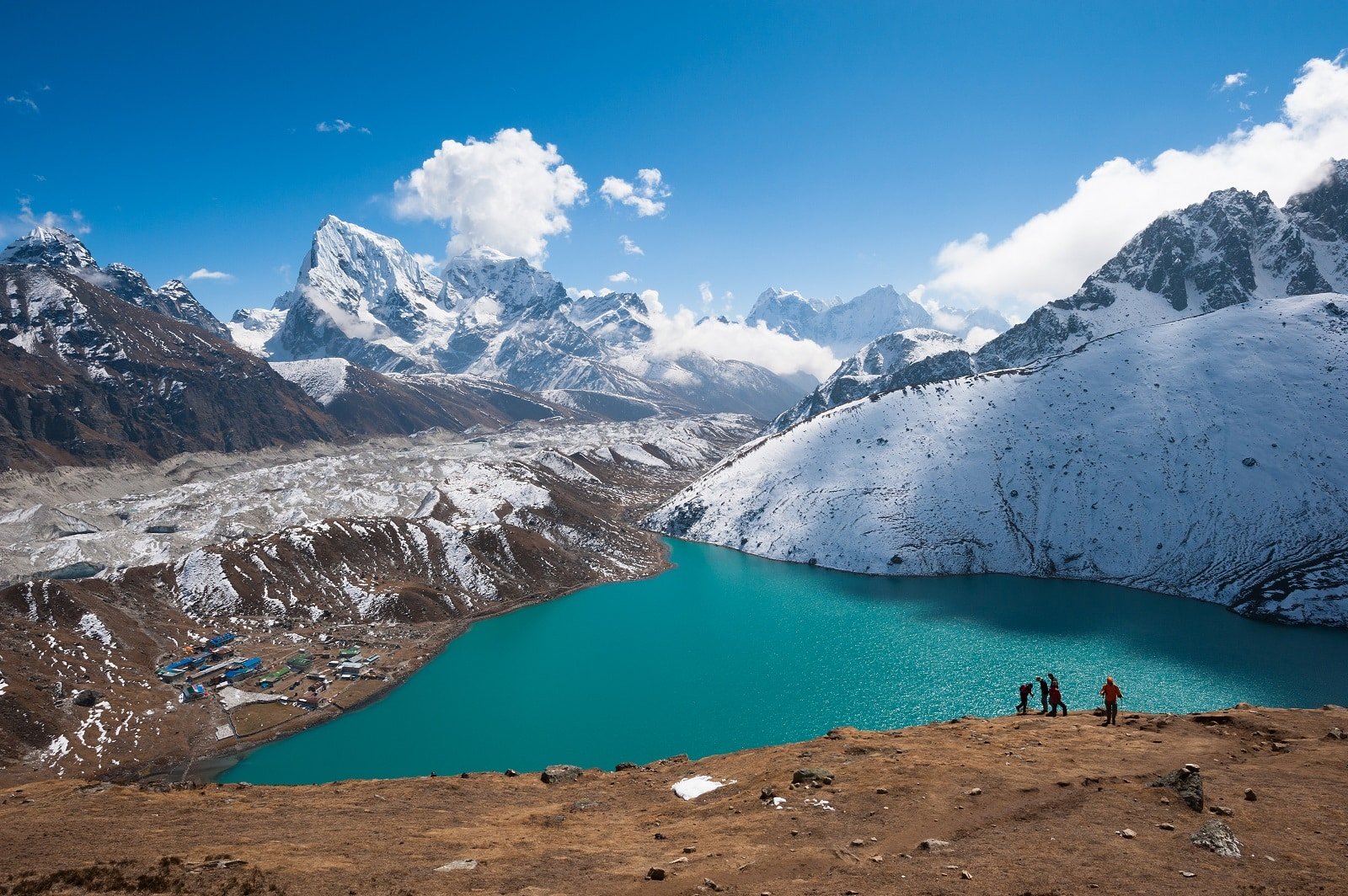
6. Gokyo Lakes
The Gokyo Lakes trek is a fantastic alternative to the Everest Base Camp trek, taking you to a series of stunning high-altitude lakes in the Gokyo Valley. The trek is less crowded and provides spectacular views of Everest and surrounding mountains. Climbing Gokyo Ri offers one of the best viewpoints in the Everest region. The trek passes through Sherpa villages, offering insight into the local culture.
Insider’s Tip: Trek during the full moon for spectacular night views of the mountains.
When To Travel: March to May and September to November for the best weather.
How To Get There: Similar to Everest Base Camp, fly to Lukla and follow a different trail.

7. Poon Hill
The Poon Hill trek is ideal for those looking for a shorter hike in the Annapurna region. It’s known for offering some of the most spectacular mountain views, especially at sunrise from Poon Hill itself. The trek passes through rhododendron forests and Gurung villages, giving you a chance to experience the culture of the central Himalayan region. The trek starts and ends in Nayapul, a short drive from Pokhara.
Insider’s Tip: Carry enough cash, as there are no ATMs on this route.
When To Travel: October to November and March to April for clear skies and good weather.
How To Get There: The trek starts from Nayapul, which is a short drive from Pokhara.
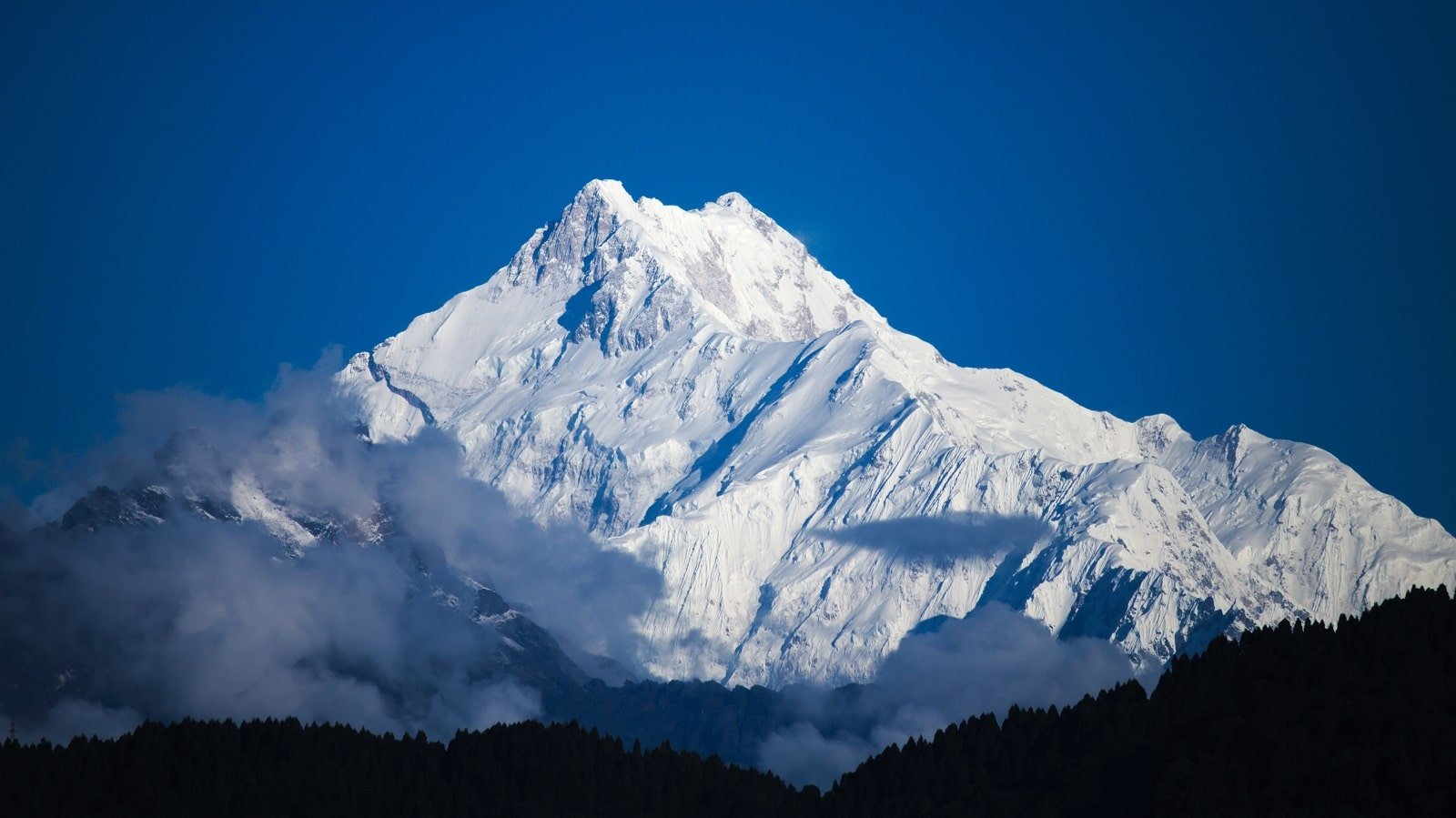
8. Kanchenjunga Base Camp
The Kanchenjunga Base Camp trek is a challenging and adventurous journey to the base of the world’s third-highest mountain. This remote trek offers stunning views of Kanchenjunga and a chance to experience pristine wilderness. The trek passes through diverse ecosystems, traditional villages, and high alpine terrain. It’s a trek for those seeking solitude and unspoiled nature.
Insider’s Tip: Be prepared for basic accommodations and facilities, as this is a less developed trekking route.
When To Travel: March to May and September to November for stable weather.
How To Get There: Fly or drive to Bhadrapur, then drive to Taplejung, the starting point of the trek.
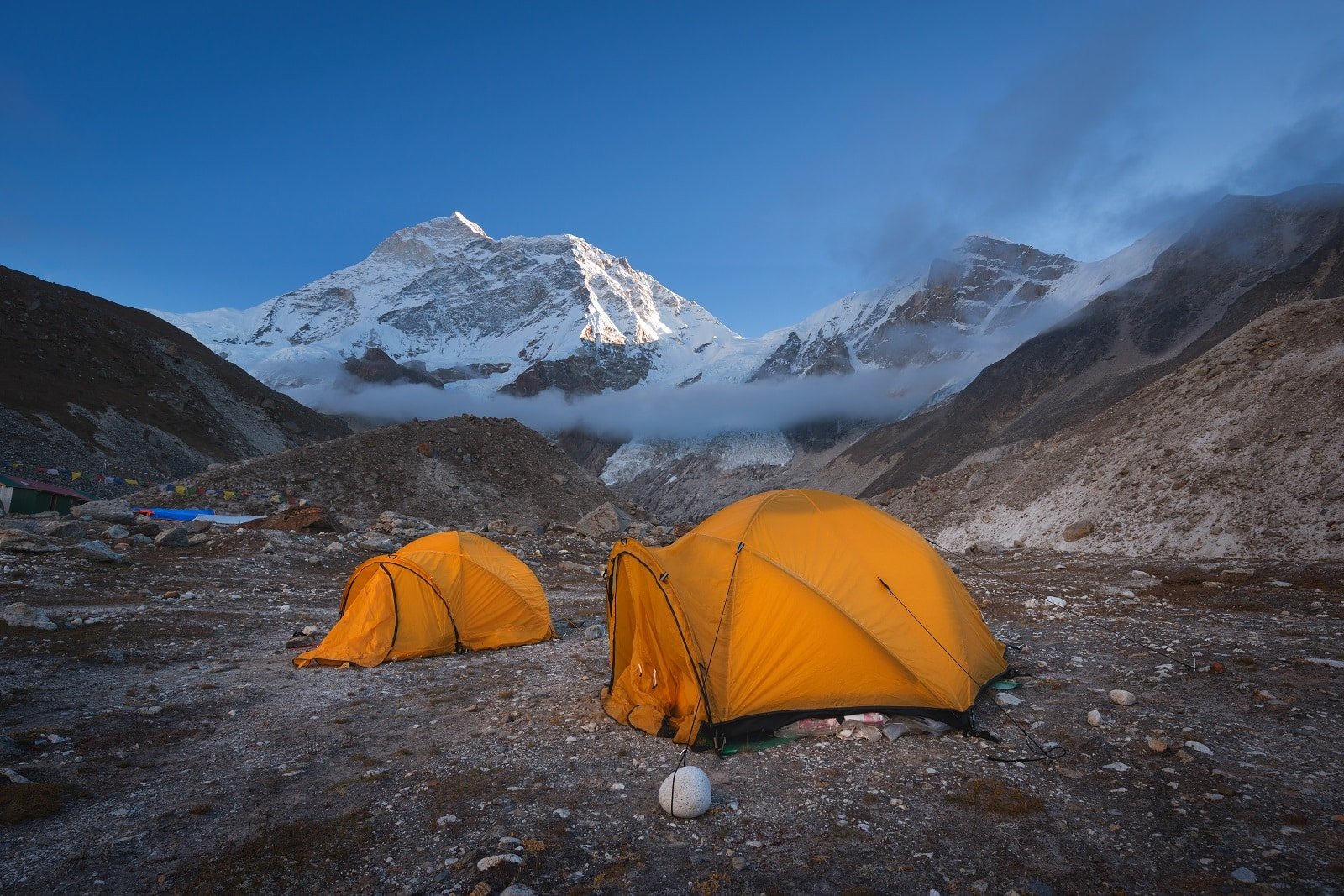
9. Makalu Base Camp
The Makalu Base Camp trek is a challenging journey to the base of Mount Makalu, the world’s fifth-highest mountain. This trek takes you through some of Nepal’s most remote and wild areas, offering stunning views of the eastern Himalayas. The Makalu Barun National Park, through which the trek passes, is a biodiversity hotspot with a rich variety of flora and fauna.
Insider’s Tip: Be physically and mentally prepared for a challenging trek with basic facilities.
When To Trave: Pre-monsoon and post-monsoon periods for the best conditions.
How To Get There: Fly to Tumlingtar from Kathmandu, then drive to Num, the starting point of the trek.
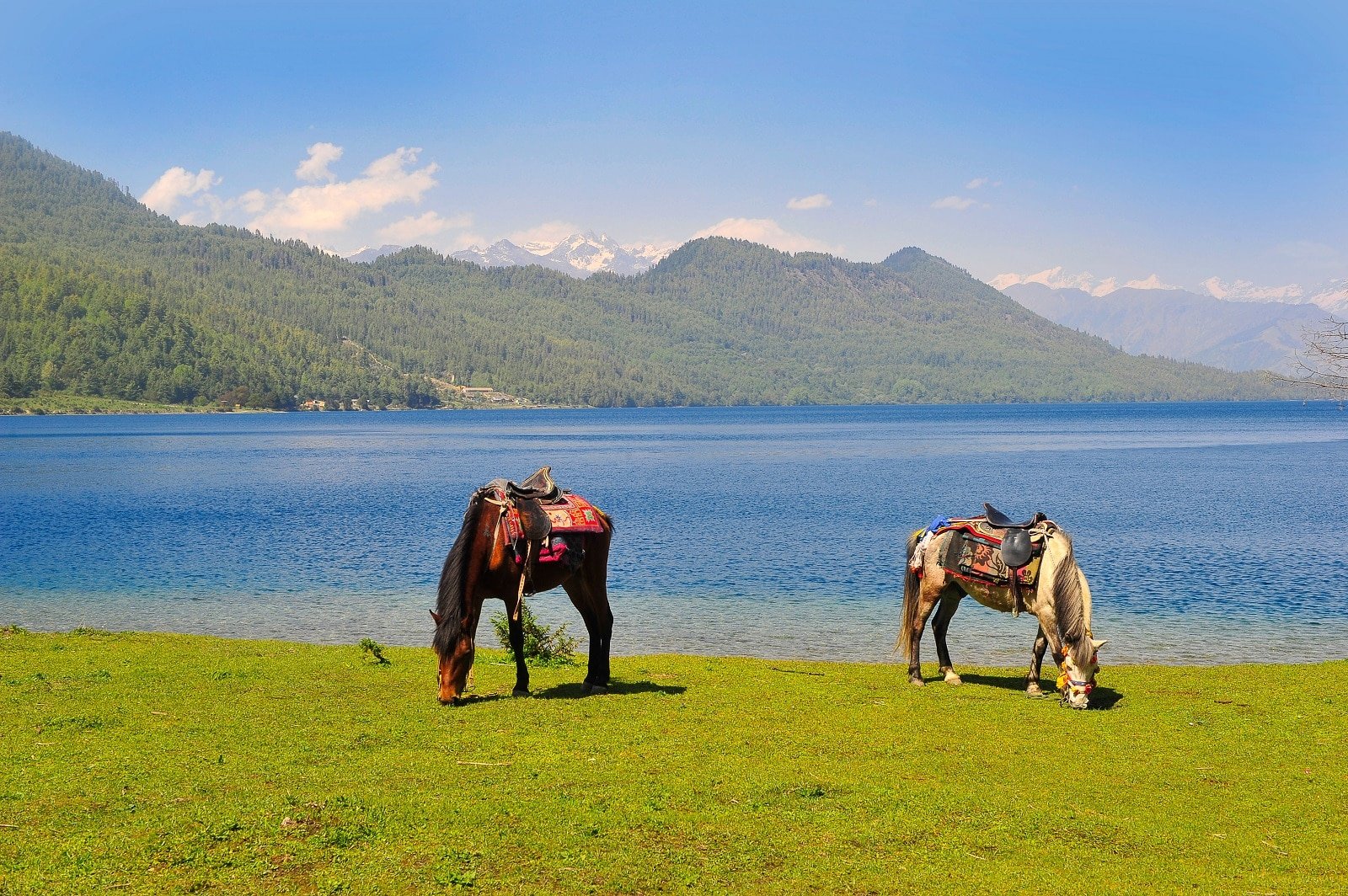
10. Rara Lake
Trekking to Rara Lake offers a serene experience away from the more popular trekking routes. Rara, the largest lake in Nepal, is known for its clear blue waters and scenic beauty. The trek to the lake is an adventure in itself, passing through remote Jumla and Mugu districts. The area around the lake, Rara National Park, is home to a variety of wildlife and offers tranquility unmatched in other parts of Nepal.
Insider’s Tip: Visit the nearby Rara National Park for a chance to see unique wildlife.
When To Travel: September to October and April to May for the best trekking conditions.
How To Get There: Fly to Nepalgunj from Kathmandu, then to Jumla, from where the trek to Rara Lake starts.
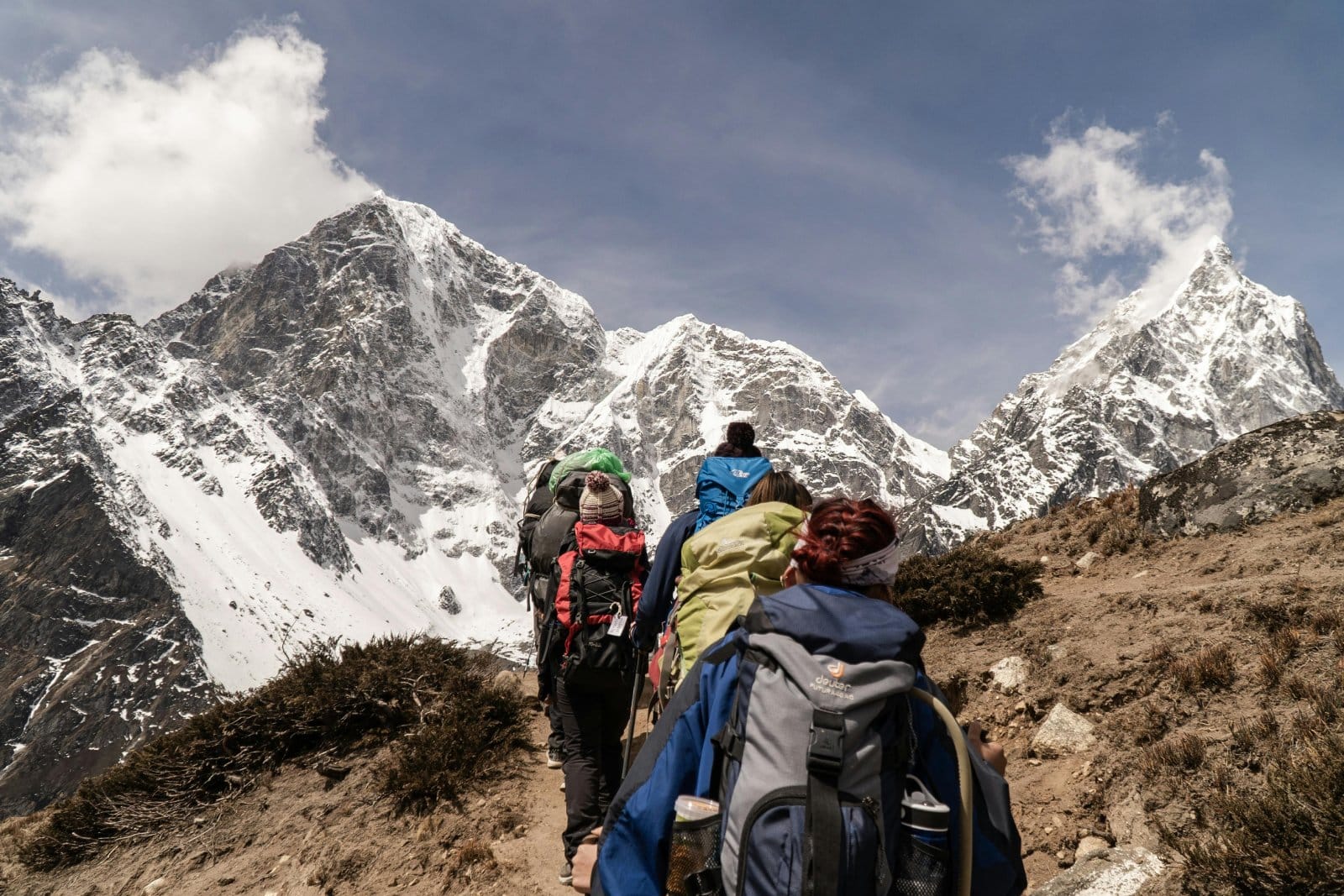
The Bottom Line
Trekking in Nepal is more than a physical journey; it explores some of the most majestic landscapes on Earth. Each destination offers its unique charm, from the world-renowned Everest Base Camp to the tranquil trails of Rara Lake. As you trek through these mountains, you’ll not only witness breathtaking vistas but also immerse yourself in the rich culture and hospitality of the Nepali people. Pack your bags, lace up your boots, and prepare for an adventure that will leave you with memories to last a lifetime.
More Articles Like This…
Barcelona: Discover the Top 10 Beach Clubs
2024 Global City Travel Guide – Your Passport to the World’s Top Destination Cities
Exploring Khao Yai 2024 – A Hidden Gem of Thailand
The post The 10 Best Treks in Nepal’s Majestic Mountains 2024 was republished on Passing Thru with permission from The Green Voyage .
Featured Image Credit: Shutterstock / Olga Danylenko.
For transparency, this content was partly developed with AI assistance and carefully curated by an experienced editor to be informative and ensure accuracy.
More for You
Vietnamese businesswoman sentenced to death in multi-billion dollar fraud case
Famous Roles That 16 Actors Never Want to Play Again
New doc uncovers racism and inappropriate behavior at popular retailer
Doctor shares what happens to our bodies moments before we die
The 10 movies everyone's watching on Netflix right now
Third South Dakota tribal nation bans Noem from reservation
Vladimir Putin says 'just three things' stop Ukraine war ending as he's 'ready for peace'
Michael J. Fox Says ‘We Used to Bust Our Ass' to Be Famous and ‘You Had to Be Talented,' but Now It's: ‘What's That Dance Step? And You're the Most Famous Person in the World'
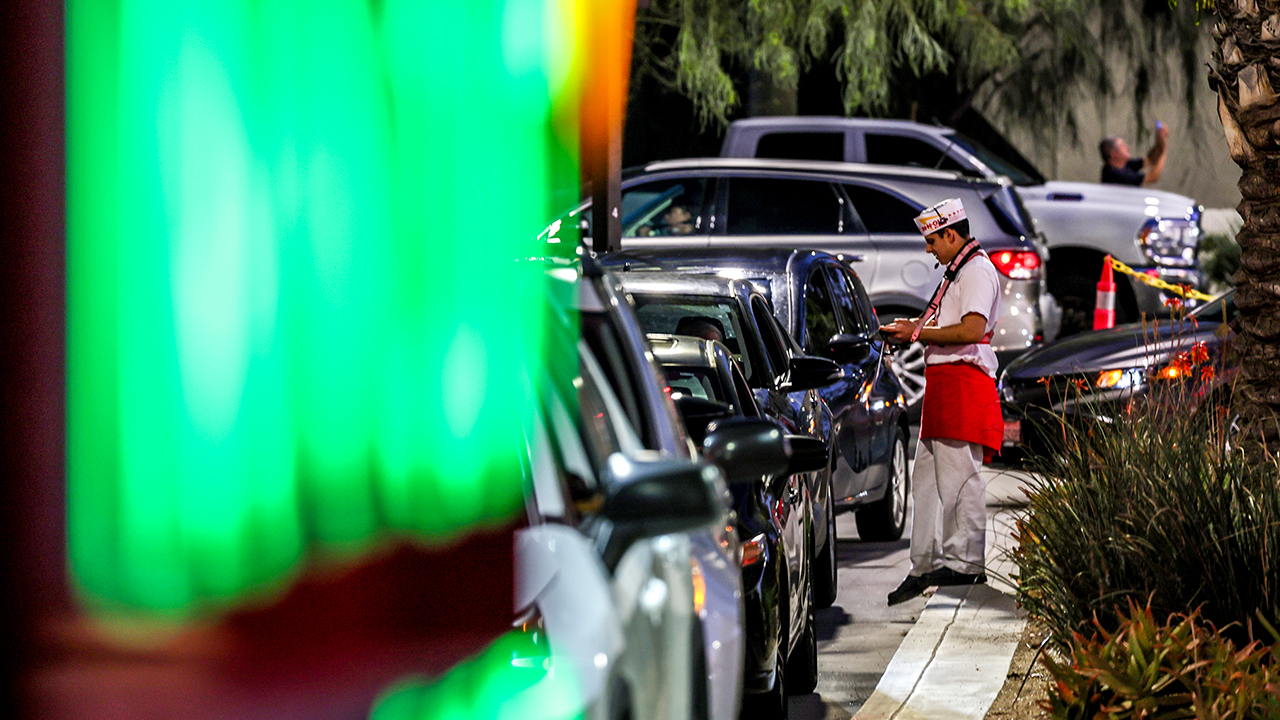
Pizza chain raises prices in California to offset new minimum wage law
Your senses will shut down in a specific order when you’re about to die
Woman with rare syndrome left allergic to ‘everything’ except just four foods
Travis Kelce Chugged a Beer on Stage After Receiving University of Cincinnati Diploma
Mike Pence lands new gig after failed 2024 presidential bid
Family remembers teen who died saving children pulled by strong currents at Florida beach
Renewed and Canceled TV Shows 2024 Guide
Air Force reports on targets destroyed last night
I moved from California to Tennessee for my husband's job. We can finally save money, but it's been a major culture shock.
This type of supplement may increase heart disease risk, new study finds
The 26 Most Dangerous Cities in the U.S. Ranked
Parents who raise successful, resilient kids never do these 5 things, experts say
You are using an outdated browser. Please upgrade your browser to improve your experience.
Temperature
Serdobsk Weather
(Not the location you were looking for? Other matching results or Interactive Map Search )
Time in Serdobsk is Sat 13 th Apr 2:00 am
Serdobsk Current Weather
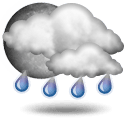
Patchy rain nearby
Feels 10 °c
Sunrise: 05:10 AM
Moonrise: 07:07 AM
Sunset: 06:59 PM
Moonset: 12:37 AM
Illum: 22.6
Serdobsk, Russia Weather This Week
Serdobsk, Russia weather forecasted for the next 10 days will have maximum temperature of 23°c / 74°f on Fri 19. Min temperature will be 3°c / 38°f on Tue 23. Most precipitation falling will be 4.10 mm / 0.16 inch on Mon 15. Windiest day is expected to see wind of up to 36 kmph / 22 mph on Sat 20. Visit 3 Hourly , Hourly and Historical section to get in-depth weather forecast information for Serdobsk, Russia.
Serdobsk, Russia Weather Today and Tomorrow
Serdobsk, russia weather calendar, serdobsk weather meteogram, click on map below to get weather for any location, serdobsk weather video.
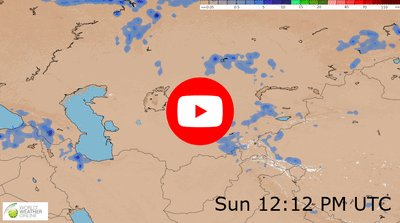
Best months to visit Serdobsk?
June and August are the best month to go for holiday or travel to Serdobsk. The weather averages gathered from Serdobsk weather forecast and Serdobsk weather history also forecast these months temperature to be around 24°c and average of 208.2667 hours of sunshine in a month.
Coldest months of Serdobsk?
January and February are the coldest months with temperature at around -12°c.
Which months receive most rainfall in Serdobsk?
September and June receive most rainfall with precipitation count of 56.21mm.
Travelling to Serdobsk? Check out our Weather averages of Serdobsk to better plan your holiday or travel.
If you would just like to know what the weather was for a past dates for research or education or you are just curious then visit our historical weather of Serdobsk section.
Weather in Serdobsk in April
Temperature hovers around 11°c and at night it feels like 2°c. In April, Serdobsk gets 45.76mm of rain and approximately 6 rainy days in the month. Humidity is close to 72%.
More Popular Destinations
More weather options for serdobsk.
- 14 Day Weather Charts
- Weather Averages
- Free Weather Widgets
- Historical Weather Data
- Buy Historical Weather Data
- Watch Weather Videos »
Serdobsk, Russia Holiday Weather Overview
Pois near serdobsk.
Cities/Towns
Football Stadiums
Global City Weather
Syerdobsk, Penza
Around the globe, hurricane tracker.
Severe Weather
Radar & Maps
News & features.
Wind WNW 7 mph
Air Quality Fair
Wind Gusts 16 mph
Humidity 69%
Indoor Humidity 41% (Ideal Humidity)
Dew Point 44° F
Cloud Cover 100%
Visibility 10 mi
Cloud Ceiling 4700 ft
Wind W 8 mph
Humidity 70%
Dew Point 43° F
Cloud Cover 69%
Cloud Ceiling 3200 ft
Humidity 71%
Indoor Humidity 40% (Ideal Humidity)
Cloud Cover 39%
Visibility 7 mi
Cloud Ceiling 30000 ft
RealFeel Shade™ 48°
Wind WSW 8 mph
Max UV Index 1 Low
Wind Gusts 18 mph
Humidity 72%
Indoor Humidity 39% (Ideal Humidity)
Dew Point 42° F
Cloud Cover 8%
Humidity 68%
Cloud Cover 37%
RealFeel Shade™ 49°
Wind W 9 mph
Max UV Index 2 Low
Wind Gusts 23 mph
Humidity 64%
Indoor Humidity 38% (Ideal Humidity)
Cloud Cover 66%
Cloud Ceiling 29800 ft
RealFeel Shade™ 51°
Humidity 60%
Dew Point 41° F
Cloud Cover 96%
Cloud Ceiling 23400 ft
RealFeel Shade™ 50°
Wind W 10 mph
Wind Gusts 25 mph
Humidity 57%
Indoor Humidity 36% (Slightly Dry)
Dew Point 40° F
Cloud Cover 97%
Wind W 12 mph
Wind Gusts 27 mph
Humidity 54%
Indoor Humidity 33% (Slightly Dry)
Dew Point 38° F
Cloud Cover 98%
Wind Gusts 28 mph
Humidity 52%
Indoor Humidity 31% (Slightly Dry)
Dew Point 37° F
Humidity 47%
Indoor Humidity 30% (Slightly Dry)
Dew Point 35° F
RealFeel Shade™ 53°
Wind WNW 12 mph
Humidity 43%
Indoor Humidity 43% (Slightly Dry)
Dew Point 34° F
RealFeel Shade™ 55°
Wind WNW 10 mph
Humidity 39%
Indoor Humidity 42% (Slightly Dry)
RealFeel Shade™ 54°
Humidity 40%
Dew Point 33° F
Cloud Cover 95%
Wind NW 9 mph
Max UV Index 0 Low
Wind Gusts 21 mph
Humidity 41%
Indoor Humidity 41% (Slightly Dry)
Cloud Cover 91%
Wind NNW 9 mph
Humidity 44%
Cloud Cover 86%
Wind N 8 mph
Wind Gusts 15 mph
Humidity 50%
Cloud Cover 65%
Wind N 6 mph
Wind Gusts 13 mph
Cloud Cover 44%
Wind NNE 6 mph
Wind Gusts 10 mph
Dew Point 36° F
Cloud Cover 23%
Wind NE 5 mph
Wind Gusts 7 mph
Humidity 67%
Cloud Cover 34%
Wind E 5 mph
Wind Gusts 6 mph
Cloud Cover 45%
Further Ahead
Top Stories
Powerful storms unleash severe flooding, tornadoes from Texas to Maine
3 hours ago

Weather Forecasts
Chilly winds to follow storms, flooding rain in eastern US

Severe storms to threaten weekend plans from Midwest to Northeast
7 hours ago

Winter Weather
Mid-April storm to eye California with rain, mountain snow
4 hours ago

Severe weather, tornado threat to build on Plains, Mississippi Valley

Featured Stories
Weather News
How wet weather can be dangerous to your pets

March 2024 hottest on record, EU climate service says

Dog who failed police academy becomes star of Taiwan quake response

One of the world’s highest cities starts rationing water for 9 million...

Six rare sawfish deaths in 7 days have scientists baffled amid bizarre...

Weather Near Syerdobsk:
- Penza , Penza
- Rtishchyevo , Saratov
- Yekatyerinovka , Saratov
We have updated our Privacy Policy and Cookie Policy .
Get AccuWeather alerts as they happen with our browser notifications.
Notifications Enabled
Thanks! We’ll keep you informed.
Wind & weather forecast Serdobsk
Daily forecast, saturday, apr 13, sunday, apr 14, monday, apr 15, tuesday, apr 16, wednesday, apr 17, thursday, apr 18, friday, apr 19, saturday, apr 20, sunday, apr 21, monday, apr 22.
Look at our wind map to find more spots among our 160,000 spots.
Serdobsk popularity
Most popular spots in russia.
Have a look at the top kitesurfing, windsurfing, sailing, surfing or fishing spots in Russia
Additional information
Check the wind forecast for Serdobsk when you search for the best travel destinations for your kiteboarding, windsurfing or sailing vacations in Russia. Or use our wind forecast to find the wind speed today in Serdobsk or to have a look at the wind direction tomorrow at Serdobsk.
Severe Weather Warnings
Serdobsk 7-Day Weather Forecast
Air temperature, °C
Real feel, °C
Average daily temperature, °C
Average wind speed, m/s
Wind gusts, m/s
Wind direction
Birch pollen, points
Grass pollen, points
Ragweed pollen, points
Precipitation in liquid equivalent, mm
Falling snow, cm
Snow depth, cm
Pressure, mmHg
Relative humidity, %
UV Index, points
Geomagnetic activity, Kp-index
- Getting Results.
- Newsletters
BREAKING NEWS
Florida woman missing after brazen carjacking near Winter Springs believed dead
Strong storms trek through florida, spawning tornado. here’s what comes next, twister near world golf village; sr-a1a washed out in flagler.
Tom Sorrells , Chief meteorologist
Thursday was a Weather Alert Day in Florida as a cold front brought rain, lightning, storms and at least one tornado to the Sunshine State.
A tornado watch , meaning conditions were favorable for the development of severe storms and tornadoes, was issued for Central Florida but expired at 3 p.m.
Recommended Videos
A confirmed tornado that damaged homes in St. Johns County, just north of Central Florida, was captured on video . No injuries were reported.
In Flagler Beach, police say torrential rain washed out a portion of State Road A1A , prompting a temporary lane closure as crews work to assess and repair the damage.
As the front moved southeast, there were gusty winds of 50-60 mph, lightning and locally heavy rainfall across the Orlando area.
By sunset, the activity will taper off as the front progresses south across the region.
Winds could stay very gusty through Thursday evening.
Looking ahead to Friday and Saturday, winds will diminish and shift west-northwest as the cold front moves offshore.
By Saturday, winds will veer northeast, with gusts up to 25 mph as high pressure builds over the Deep South.
Expect sunny skies, with high temperatures ranging from the mid-70s to low 80s along the coast and low to mid-80s west of I-95.
Overnight lows will dip into the upper 50s to mid-60s on Friday and the mid-50s to low 60s on Saturday.
Copyright 2024 by WKMG ClickOrlando - All rights reserved.
About the Author
Tom sorrells.
Tom Sorrells is News 6's Emmy award winning chief meteorologist. He pinpoints storms across Central Florida to keep residents safe from dangerous weather conditions.
RELATED STORIES
Your duke energy bill could dip in june. here’s why, dogs alert homeowner to 11-foot, 500-pound gator in florida backyard, central florida warms into upper 80s. threatening storms on the way, 1 dead, 3 wounded in shooting near orange county apartment complex, woman, car missing after apparent carjacking at winter springs intersection, video shows possible carjacking at winter springs intersection, video shows shooting in ocoee parking lot, orlando chapter of zeta phi beta, inc to host bingo for handbags.
See how the eclipse transformed America, city by city

For weeks, if not months, those who have seen one repeated to anyone who would listen: There’s nothing like experiencing the totality of a solar eclipse.
For some of them, this was a second time in six and a half years experiencing the eerie calm when the moon passes in front of the sun, at least for a few minutes. And yet, they were just as awestruck.
For others, it was a likely last opportunity to witness such a celestial phenomenon for two decades. It inspired gasps and smiles, solemnity and excitement.
Here is how it looked as the moon’s shadow crossed three countries and 13 U.S. states, with the time of totality in Eastern time.
El Salto, MX
2:10 — 2:14 p.m.
Uvalde, tex., 2:29 — 2:33 p.m., russellville, ark., 2:50 — 2:54 p.m., carbondale, ill., 2:59 — 3:03 p.m., bloomington, ind., 3:04 — 3:08 p.m., tiffin, ohio, 3:11 — 3:15 p.m., littleton, maine, 3:32 — 3:35 p.m..

Time of totality
El salto, mexico.
A group of professors and students traveled from the United States to El Salto to conduct the most thorough experiment ever using an eclipse to test Albert Einstein’s theory of relativity. Einstein’s idea held that the massive sun would bend the light of surrounding stars more than previously estimated, proving that matter can pull and warp space and time.
The researchers used five telescopes to measure that effect more closely than ever, measuring stars that appear so close to the sun’s edge they can only be viewed during an eclipse.
After a countdown in Spanish, the sun darkened, and the data collection began. “TOTALITY,” yelled Sam Jeffe, a third-year physics major at Willamette University as it appeared in the telescopes’ lenses. “And it’s clear!”
Researchers will feed the data into the computer program, which will analyze the position of the stars and determine how the sun bent the light around them. But, for now, more than half the battle was done.

2:27 — 2:31 p.m.
Eagle pass, tex..
On U.S. soil, totality first came into view in the border city of Eagle Pass, Tex., where a crowd gathered at a football field erupted into cheers as the skies darkened above them.
A singer crooned, “I’m walking on sunshine!” People put on protective glasses and craned their necks toward the sky. Many began to clap.
Vita Garza Flores, 76, traveled from Northern California to see the eclipse in the city where she was born. She brought her daughter and brother along with her.
She grabbed her eclipse glasses, positioning them across her sunglasses: “Wow!”

Students from Uvalde High School were also among the citizen scientists using the eclipse to learn more about the sun and its effects on Earth.
They joined Southwest Texas Junior College’s STEM club in participating in a program known as the Citizen Continental-America Telescope Eclipse. Called Citizen CATE, it will combine short videos of the eclipse taken via telescope into an hour-long movie that NASA says will detail magnetic structure within the sun’s corona and reveal its density. That will help scientists to measure the strength of the solar wind — charged particles that can disrupt electricity grids and produce auroras when they reach Earth.

In Russellville, NASA gathered scientists and broadcast the eclipse’s progress live online. Tourists gathered there, too, wearing T-shirts that declared, “I got mooned at the eclipse.”
A jazz band from Arkansas Tech University played. NASA hosted workshops and Q&A sessions with scientists, at least one of whom has been to space: Among the visitors were Mike Massimino, a veteran of NASA space flight missions to upgrade the Hubble Space Telescope in 2002 and 2009.

Carbondale, Ill., earned the title of “eclipse crossroads of America,” having fallen in the path of totality for a 2017 solar eclipse as well as the event on Monday. This time, at least, the skies were clear for totality, and a full stadium of eclipse fans burst into collective screams when the moment came.
“This is so much better than 2017,” a one commentator on NASA’s live broadcast noted. “It’s so much darker than 2017.”

To many of those who experienced it, the eclipse was a spiritual event. In Bloomington, Buddhist monks marked it with a puja ceremony, a “ritual honoring and promoting inner and planetary healing,” according to the Tibetan Mongolian Buddhist Cultural Center.
Eclipse watchers flocked to Yellowwood Lake where they could experience the eclipse in nature.

When the last pulses of the sun’s rays make their way to Earth before an eclipse enters totality, they appear like a brilliant diamond set on a golden ring. In Tiffin, that meant a chance for some “unforgettable” weddings at an event called “Elope at the Eclipse.”

3:18 — 3:21 p.m.
Niagara falls, n.y..
Crowds flocked to landmarks across the path of totality for a memorable view. At Niagara Falls, despite a thick blanket of clouds, people gathered on the banks of the Niagara River and trained their phone cameras toward the sky. Streetlights turned on, if only briefly, when darkness descended.

The moon’s shadow reached North America at the beaches of Mazatlan, Mexico, just after 2:07 p.m. Eastern time. Just about 90 minutes later, it crossed the wilderness of northern Maine, on its way toward Canada, and then, the North Atlantic.
A total solar eclipse will next dim communities in the contiguous United States in 2044, but only in parts of Montana and the Dakotas. The country will have to wait one more year for the next coast-to-coast phenomenon, a total eclipse that will stretch from California to Florida on Aug. 12, 2045. It will be a Saturday.
About this story
Design and development by Stephanie Hays. Photo editing by Olivier Laurent. Design editing by Chloe Meister and Matt Callahan. Text editing by Katie Zezima. Graphics by Emily Eng. Video editing by John Farrell and Josh Carroll. Text by Scott Dance, Kasha Patel, Arelis R. Hernández and Joel Achenbach.
69-year-old man charged in death of beloved ‘Star Trek’ tour guide
MILTON, N.Y. (WRGB) – A 69-year-old man is facing manslaughter charges in the case of a missing New York man.
Friends of the victim, identified as Thomas Krider, said he was a beloved character in the “Star Trek” and entertainment community.
Ronald Rayher was arrested and arraigned on charges of manslaughter in the second degree and tampering with physical evidence.

Court documents said Rayher moved and hid personal effects belonging to Krider from the scene after his death.
Police in New York reported Krider missing on April 6.
The 40-year-old victim, also known as T.J. Green, was an employee and tour guide at the “Star Trek” set tour in Ticonderoga.
James Crawley, a friend of the victim, said Krider was also a talented Elvis Presley tribute artist and “he will be remembered for his kind and trusting soul and his warm, friendly demeanor.”
“We are devastated by his loss and will keep him close to our hearts,” Crawley said.
Rayher is being held on a $250,000 bond. He is due back in court on May 21.
Copyright 2024 WRGB via CNN Newsource. All rights reserved.

Rapides Parish woman dies in storm-related incident from April 10 storms

Pedestrian killed in Avoyelles Parish crash

GPSO: Arrests made in connection with death of James Ingram

Woman, 85, shoots and kills home intruder in ‘heroic’ act of self-defense

O. J. Simpson dies at age 76, family says
Latest news.

Correctional lieutenant arrested in Avoyelles Parish

Judge declines to delay Trump’s NY hush money trial over complaints of pretrial publicity

Student arrested after sending fax claiming to be the principal resigning, reports say

RADE Agents make arrests; recover fentanyl and body armor

‘He thought it was hilarious’: Truck driver injured after turkey smashes through windshield

IMAGES
COMMENTS
Weather report for Everest Base Camp. Overnight into Wednesday a few clouds are expected, the sky clears on Wednesday morning. For the afternoon it is mostly cloudy. It is a sunny day. Temperature highs are likely to reach 14 °F. With UV-Index rising to 11, sun protection is strongly recommended. Overnight into Wednesday light air is ...
Everest Base Camp weather and temperature in October. Temperature: The temperature ranges around 10°C to 20°C. Estimated hours of daylight: In October, the average daylight hour is 8 to 9 per day. Wind: The average daily wind speed in October is around 8-11 km/hr (around 5-7 mph). The humidity is high as well.
Everest Base Camp Trek - Temperature - month-wise. January: During the day, temperatures usually range between -20°C to -10°C ( -4°F to 14°F). At night, temperatures can drop to around -25°C (-13°F) or even lower. February: Daytime temperatures generally range between -15°C to -5°C (5°F to 23°F).
Wet weather can make the trek from Tingri to EBC a little harder. The best time to trek to EBC is from April to May and September to October. For those that are traveling on a budget, the winter months are actually the best time to travel, as the cost of the tours is cheaper.
Temperature Variability as You Ascend. As you make your way up the EBC trail, the temperature decreases by about 6°C for every 1,000 meters you ascend. So, if you start your trek in Lukla, which is at an altitude of 2,860 meters, and you're aiming for Everest Base Camp at 5,364 meters, you're looking at a significant temperature drop.
Everest Base Camp Weather. Temperatures on the Mt Everest Base Camp Trek can range from 5 °C (40 °F) to 20 °C (70 °F) depending on month, and as low as -30 °C (-22 °F) at night during the winter months. If you trek during the warmer months (Mar-May and Sep-Oct), the cold is not a big problem and shouldn't be hard to cope with.
The minimum average daytime temperature during the Everest Base Camp Trek during April ranges from 20 to 22 C above the 4,000 meters elevation, while the temperature drops down to about 5 to 7 C at nighttime. There isn't much rainfall, with average precipitation ranging to about 20 mm at destinations like Namche Bazaar.
Everest Base Camp Trek Weather and Temperature in November. Temperature during the day: -10°C to 0°C (14°F to 32°F) Night temperature: -15°C to 5°C (5°F to 32°F) Daily sunshine hour: 8. Humidity: Low with a dry and pleasant climate. Wind speed: Moderate (around 5300m) November is the final month of the autumn season.
Weather. Although being just a few weeks away from the start of the monsoon in June, the weather in the Everest region in May is still favorable for trekking. Temperatures are slightly warmer than in April (with an average high of 57°F/14°C in Namche Bazaar) and rainfall slightly higher but still low.Later in the month in particular, humidity in the build-up to monsoon may obscure the ...
EBC Trek Weather in Winter - December to February . Everest Basecamp Trek in winter registers a minimum of-17°C. The temperature remains low throughout the day, and the number declines to minus. The winter months of December, January and February are the coldest to trek to the EBC.
The Everest Base Camp trek's best time is during the autumn and spring seasons on the basis of ideal weather. Also Read: Everest Base Camp Trek Tips - 10 Actionable Tips. Best Season for Everest Base Camp Trekking. Each season is different with unique features and challenges that add up to your adventure. You can trek in any season on your ...
This chart shows the 14 day weather trend for Everest Base Camp (Tibet, China) with daily weather symbols, minimum and maximum temperatures, precipitation amount and probability. The deviance is coloured within the temperature graph. The stronger the ups and downs, the more uncertain the forecast will be. The thick line represents the most ...
Everest Base Camp Trek Temperature in September. September is the beginning of autumn and the end of the summer season in Nepal. During this season, there will be unpredictable weather. In most cases, the temperature will be 15 degrees Celsius during the day and 2 degrees Celsius a night in the Everest Region of Nepal.
Trekking to Everest Base Camp in May month is one of the best time visits. All trekkers and travel wish to do this adventure trip in Nepal Himalaya in good weather conditions, March, April, May month (spring) is popular month for the trek in Everest Base Camp ( or Everest Base Camp Trek in May). Temperatures are generally warm at lower elevations and at the higher elevations over 4,000m ...
Everest Base Camp Trek Weather in this EBC trekking blog, we'll talk about Everest Base Camp weather with changes in seasons. Technically speaking, the beauty of the Everest Base camp doesn't get hindered by the season. It's good to trek in all of the season, however, some merits and demerits come along the way. ...
The iconic Everest Base Camp Trek leads you through the Khumbu Valley, allowing you to experience the immense beauty of the surrounding Sagarmatha National Park while simultaneously providing breath-taking vistas of 4 of the 6 highest peaks in the world - My. Everest (8.848m), Mt. Lhotse (8,516 meters), Mt. Makalu (8,470 meters) and Cho Oyu (8,201 meters).
Weather. It is not a month for rain, meaning a very good chance to have beautiful weather and can able to see a clear mountain view along with your trekking to Mt. Everest base camp at 5,364m | 17,593ft. March month s just being the transition from the winter season to spring and will be very fresh weather condition and still, some major trek ...
The Everest base camp weather in April is the perfect weather condition, where you can have the opportunity to experience the higher landscape at its colourful forests, wildflowers as well as an outstanding view of the snow-capped mountains. This makes your trek more adventurous and memorable.
Everest base camp trek Weather and Temperature by Months. Mt. Everest and Nupse view from Kalapathar. The weather and temperature during the Everest Base Camp trek can vary greatly depending on the time of year you choose to go. The trekking season in the Everest region is generally divided into two main seasons: the pre-monsoon (spring) season ...
From the iconic Everest Base Camp to the serene trails of the Annapurna region, Nepal's mountains offer a diverse array of trekking experiences, each more awe-inspiring than the last.
Get the latest weather forecast in Serdobsk, Penza, Russia for today, tomorrow, long range weather and the next 14 days, with accurate temperature, feels like and humidity levels. Realtime weather, 14 day weather forecast, annual weather averages, past weather at Serdobsk Weather. Home API HWD World Sports Holiday.
Get the Syerdobsk, Penza, Russia local hourly forecast including temperature, RealFeel, and chance of precipitation. Everything you need to be ready to step out prepared.
This is the wind, wave and weather forecast for Serdobsk in Penza Oblast, Russia. Windfinder specializes in wind, waves, tides and weather reports & forecasts for wind related sports like kitesurfing, windsurfing, surfing, sailing, fishing or paragliding. Forecast This forecast is based on the GFS model. Forecasts are available worldwide.
Weather in Serdobsk for a week, 7 days weather forecast for Serdobsk, Serdobsky district, Penza Oblast, Russia. View the mobile version. Search for location. Russia / Penza Oblast / Serdobsky district. in Serdobsk mainly cloudy, no precipitation, −5 °C. Now Today Tomorrow 3 days Weekend.
Thursday was a Weather Alert Day in Florida as a cold front brought rain, lightning, storms and at least one tornado to the Sunshine State.. A tornado watch, meaning conditions were favorable for ...
Here is how it looked as the moon's shadow crossed three countries and 13 U.S. states, with the time of totality in Eastern time.
MILTON, N.Y. (WRGB) - A 69-year-old man is facing manslaughter charges in the case of a missing New York man. Friends of the victim, identified as Thomas Krider, said he was a beloved character ...